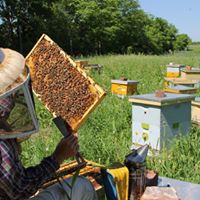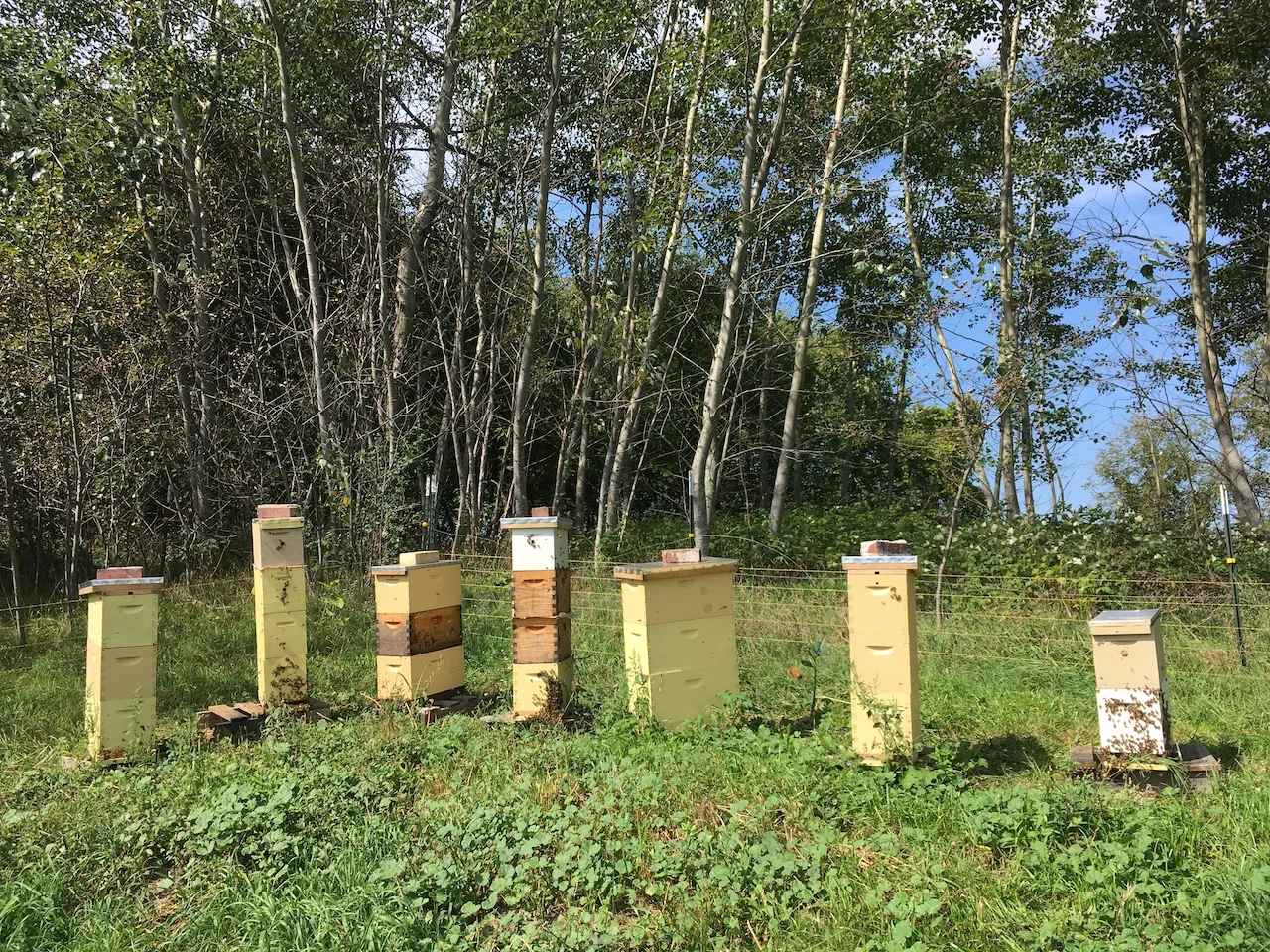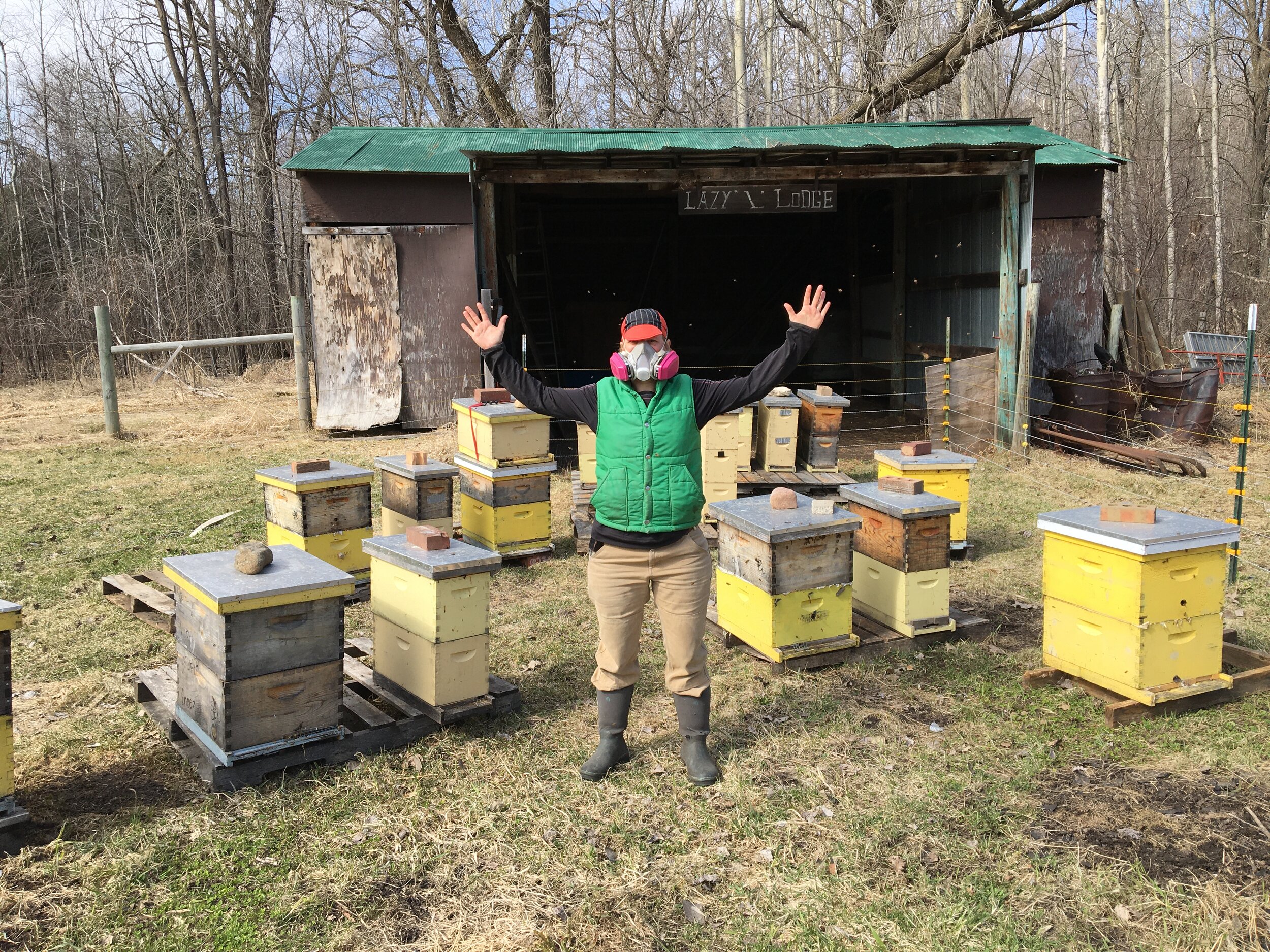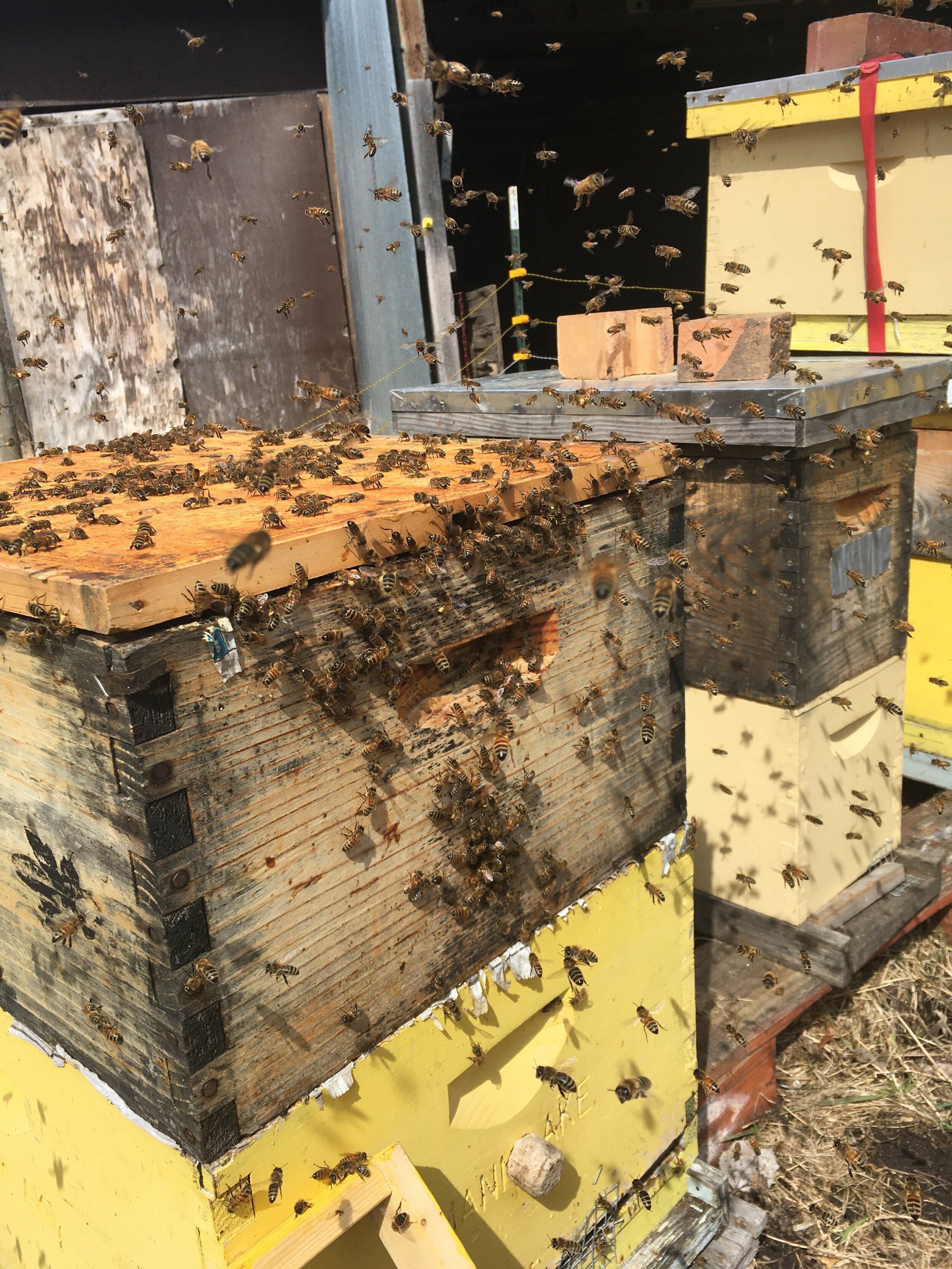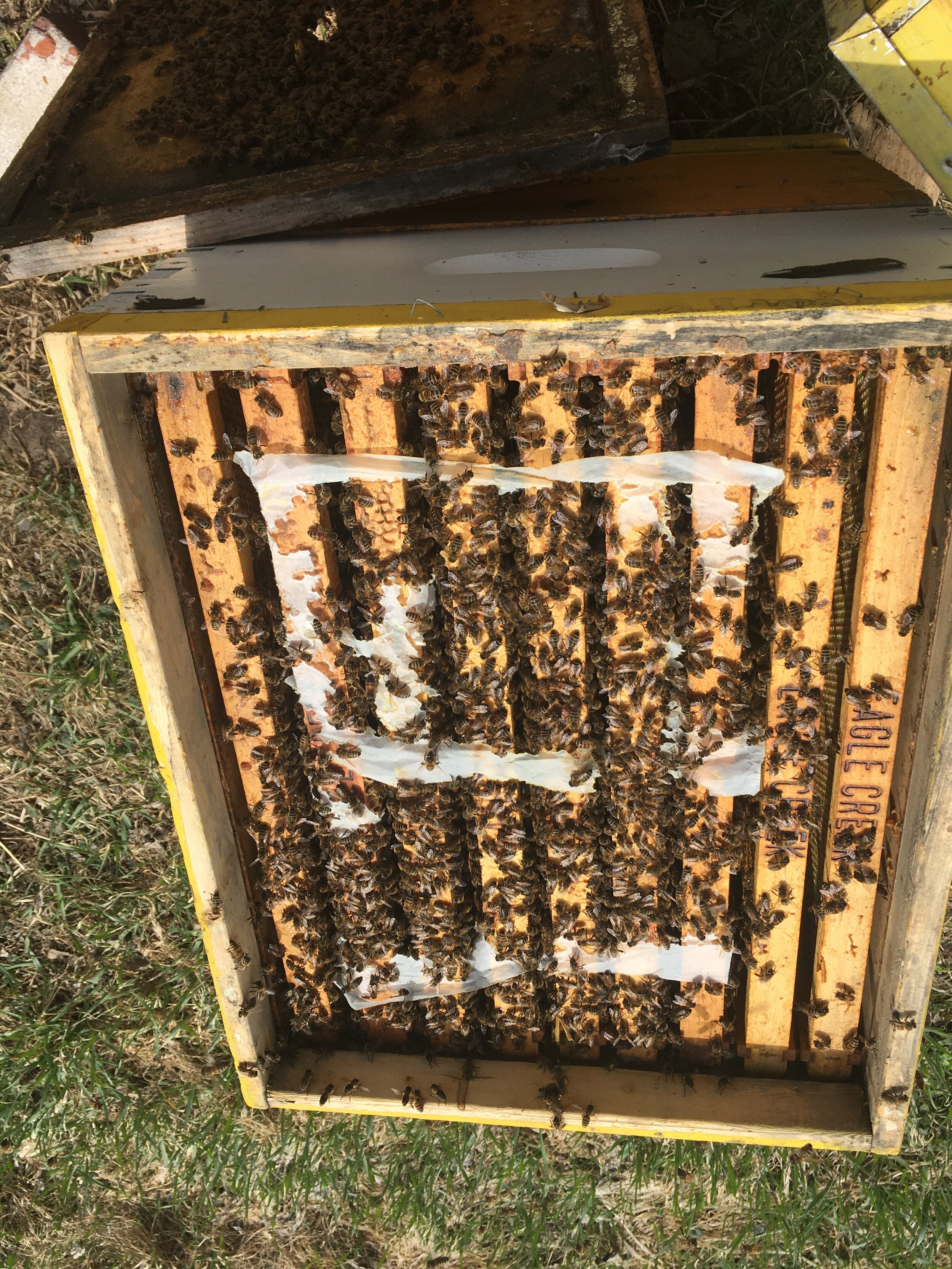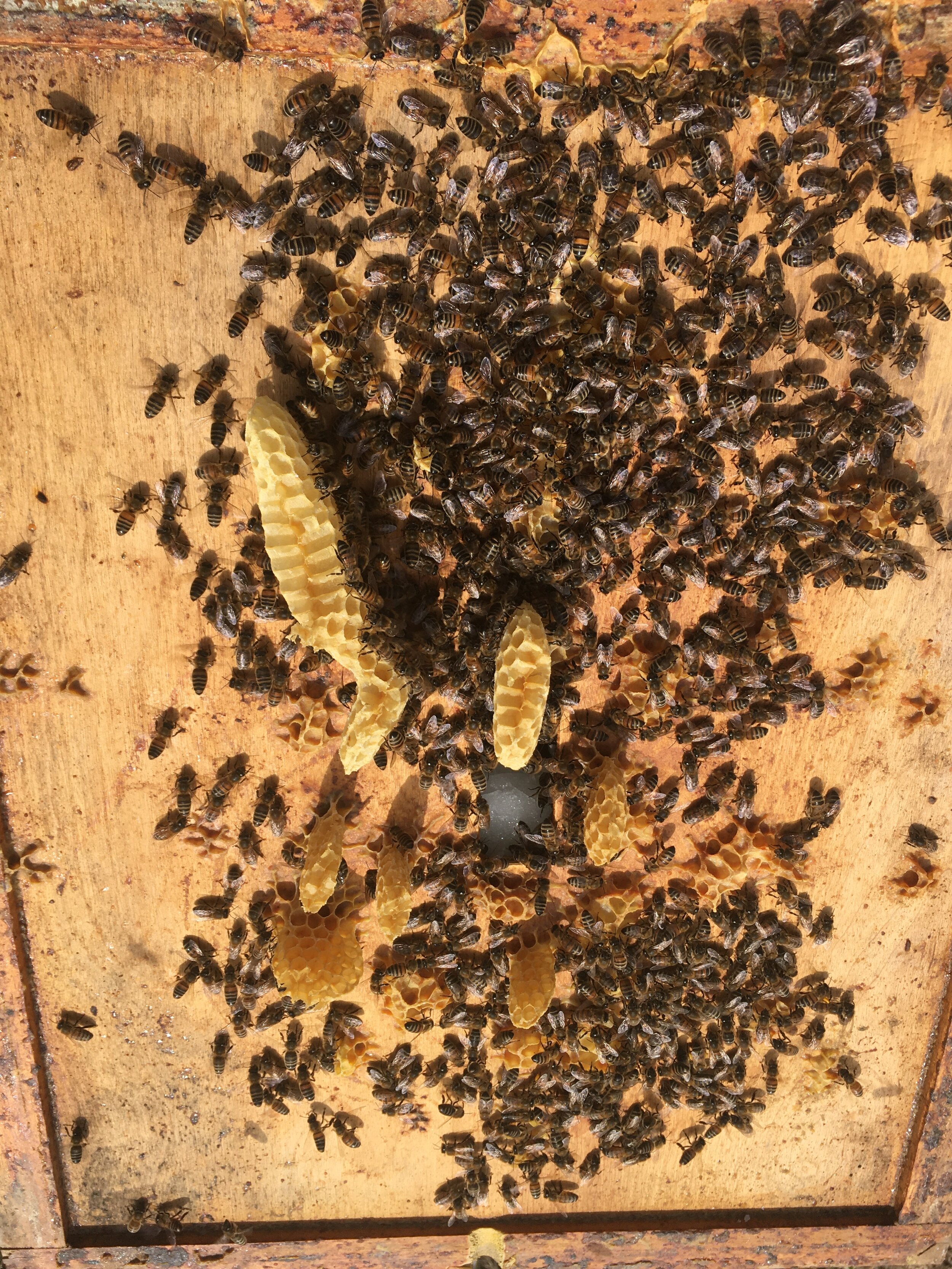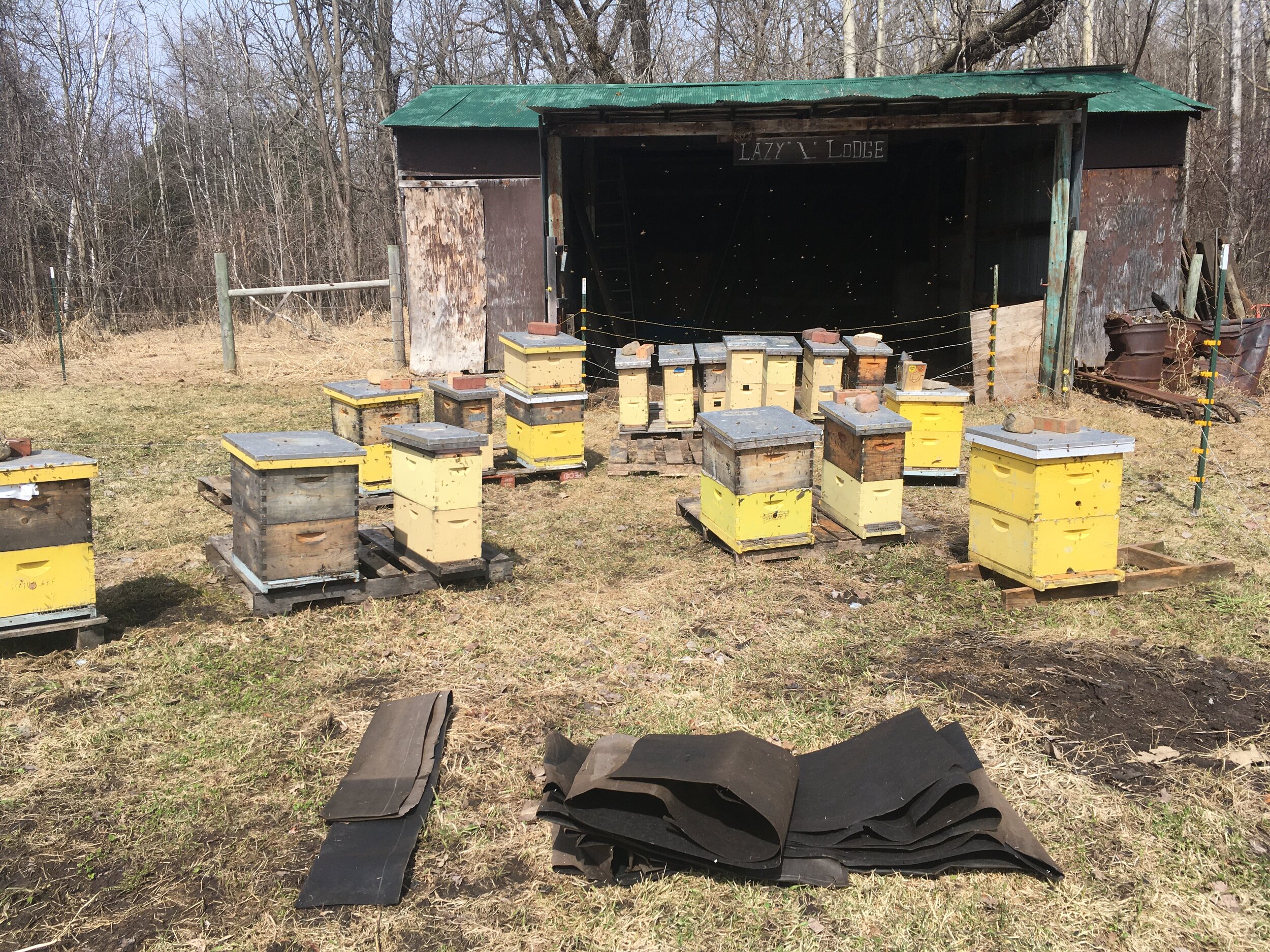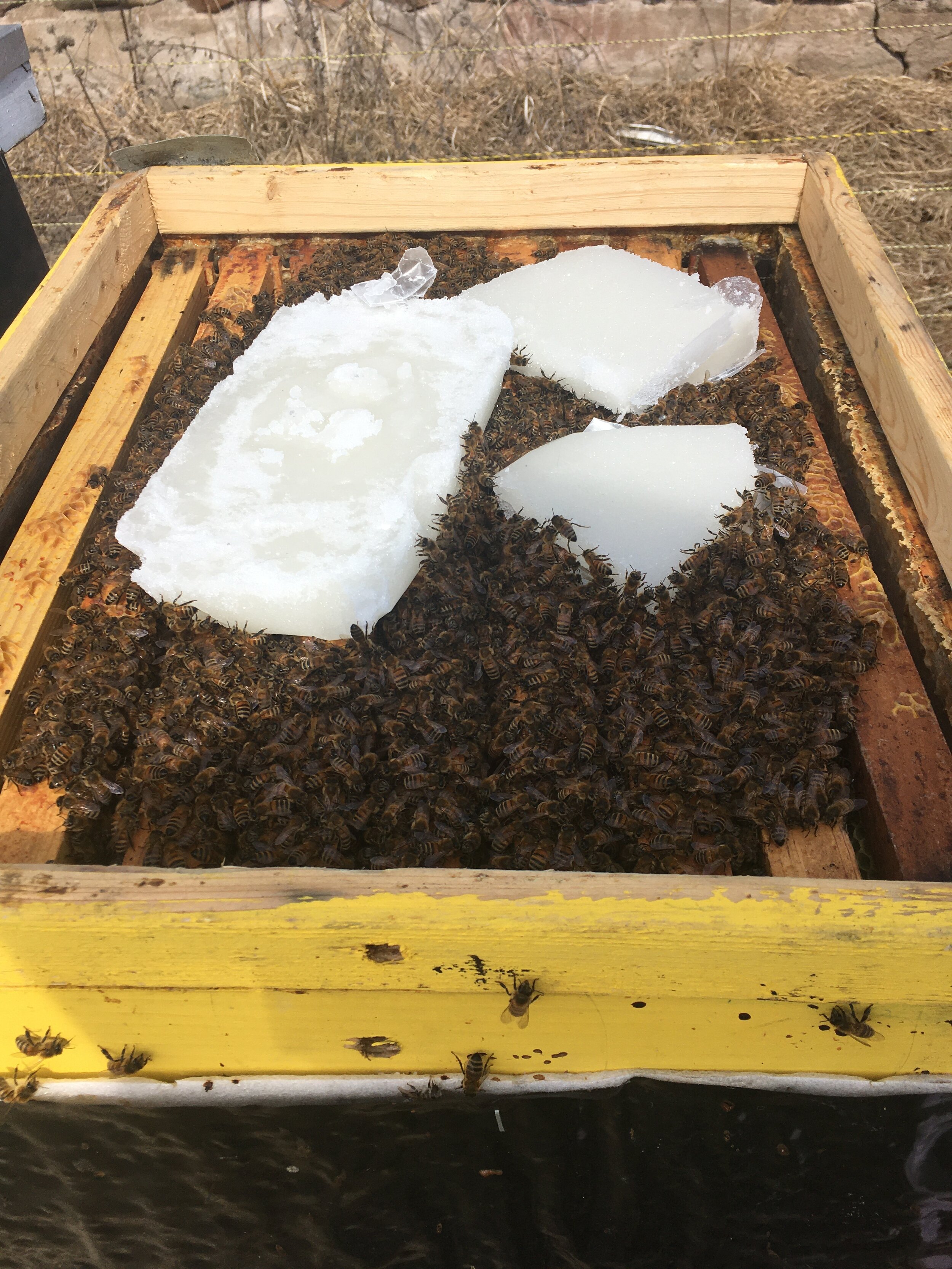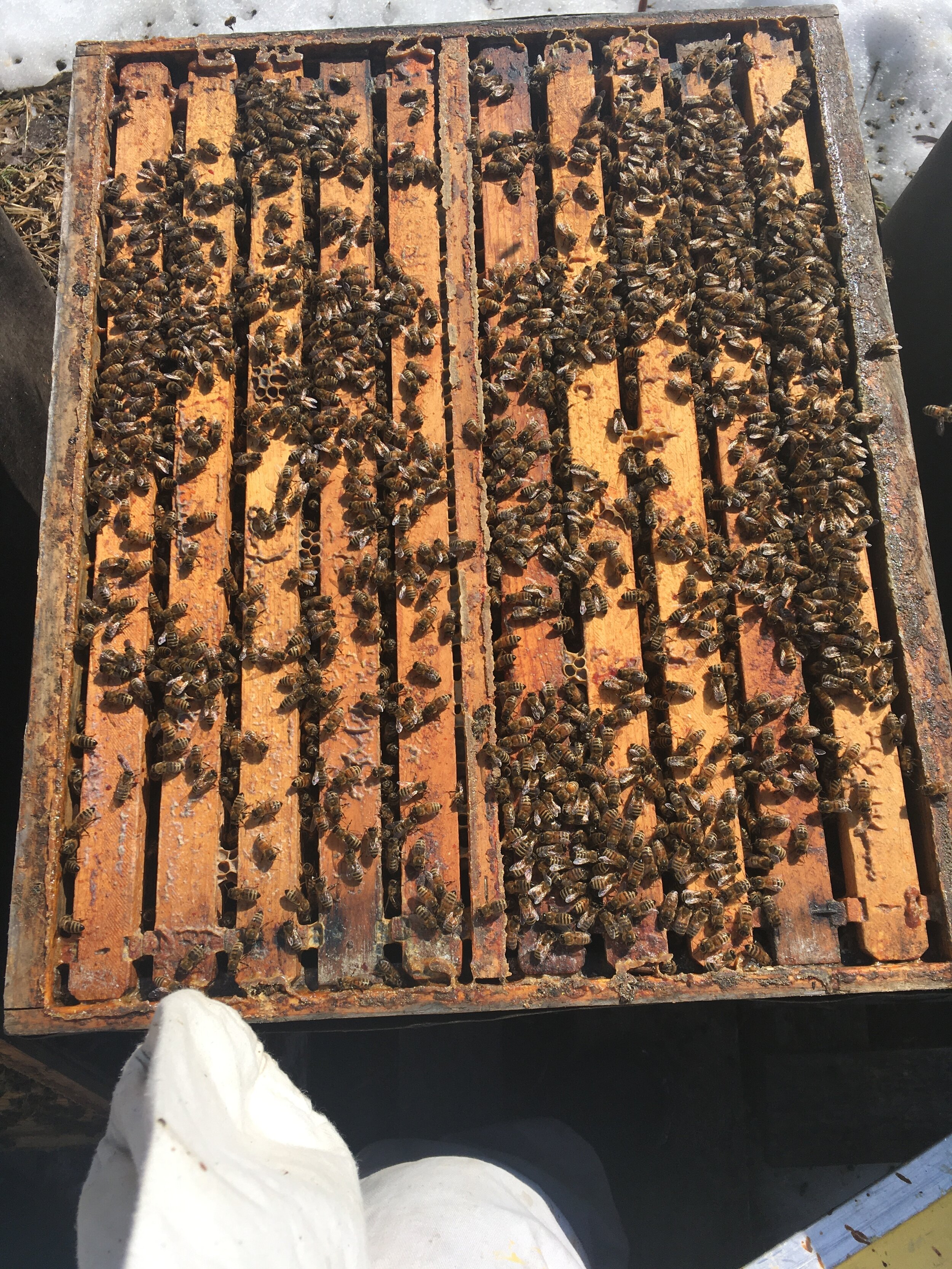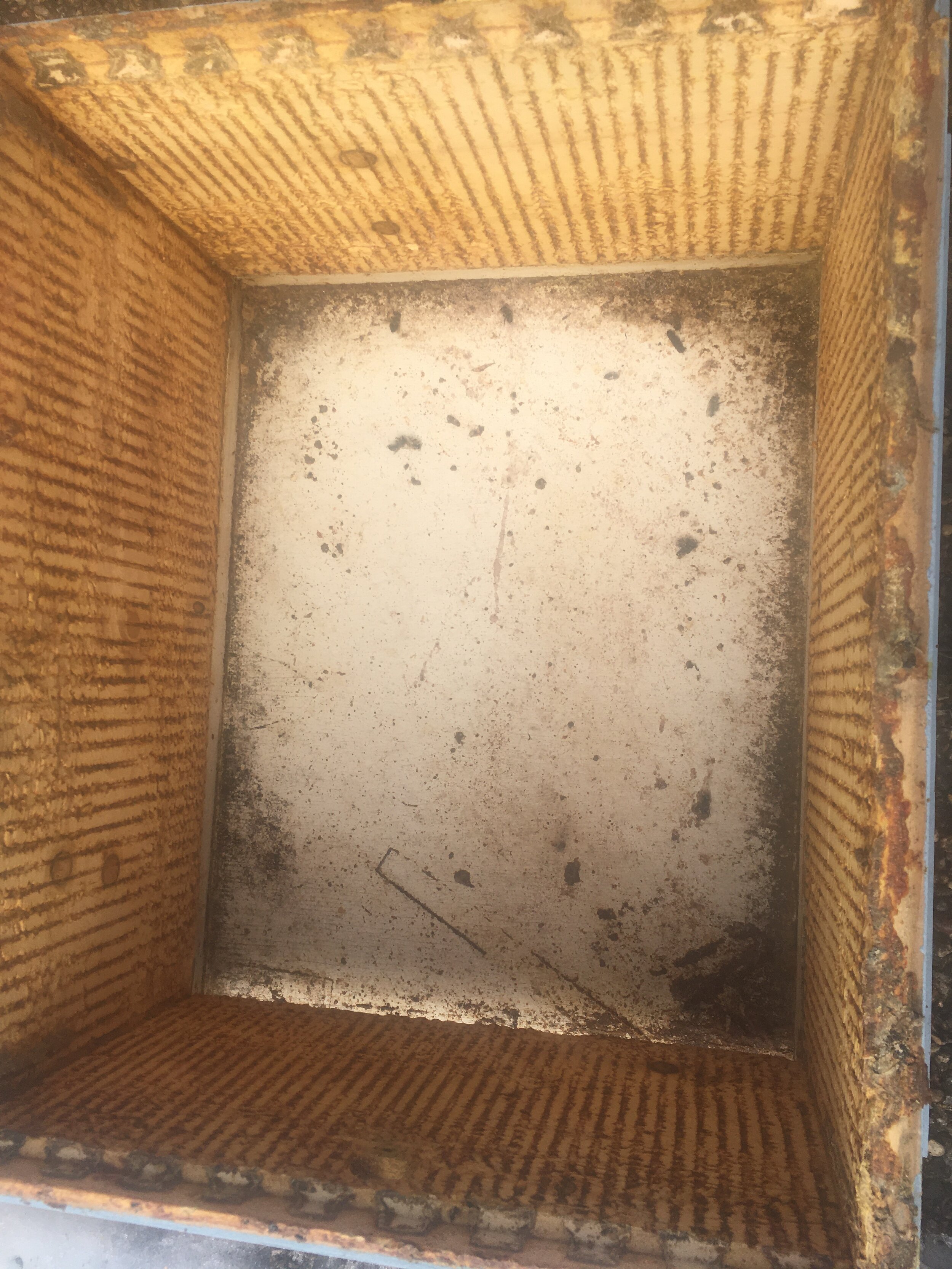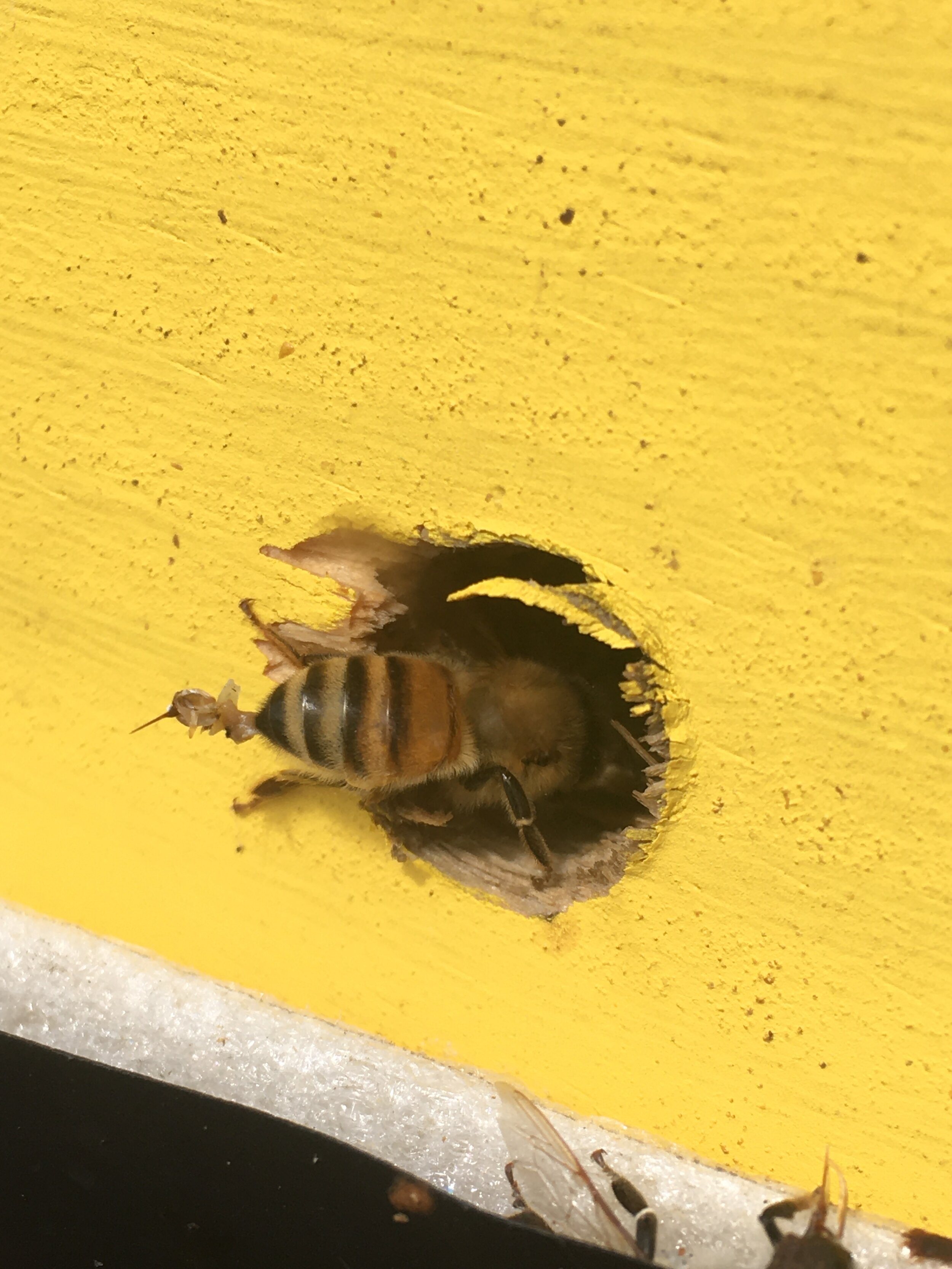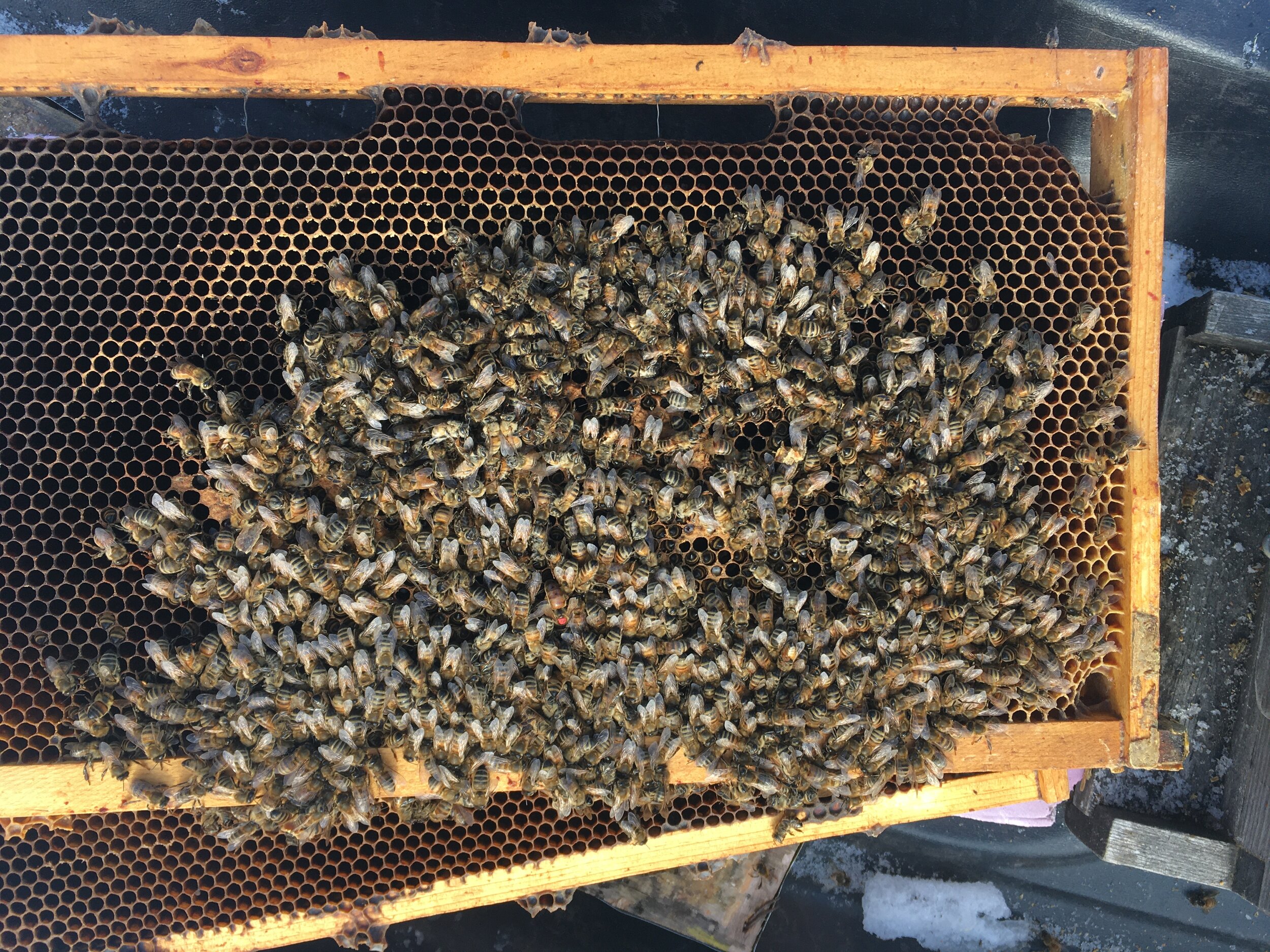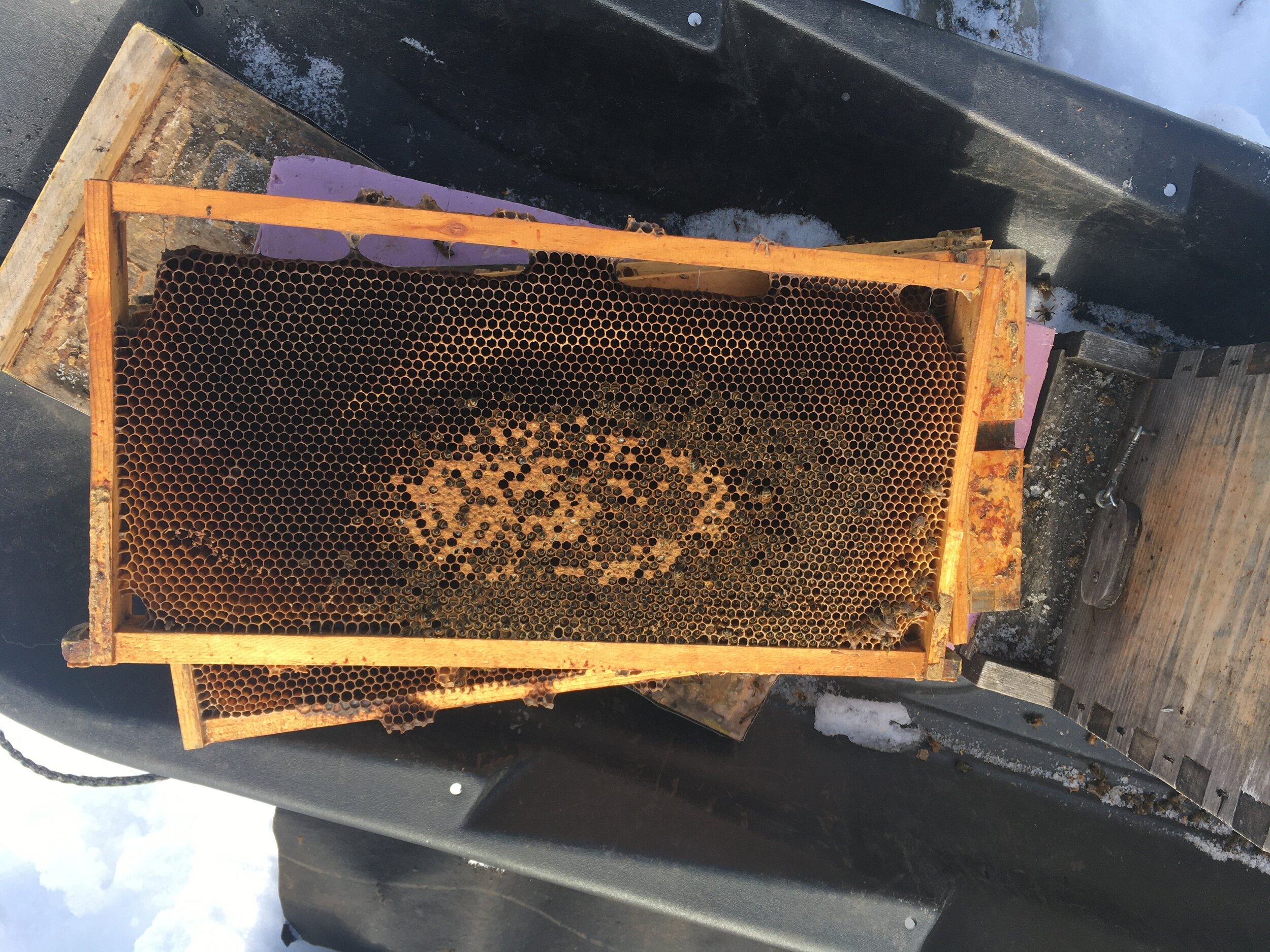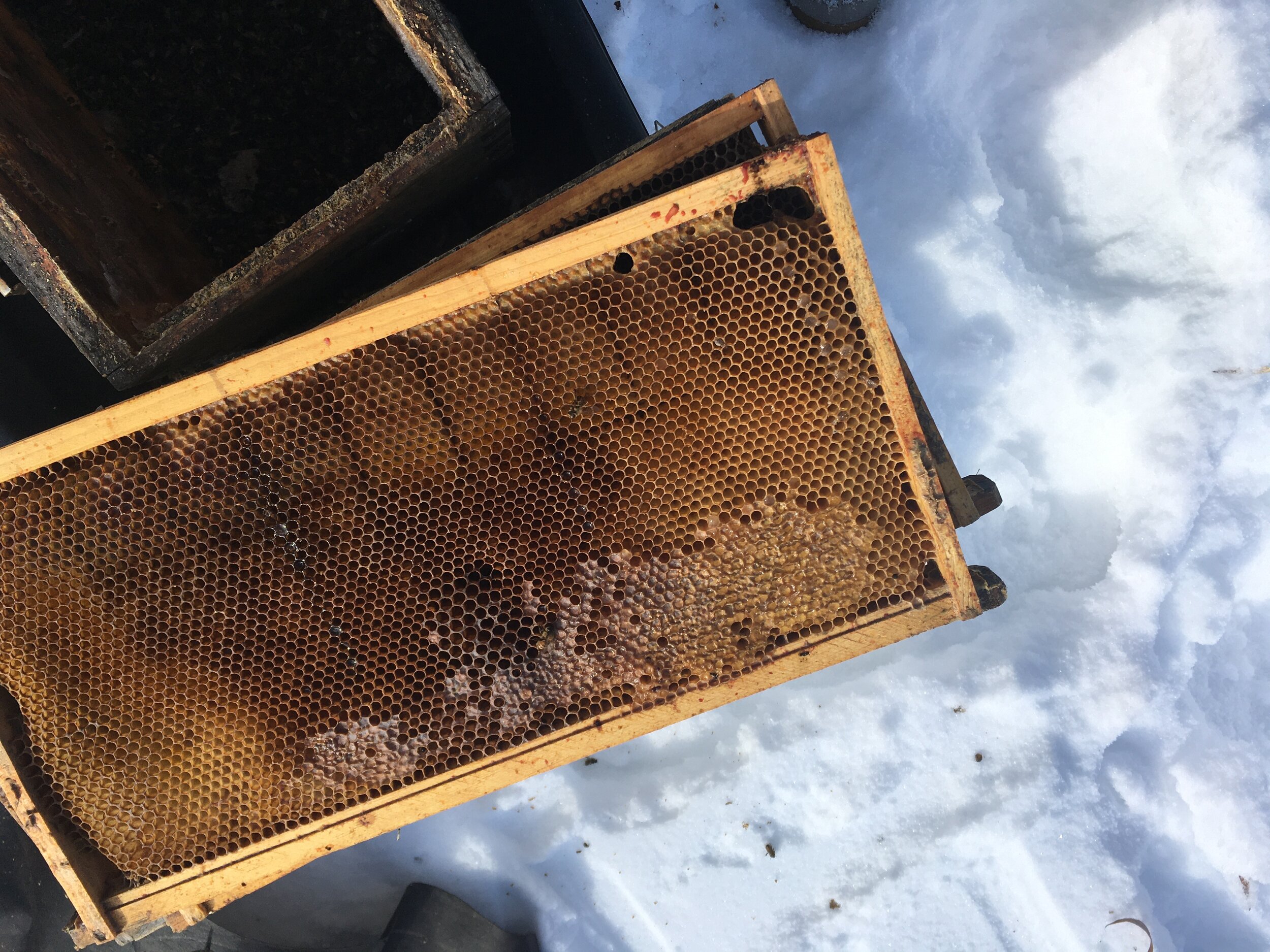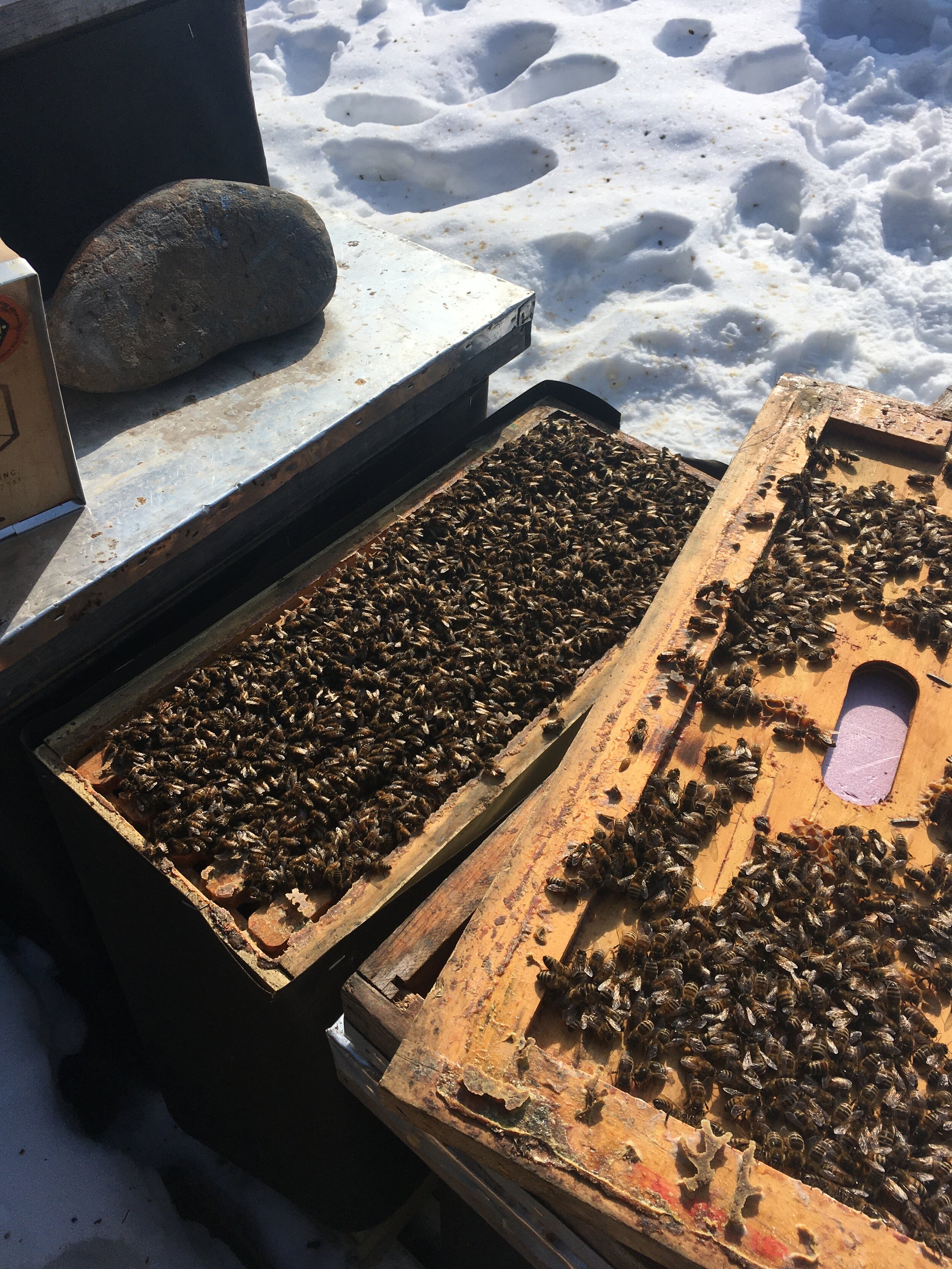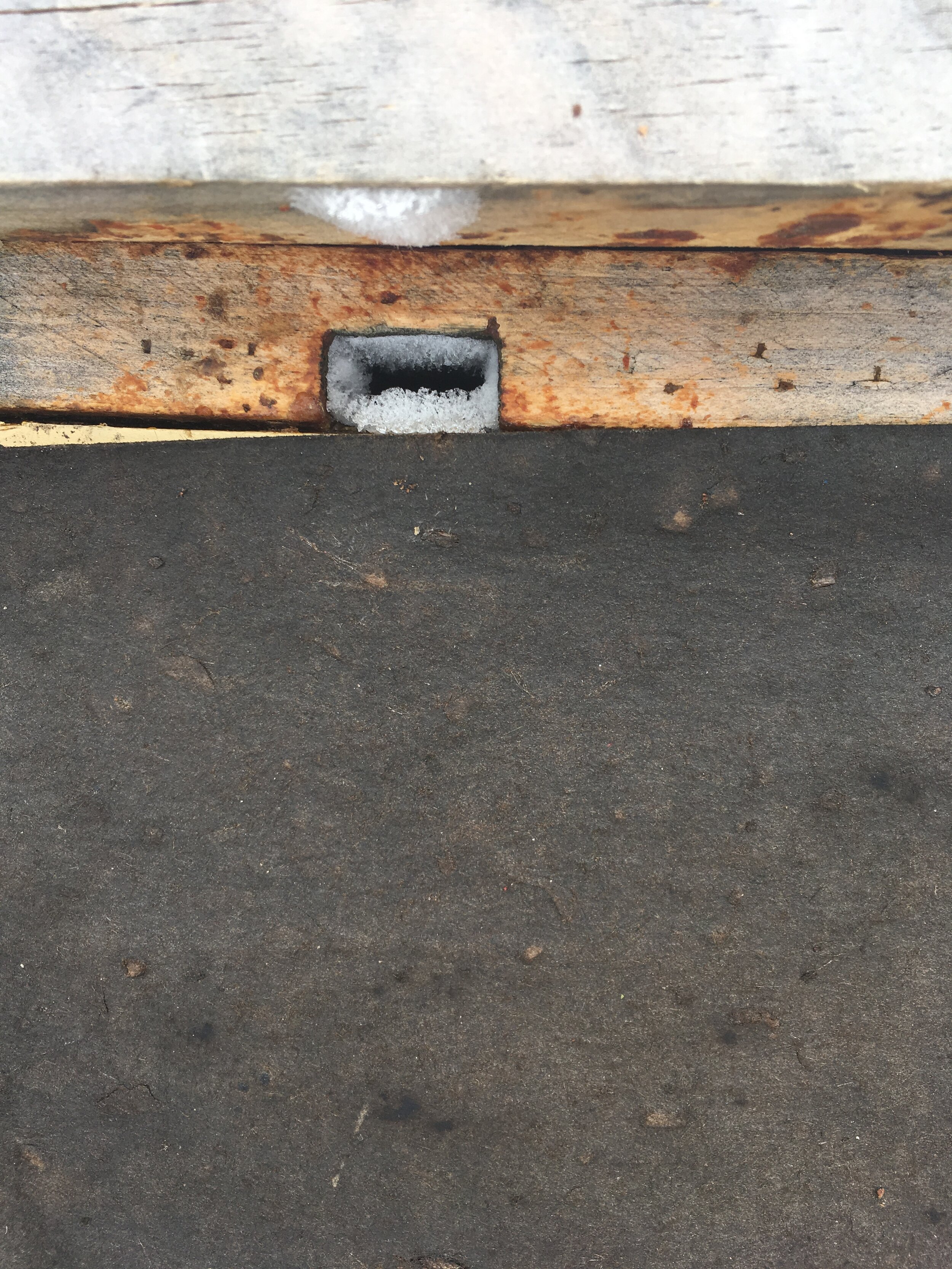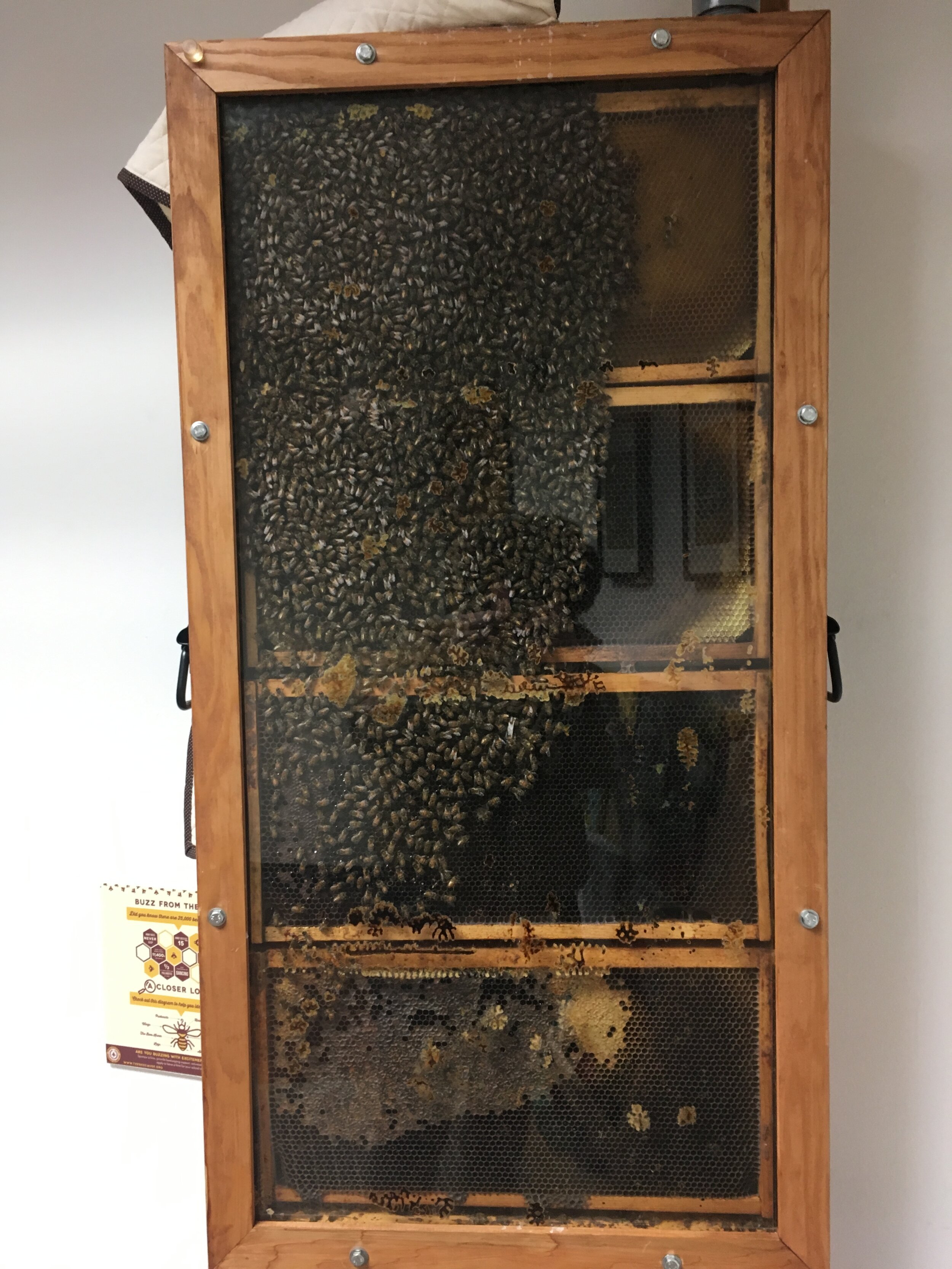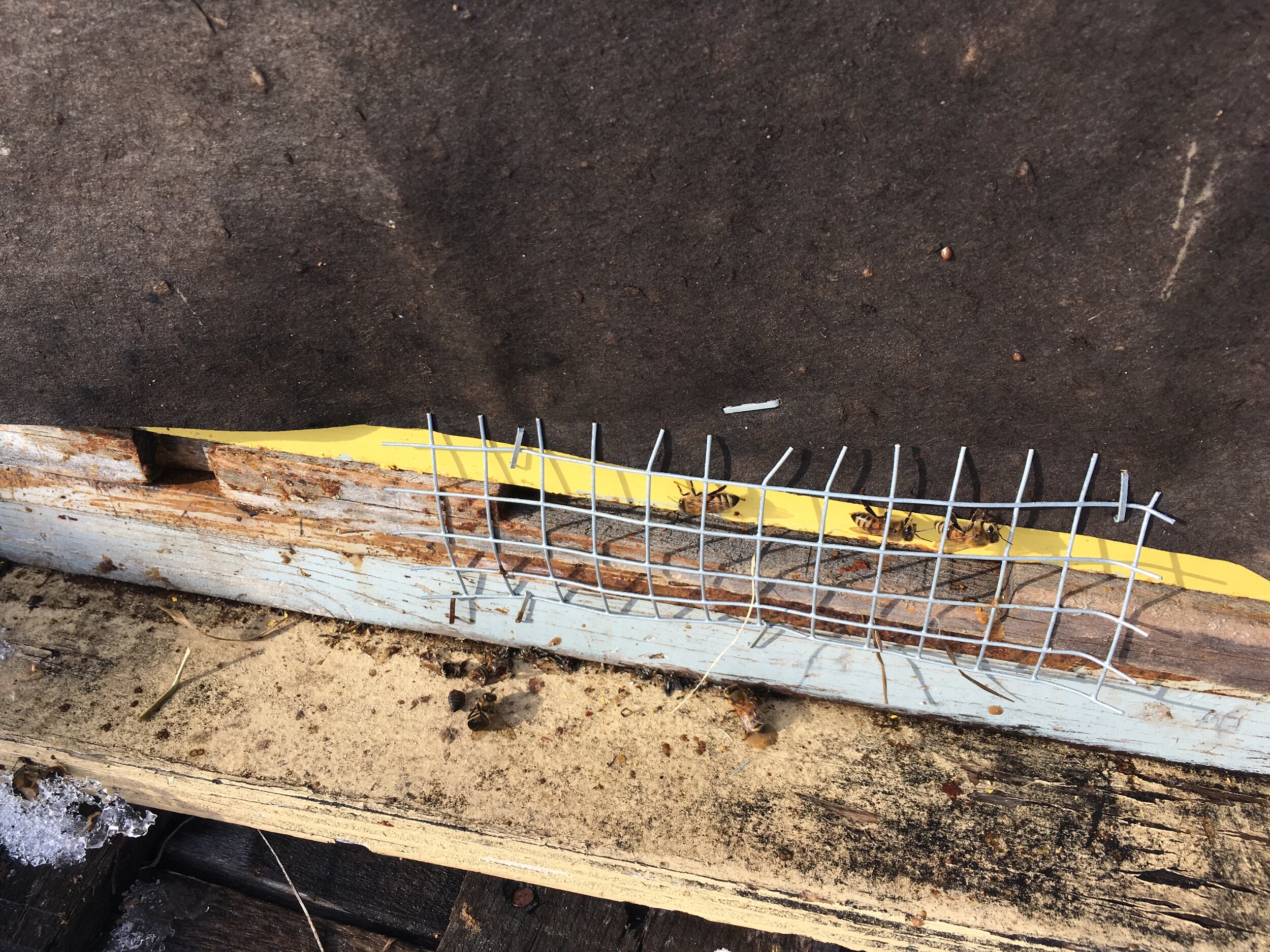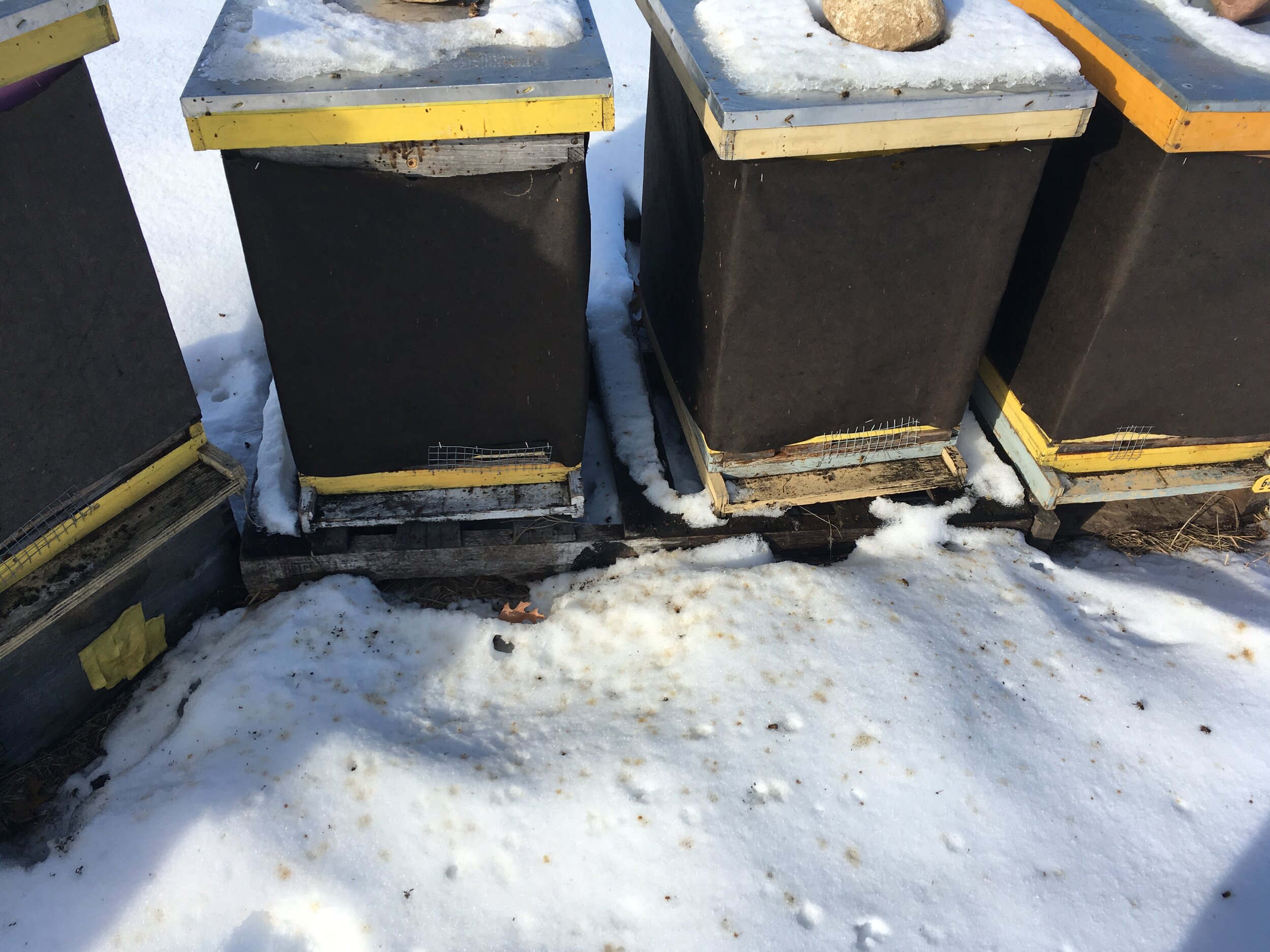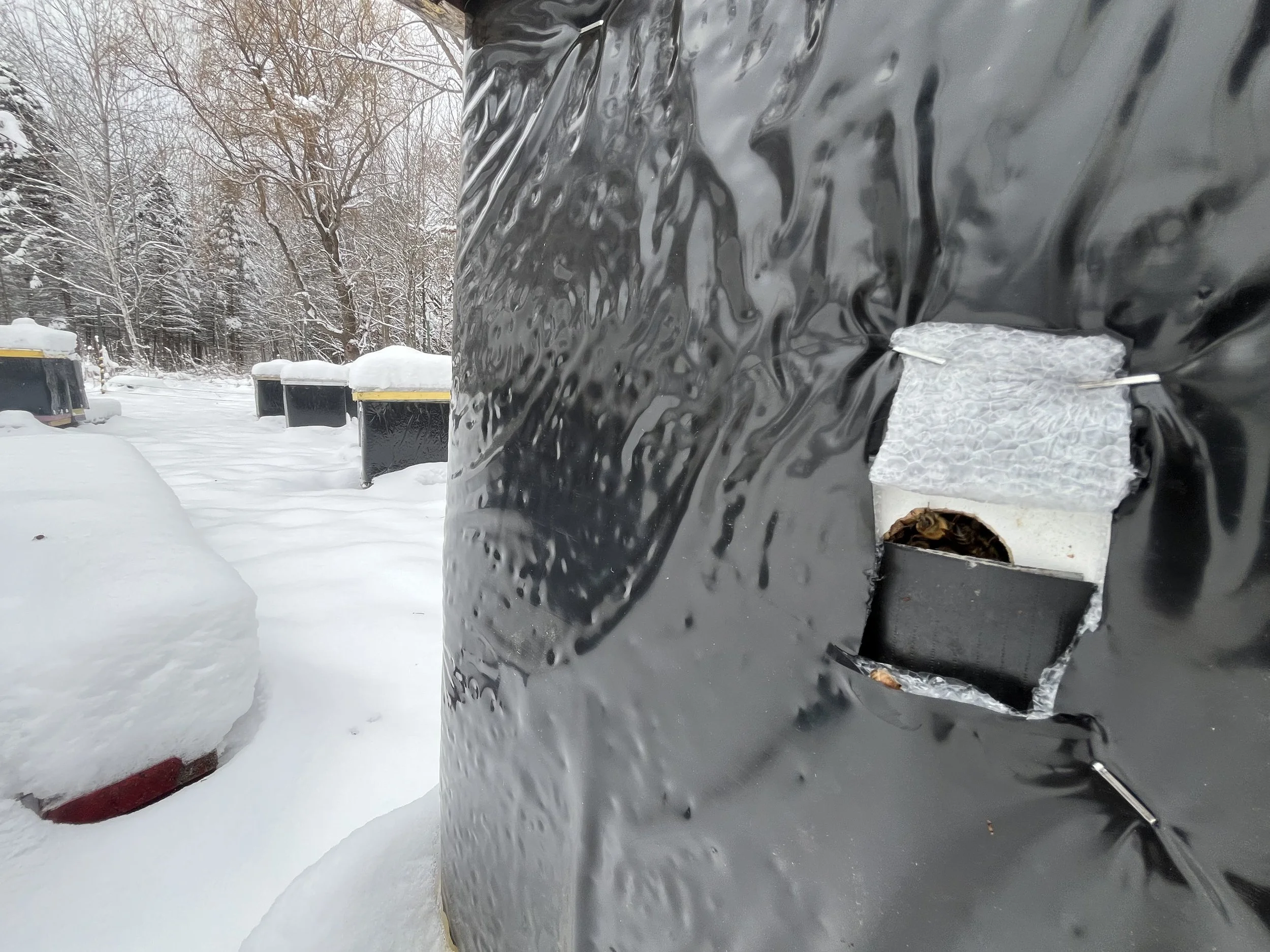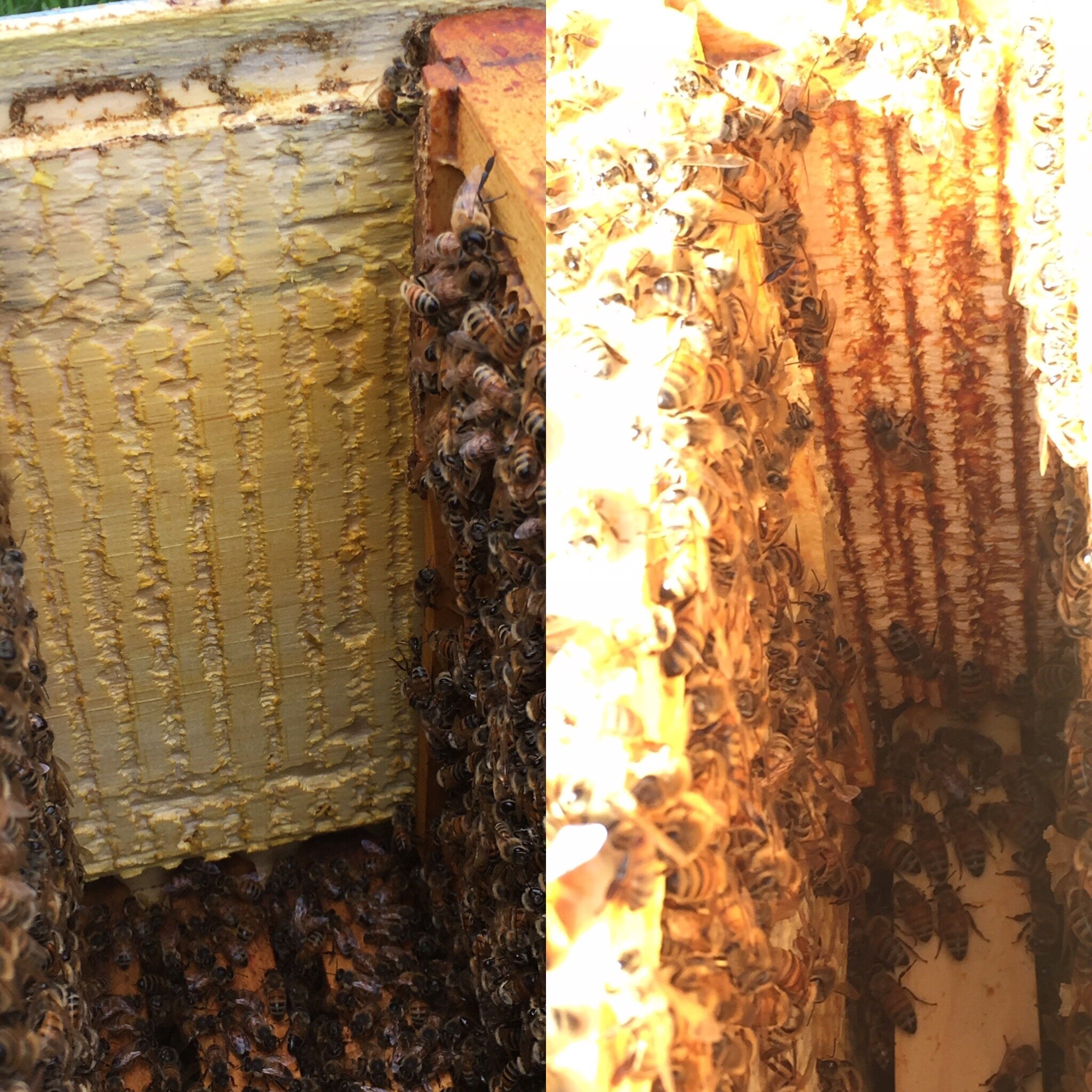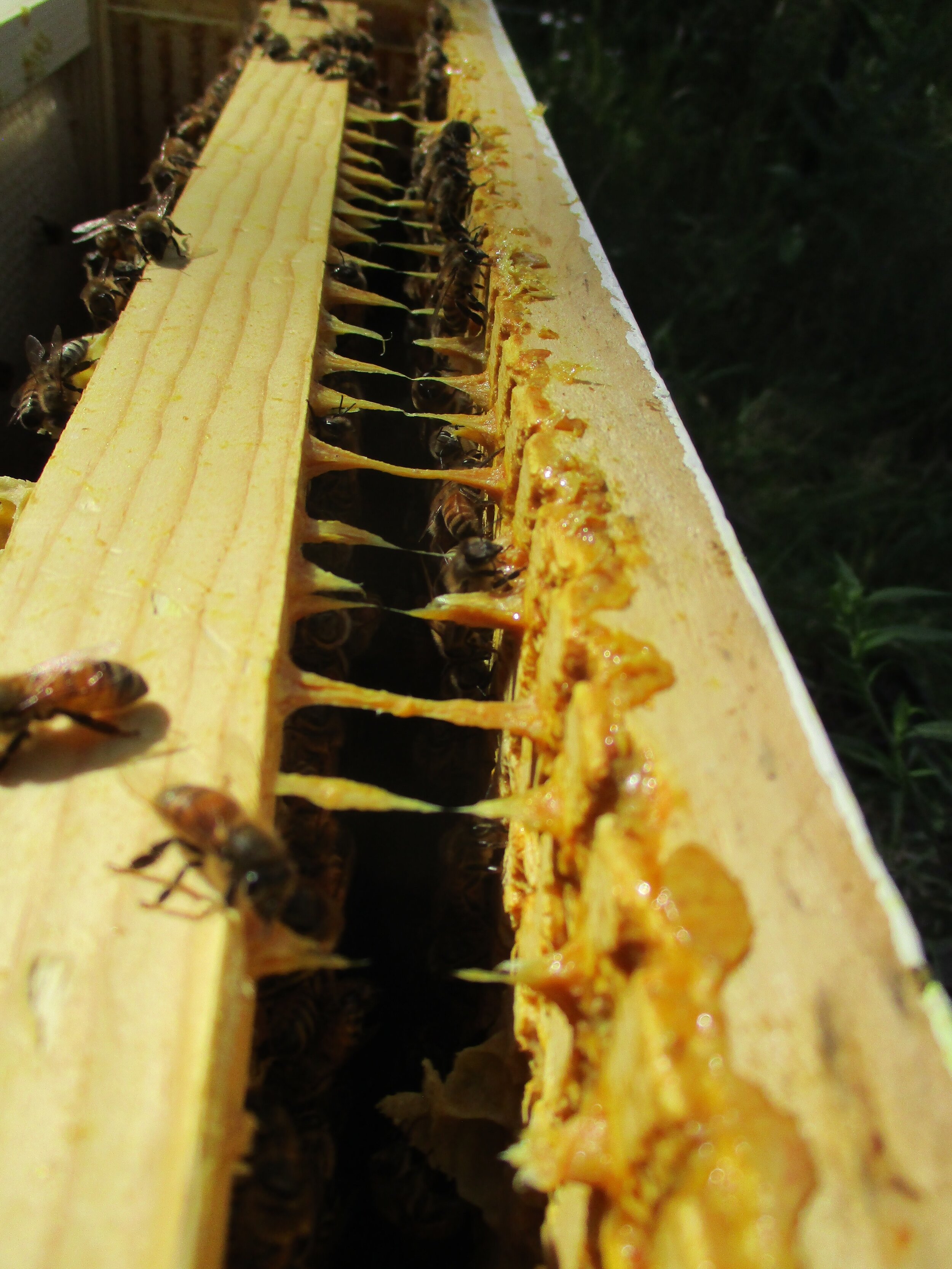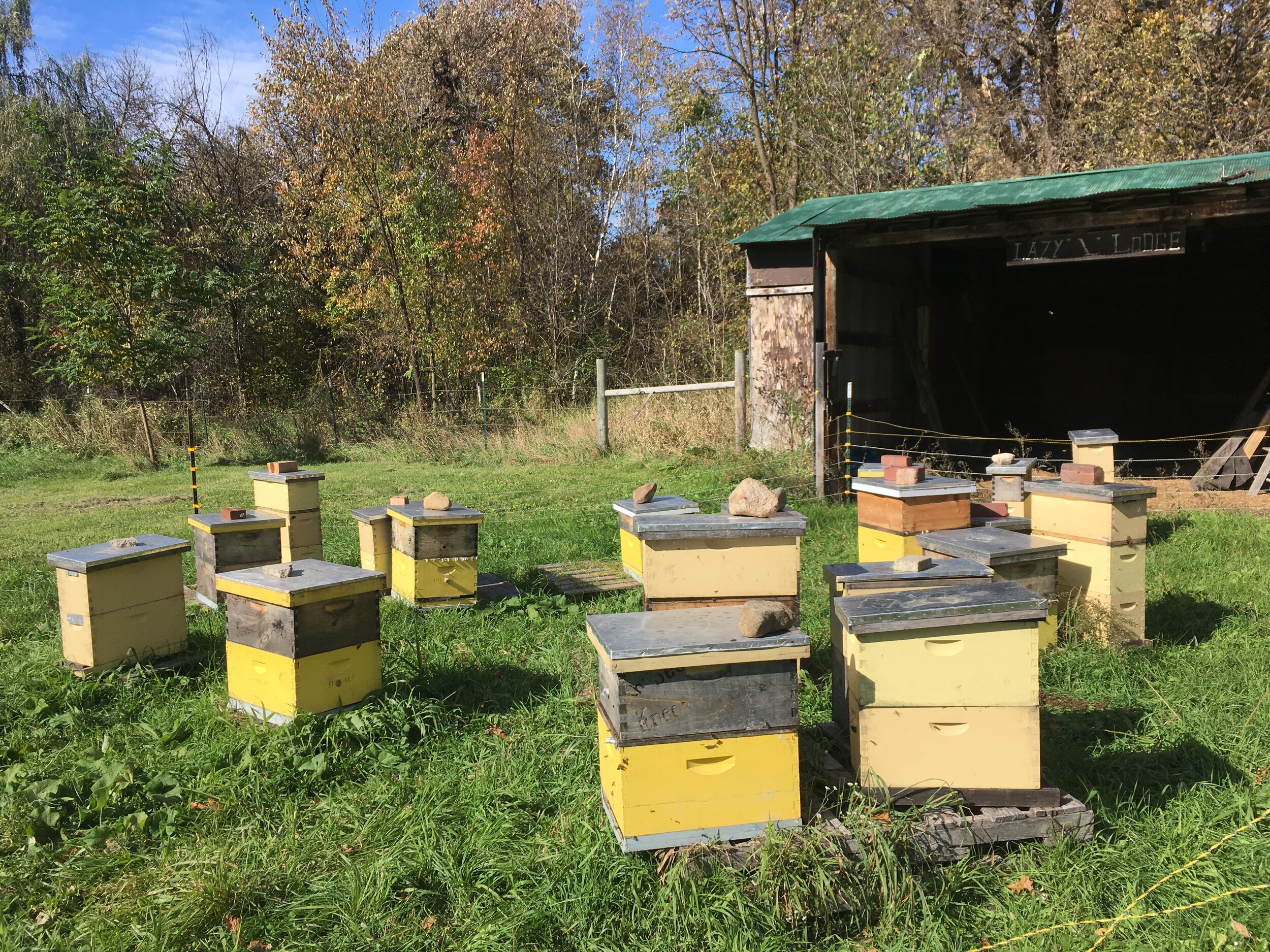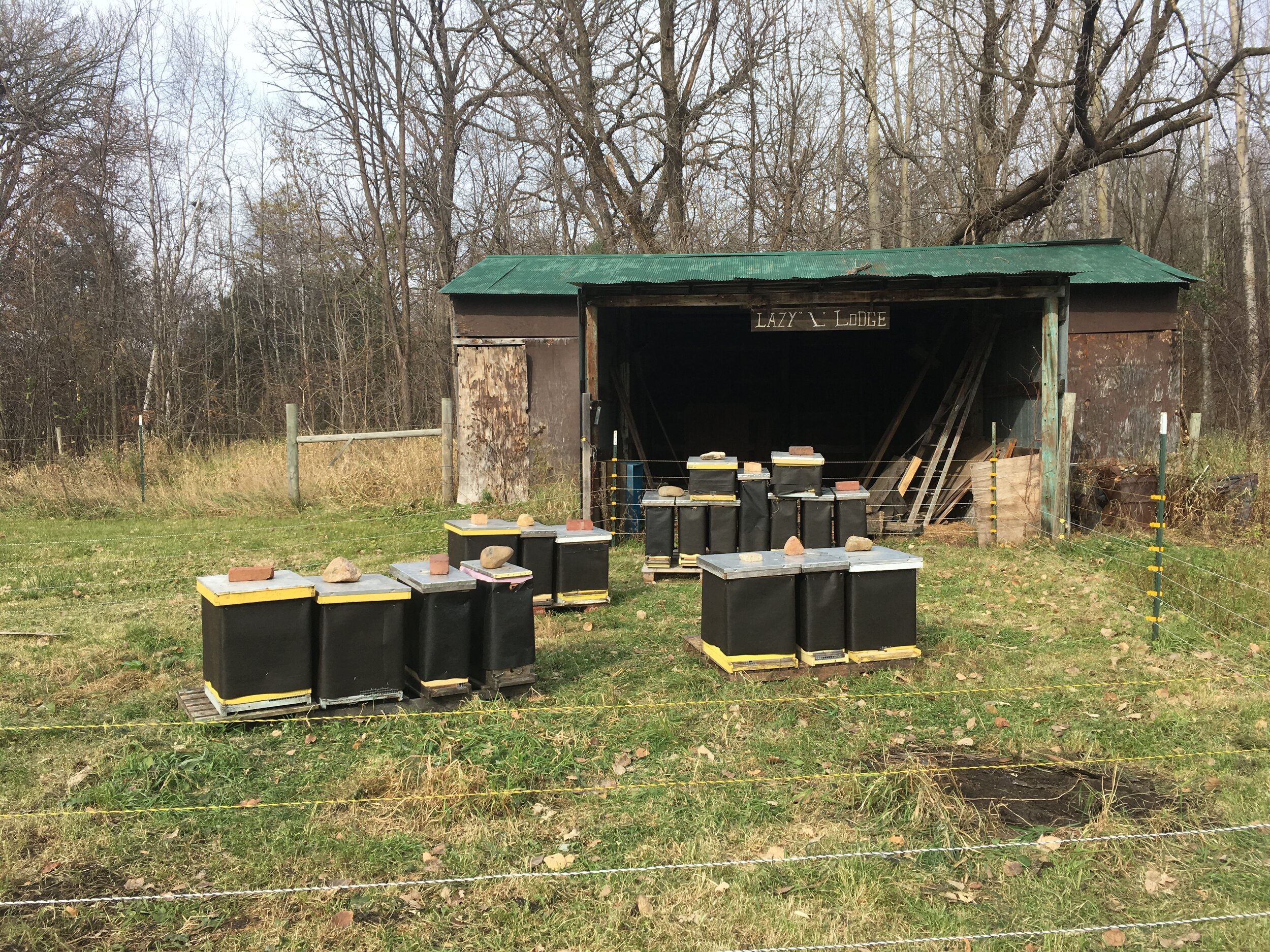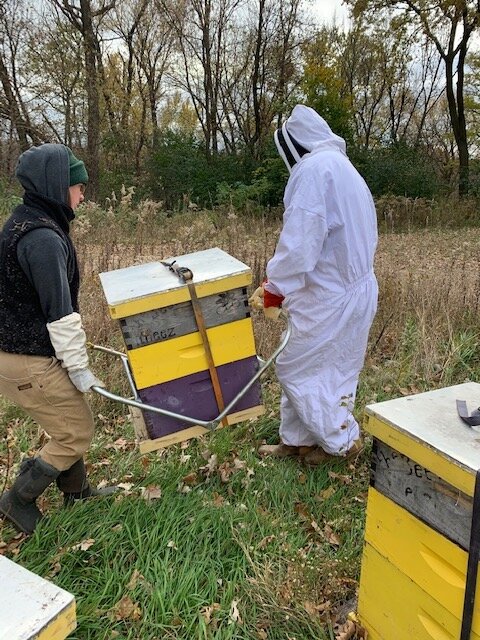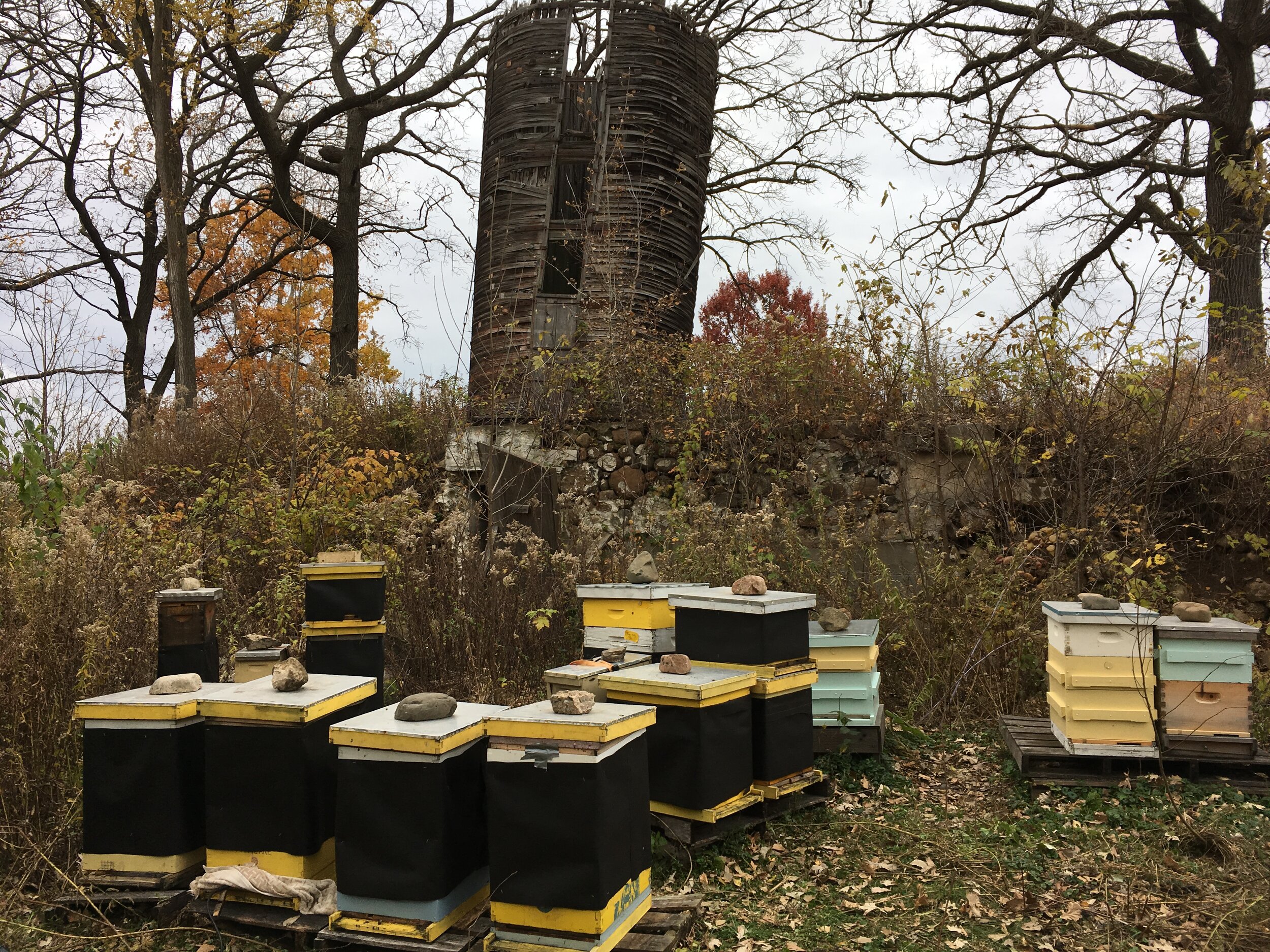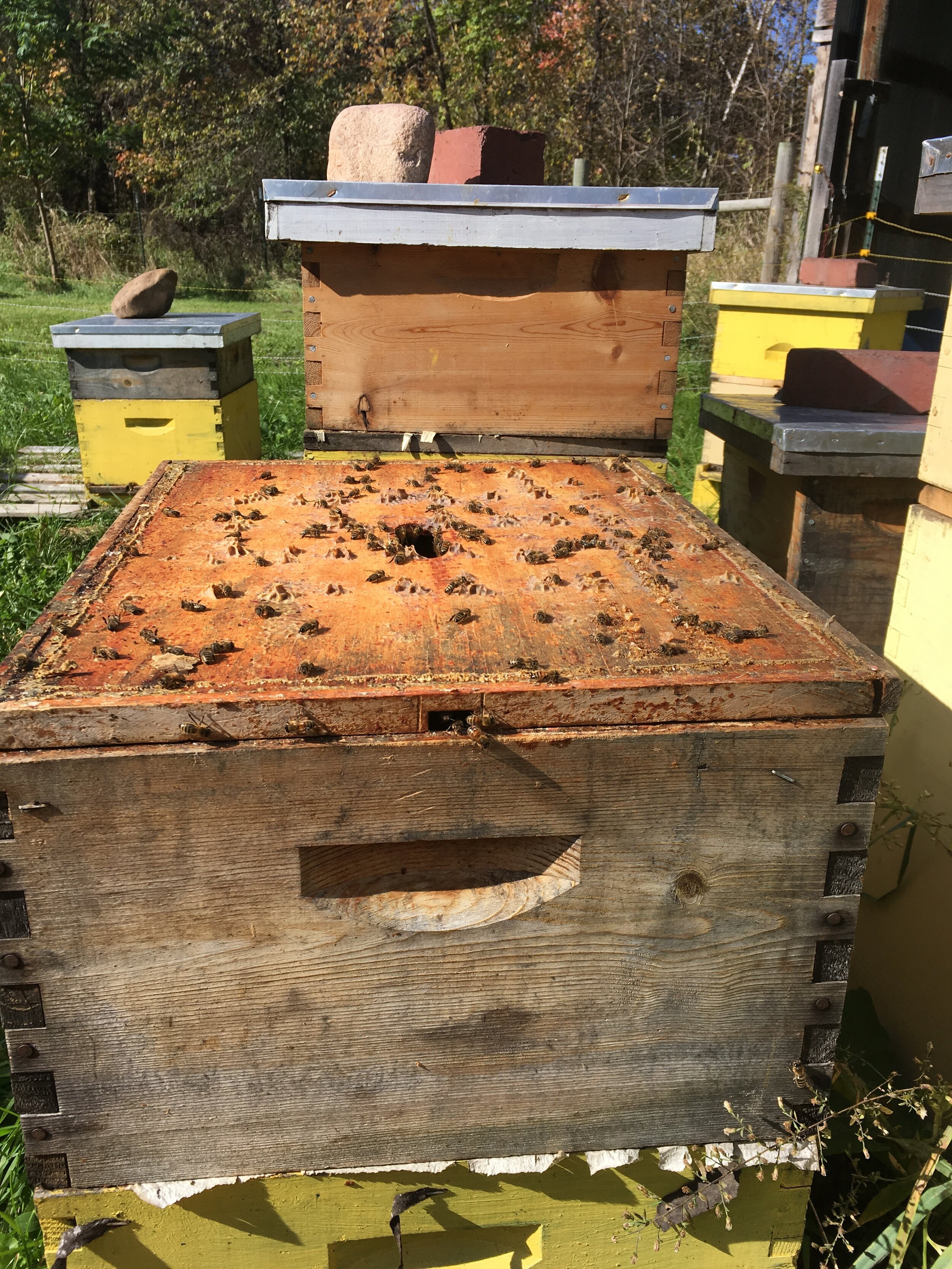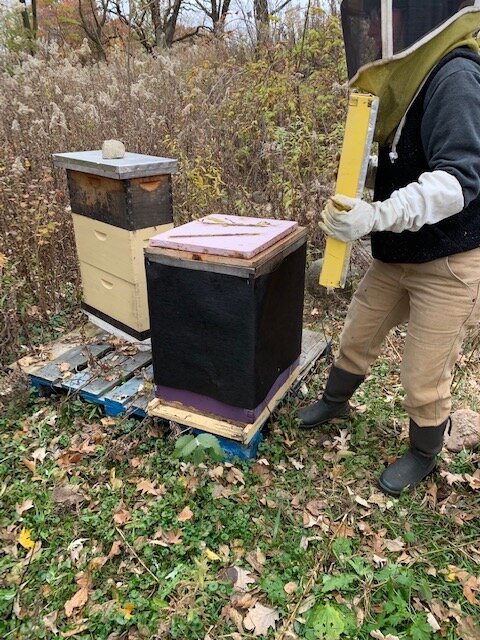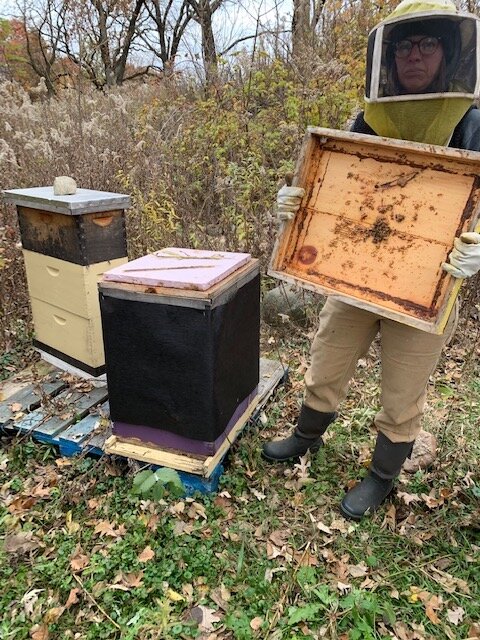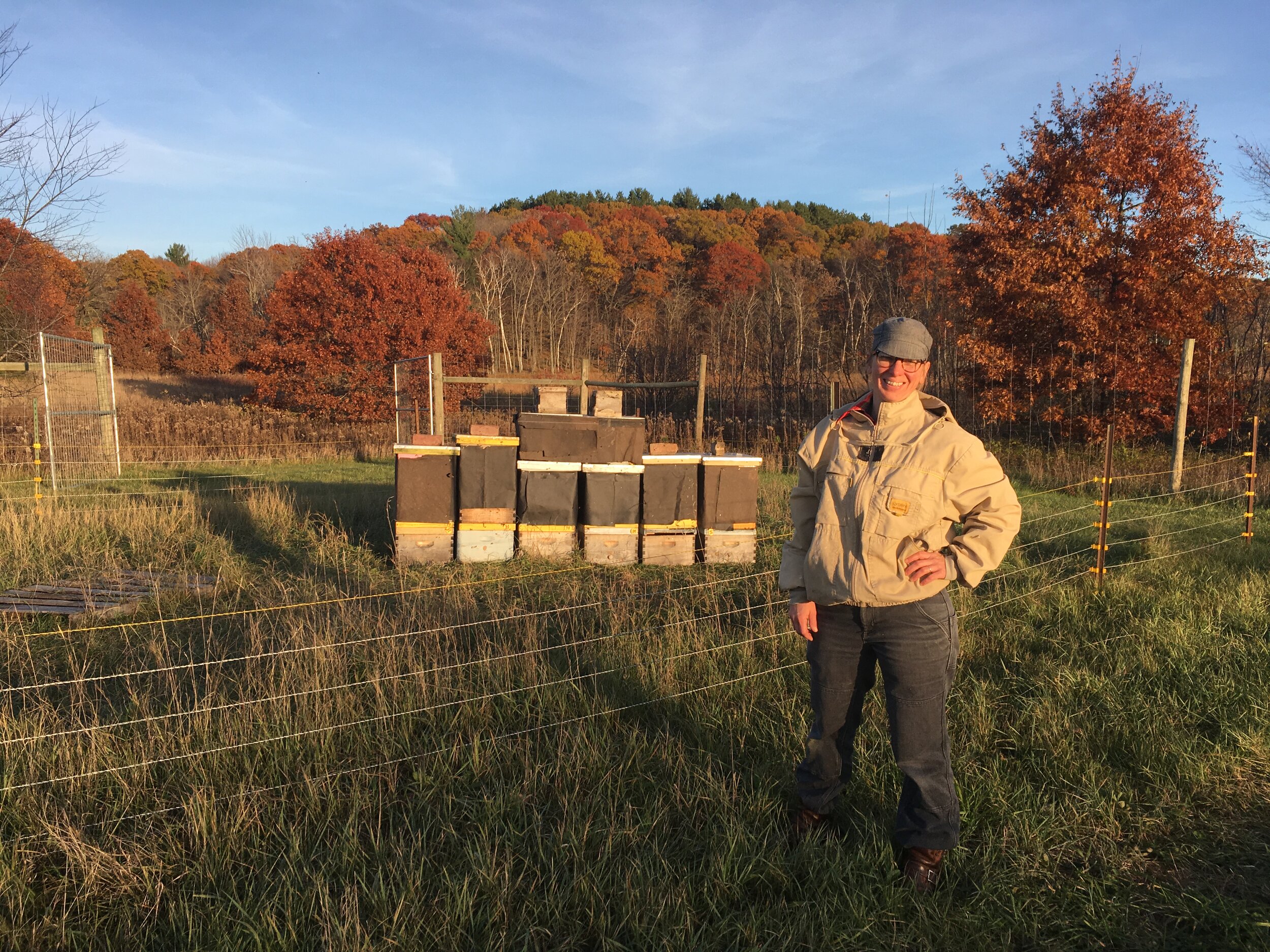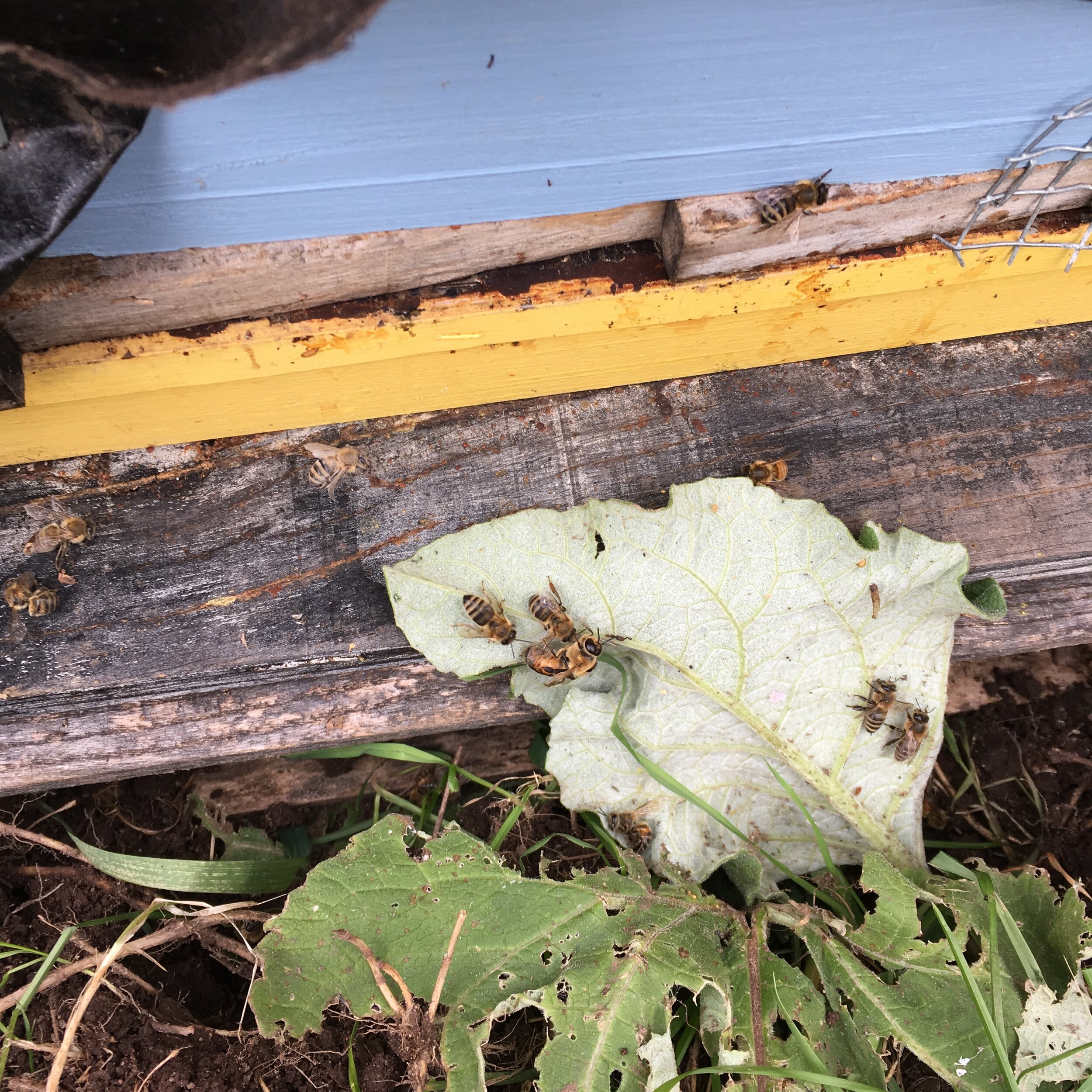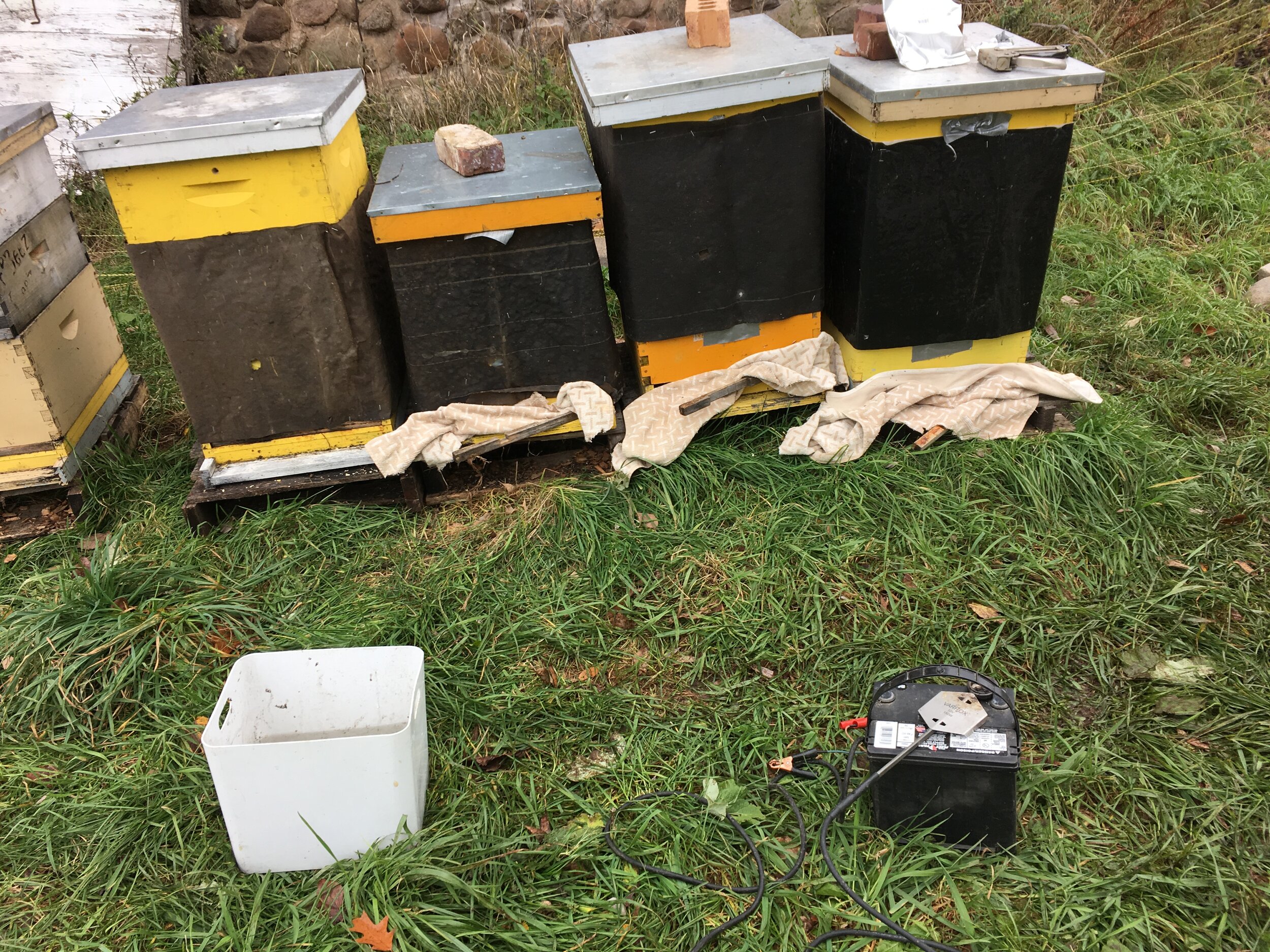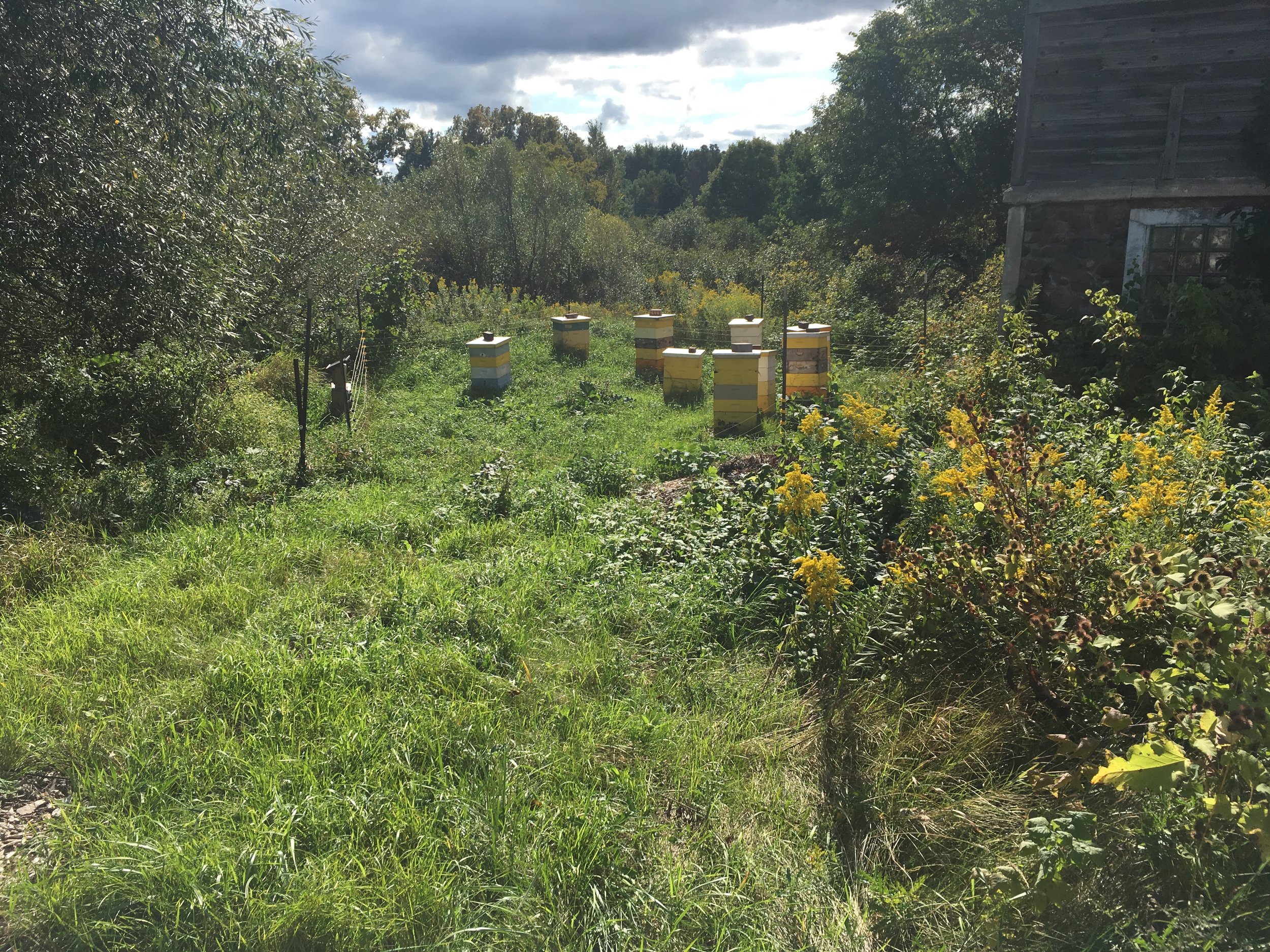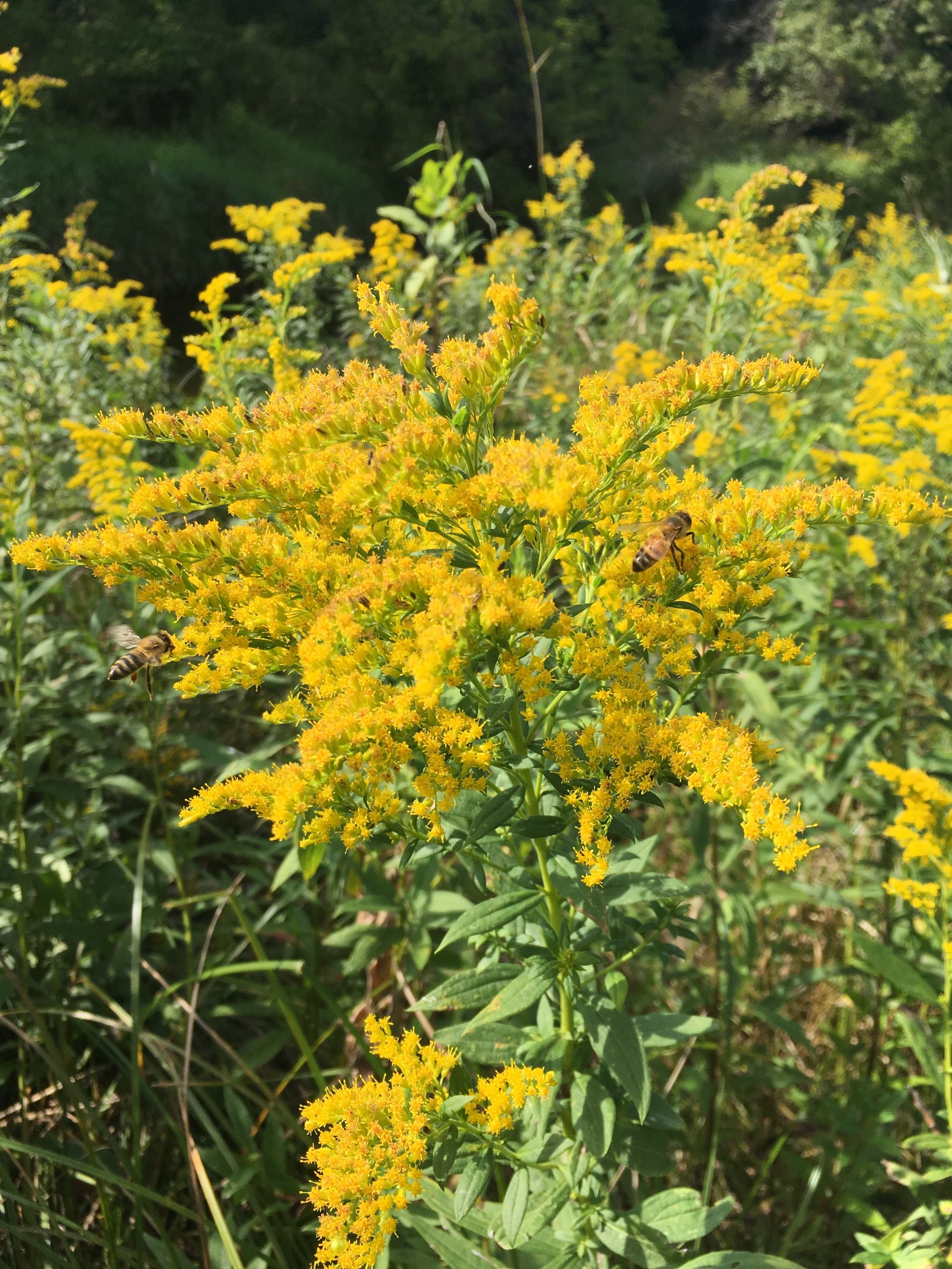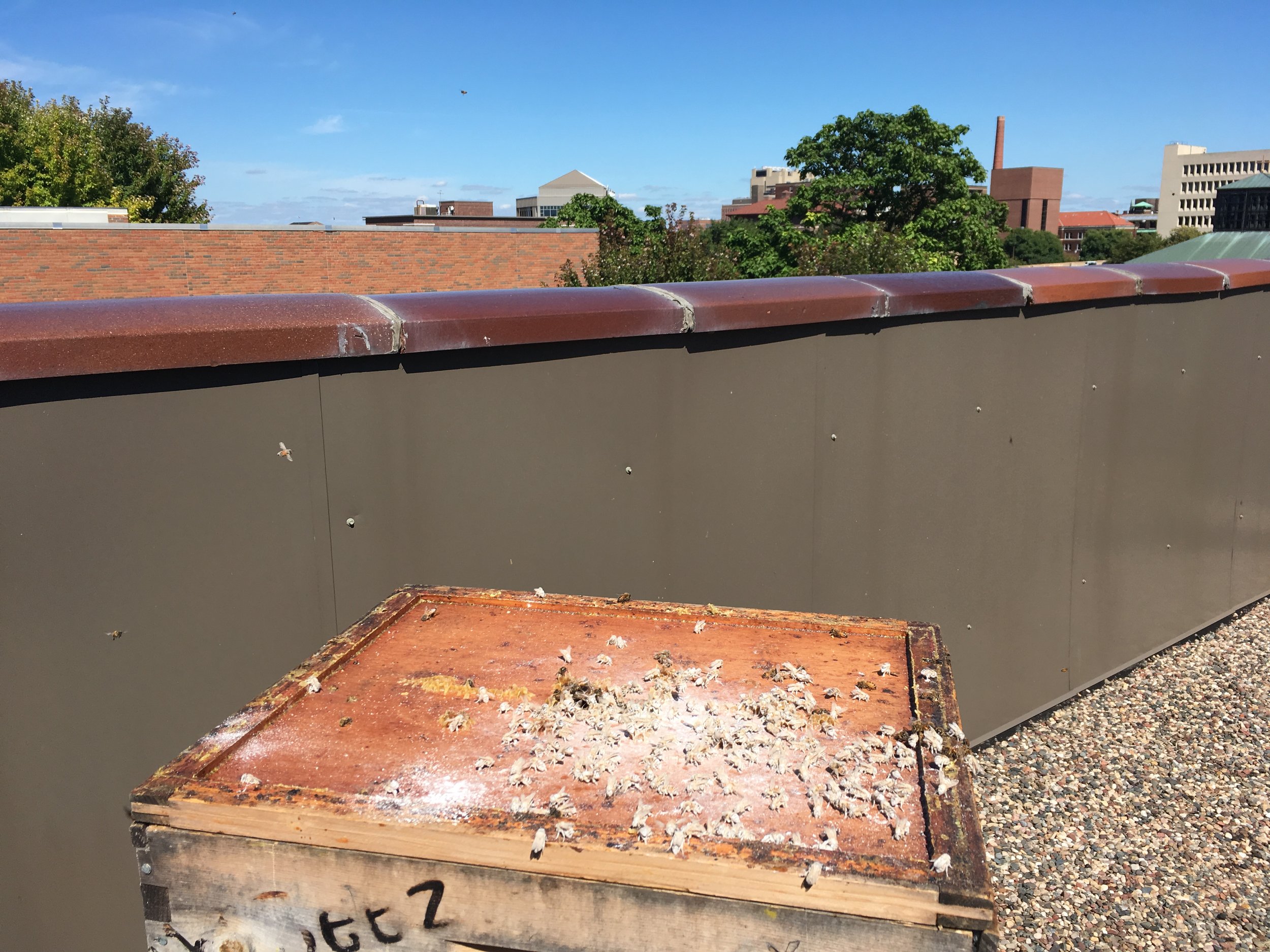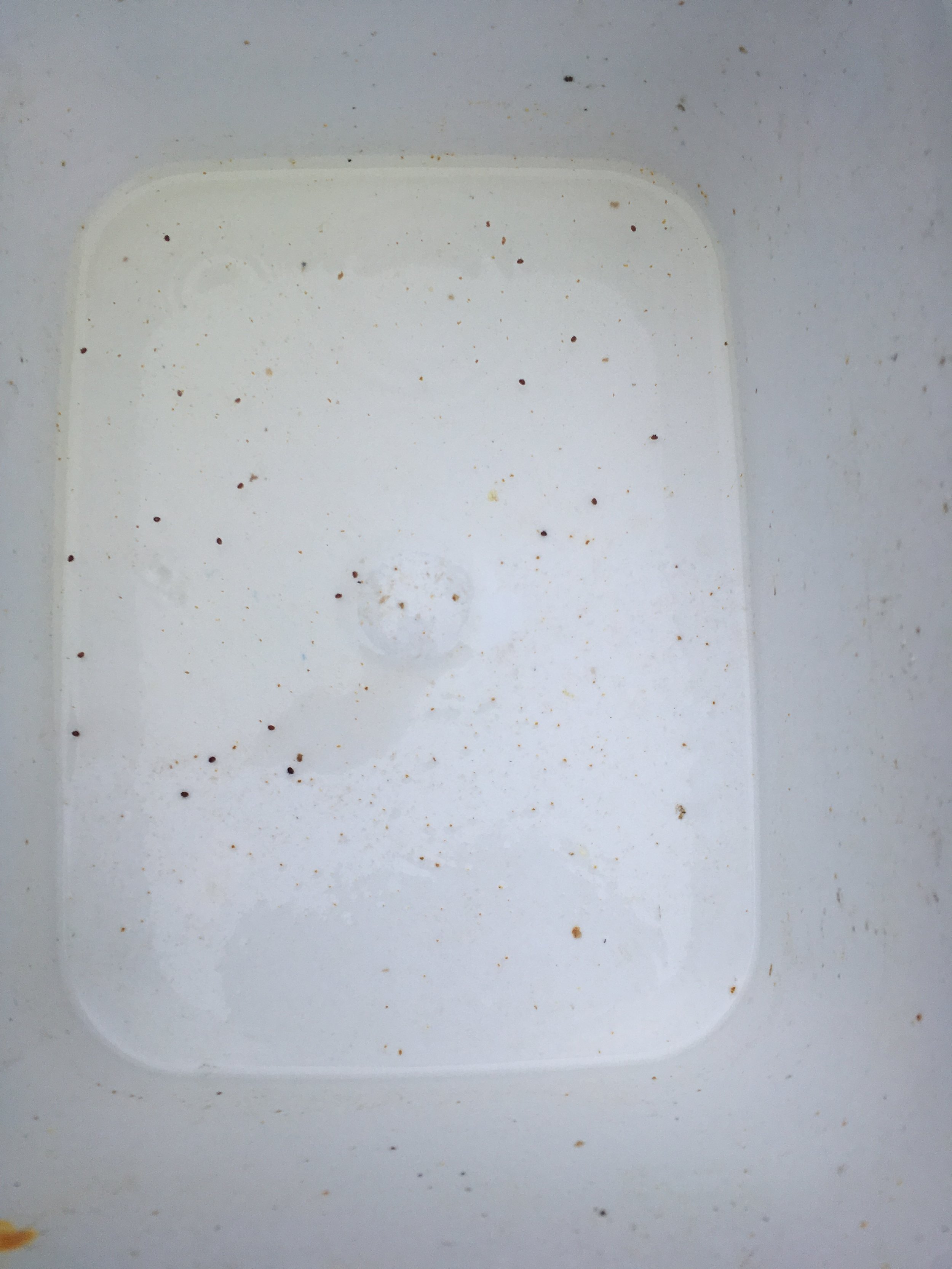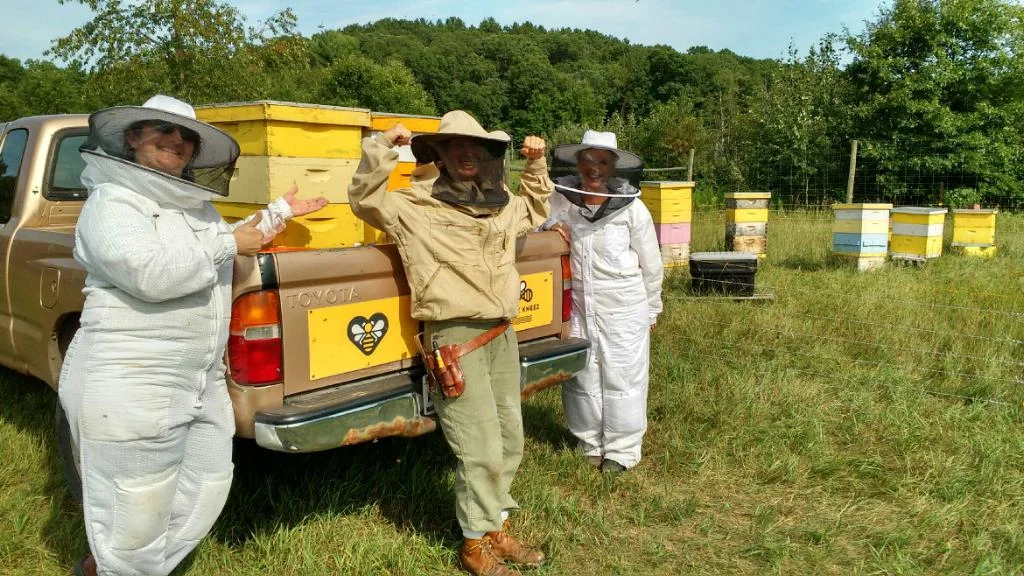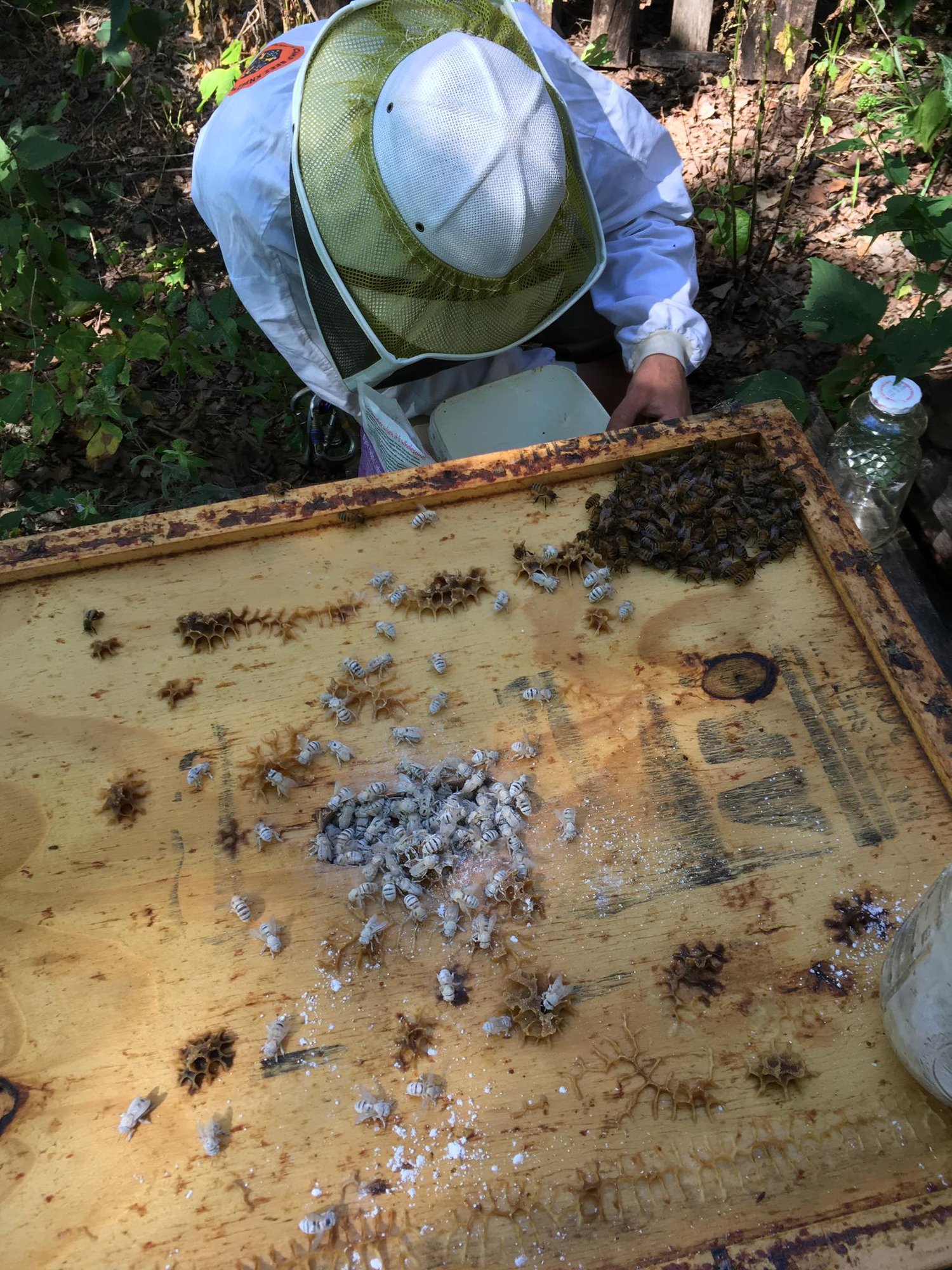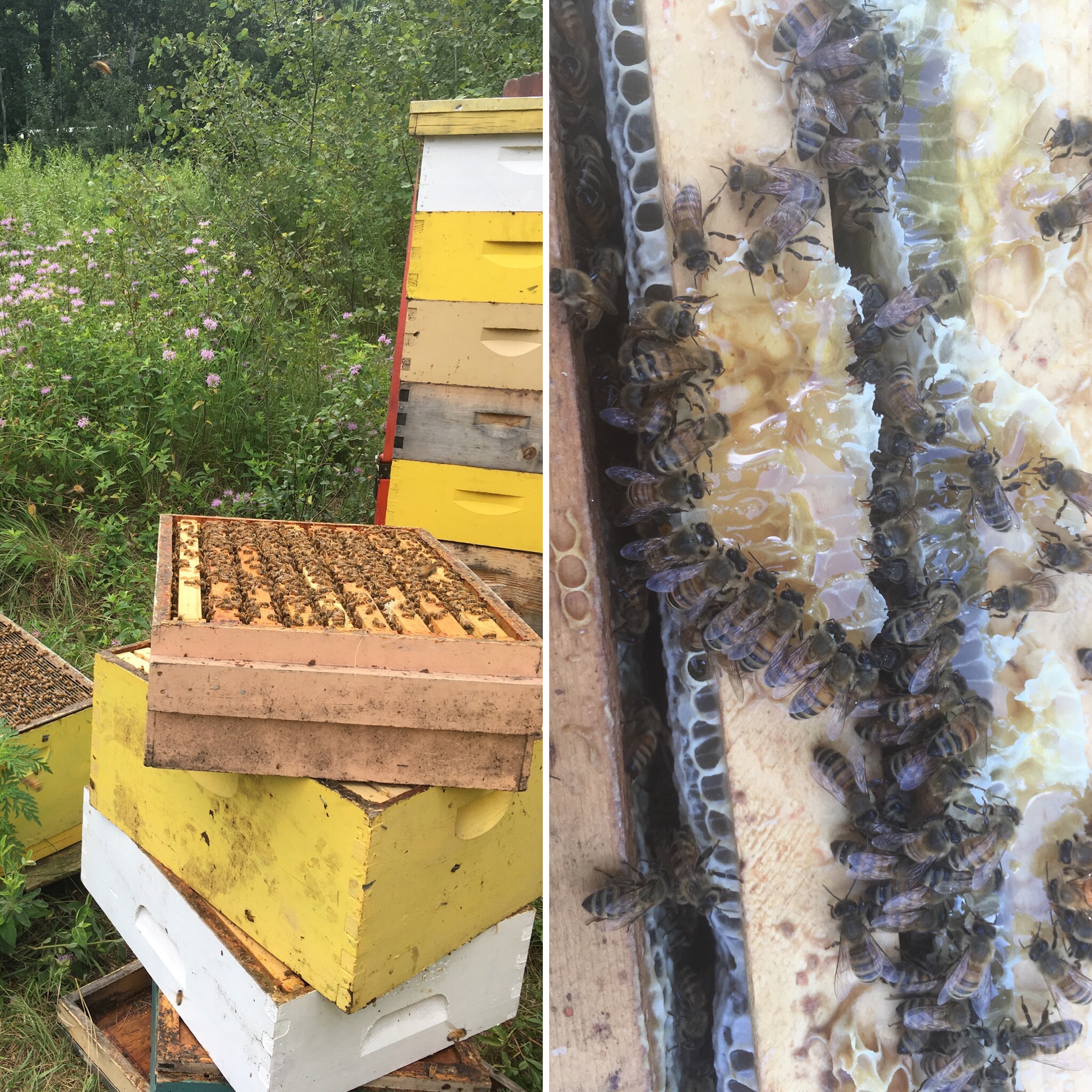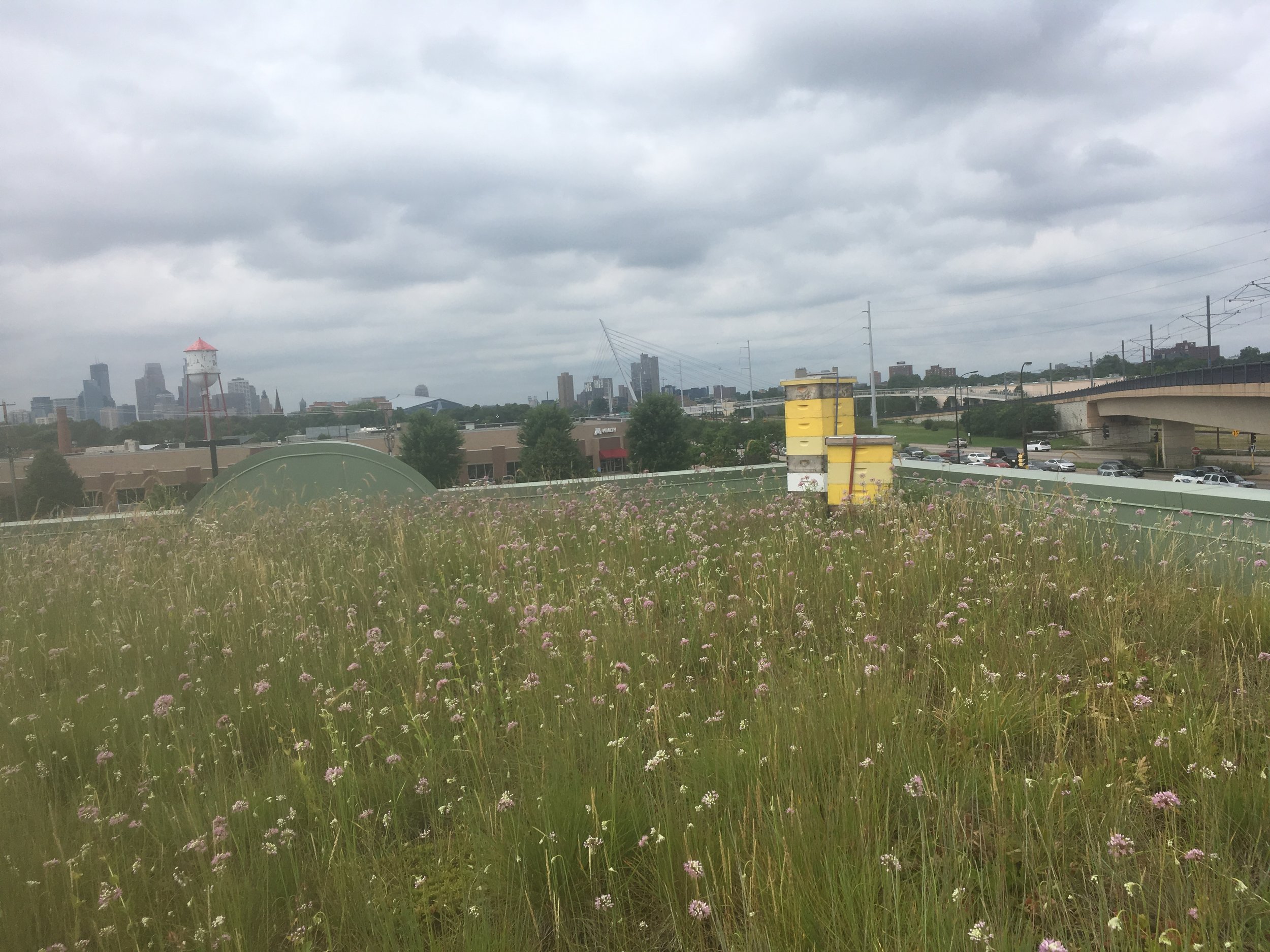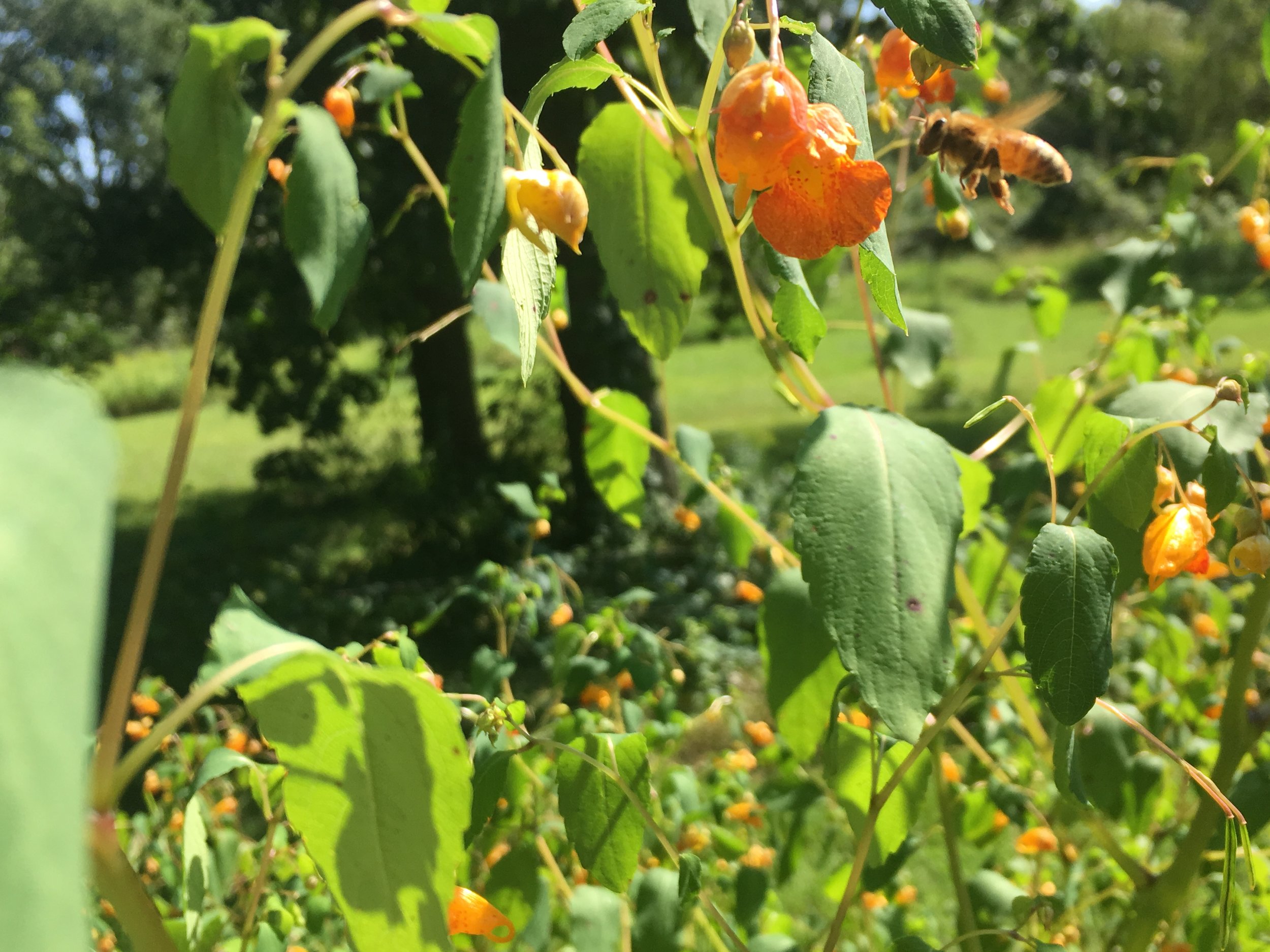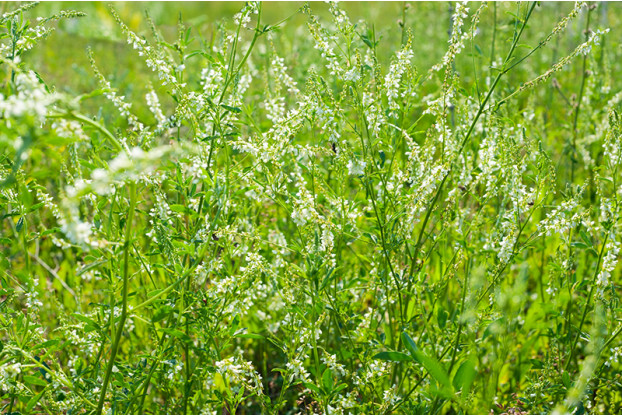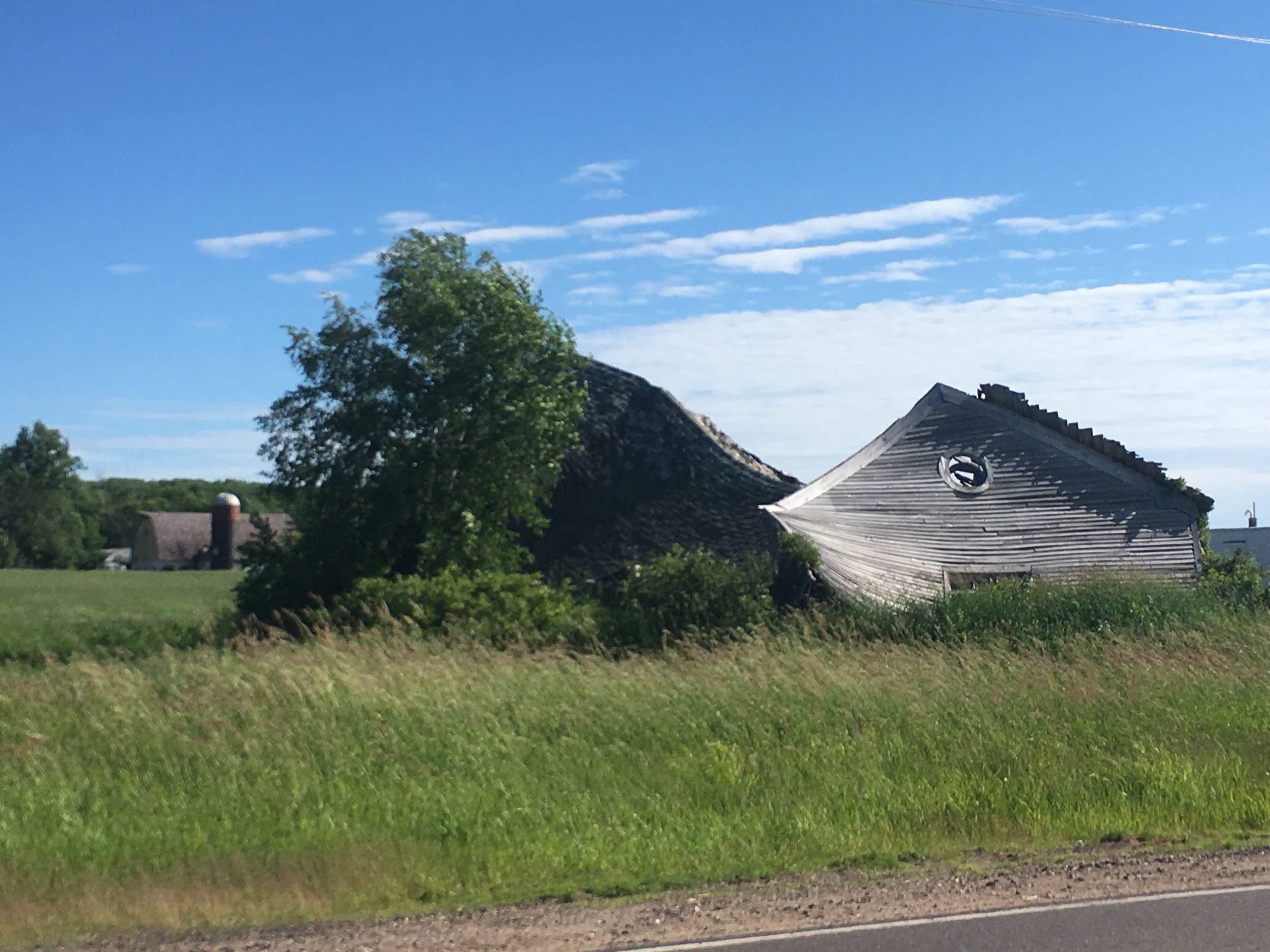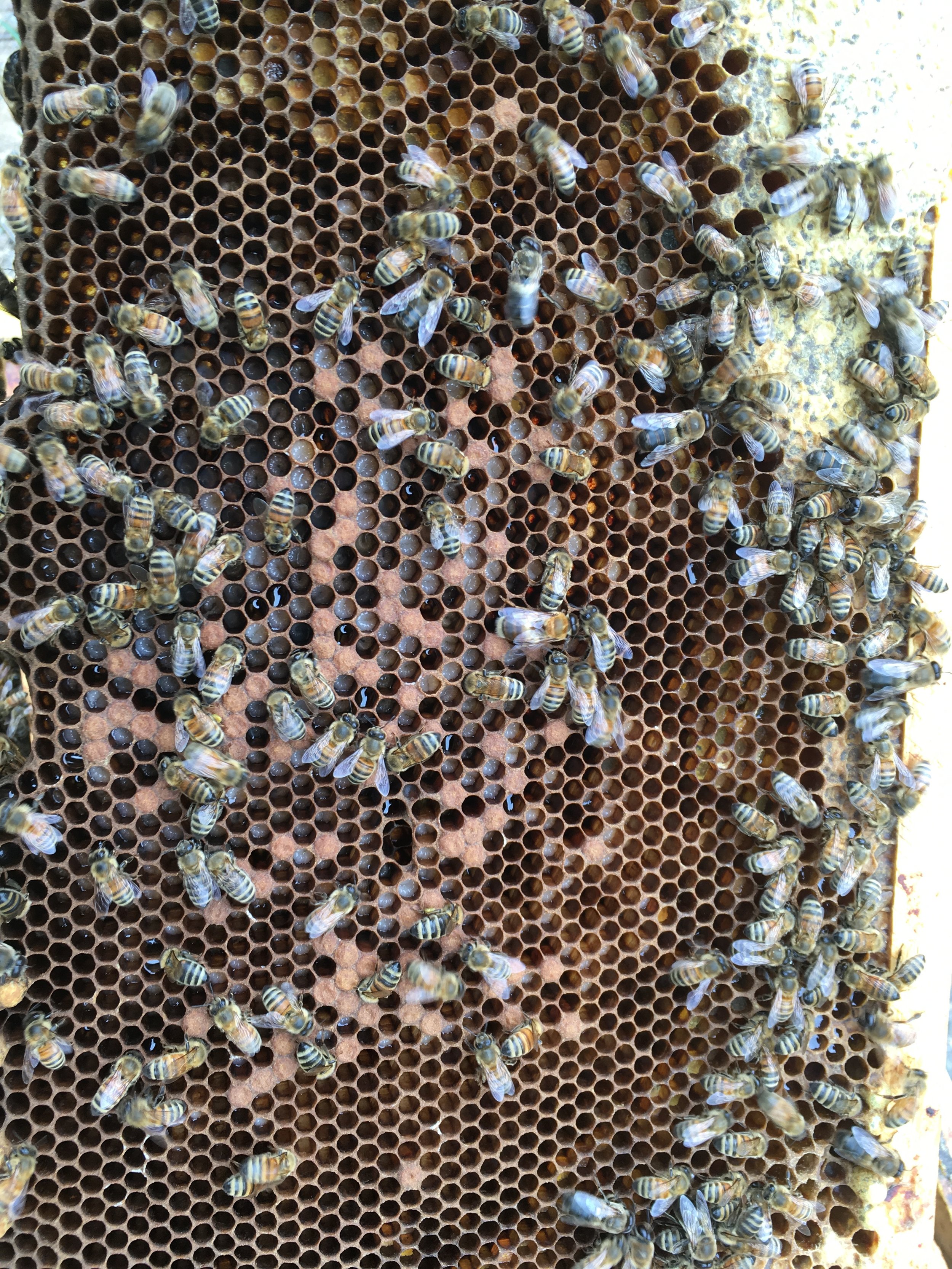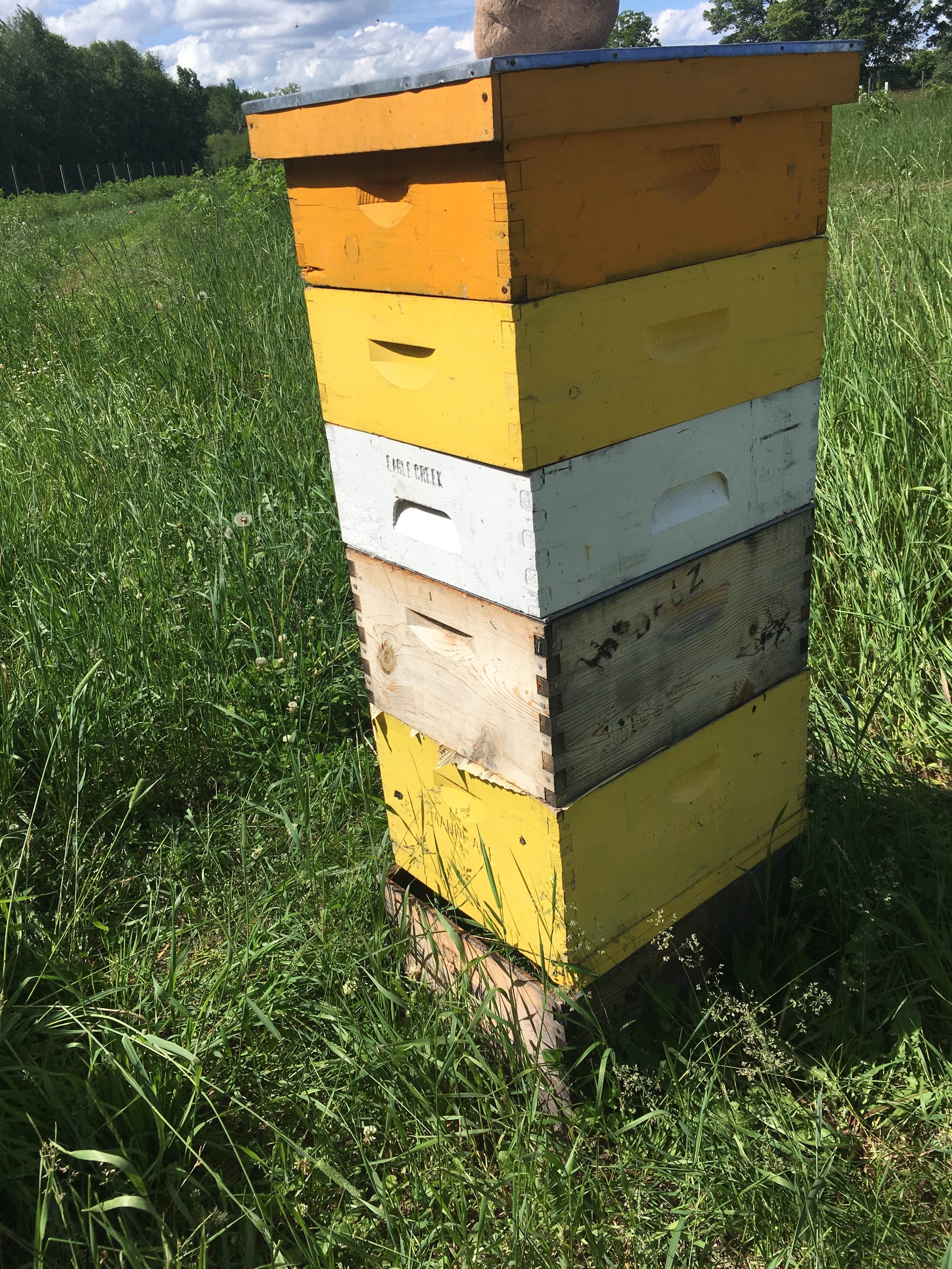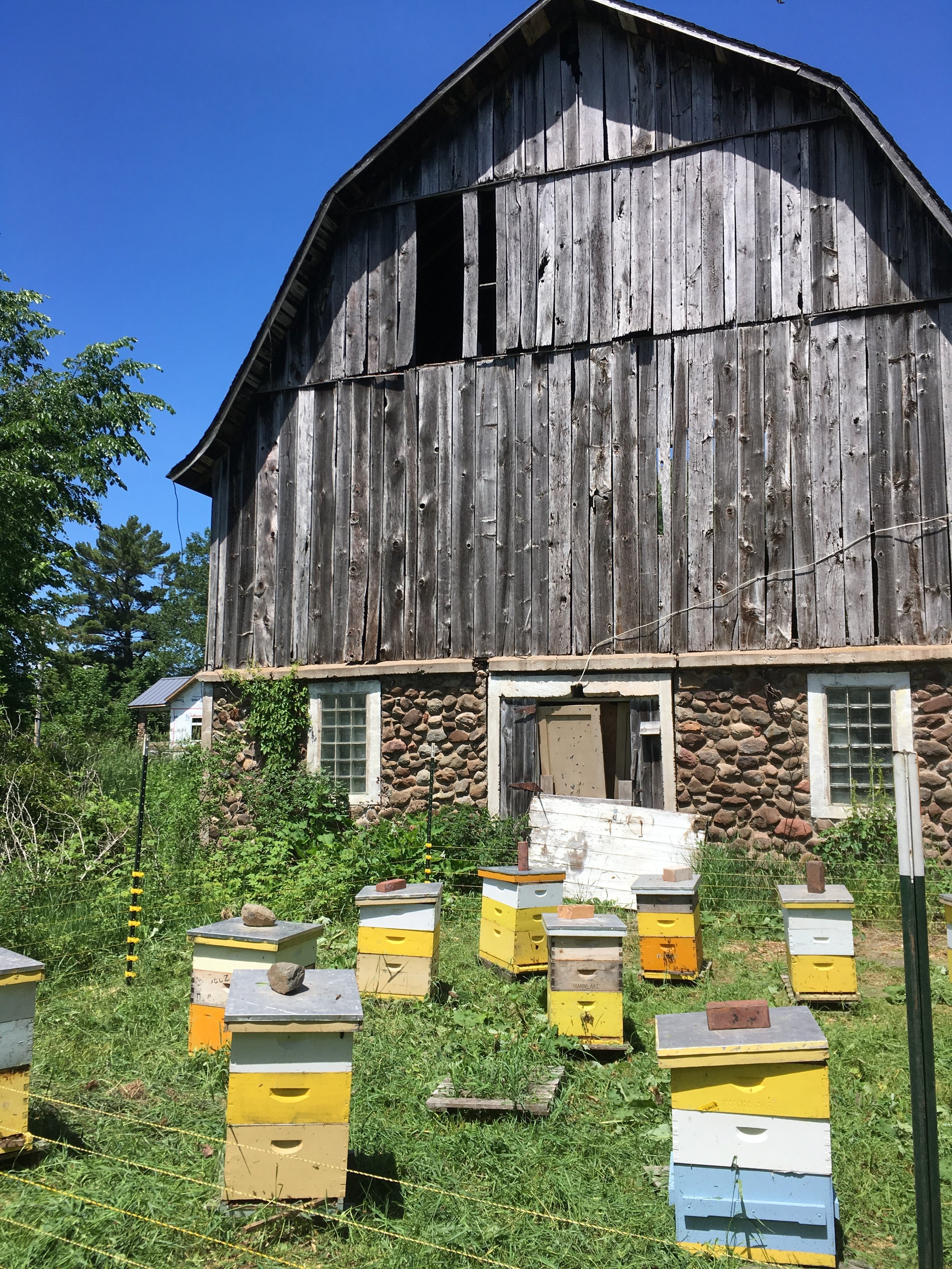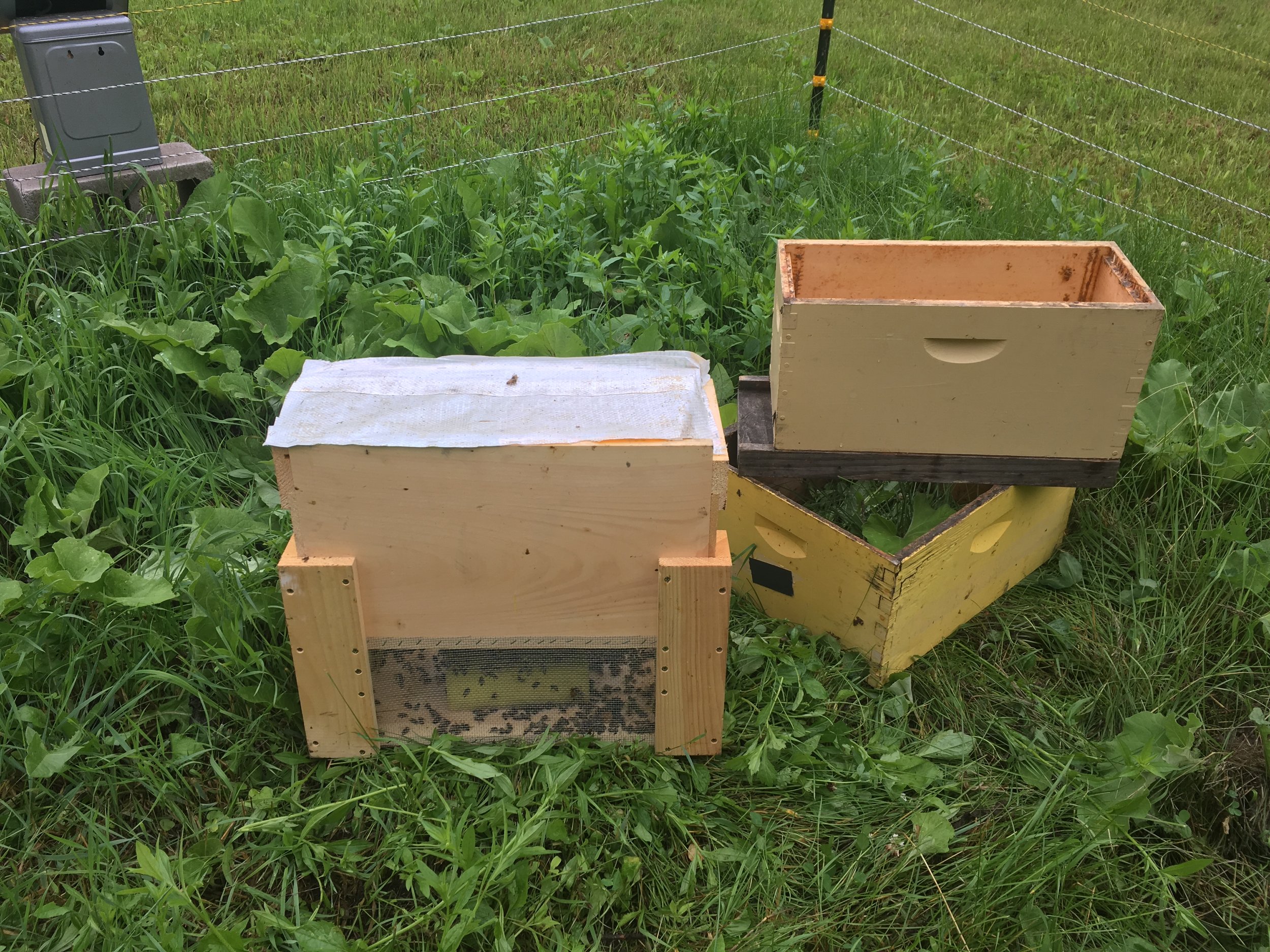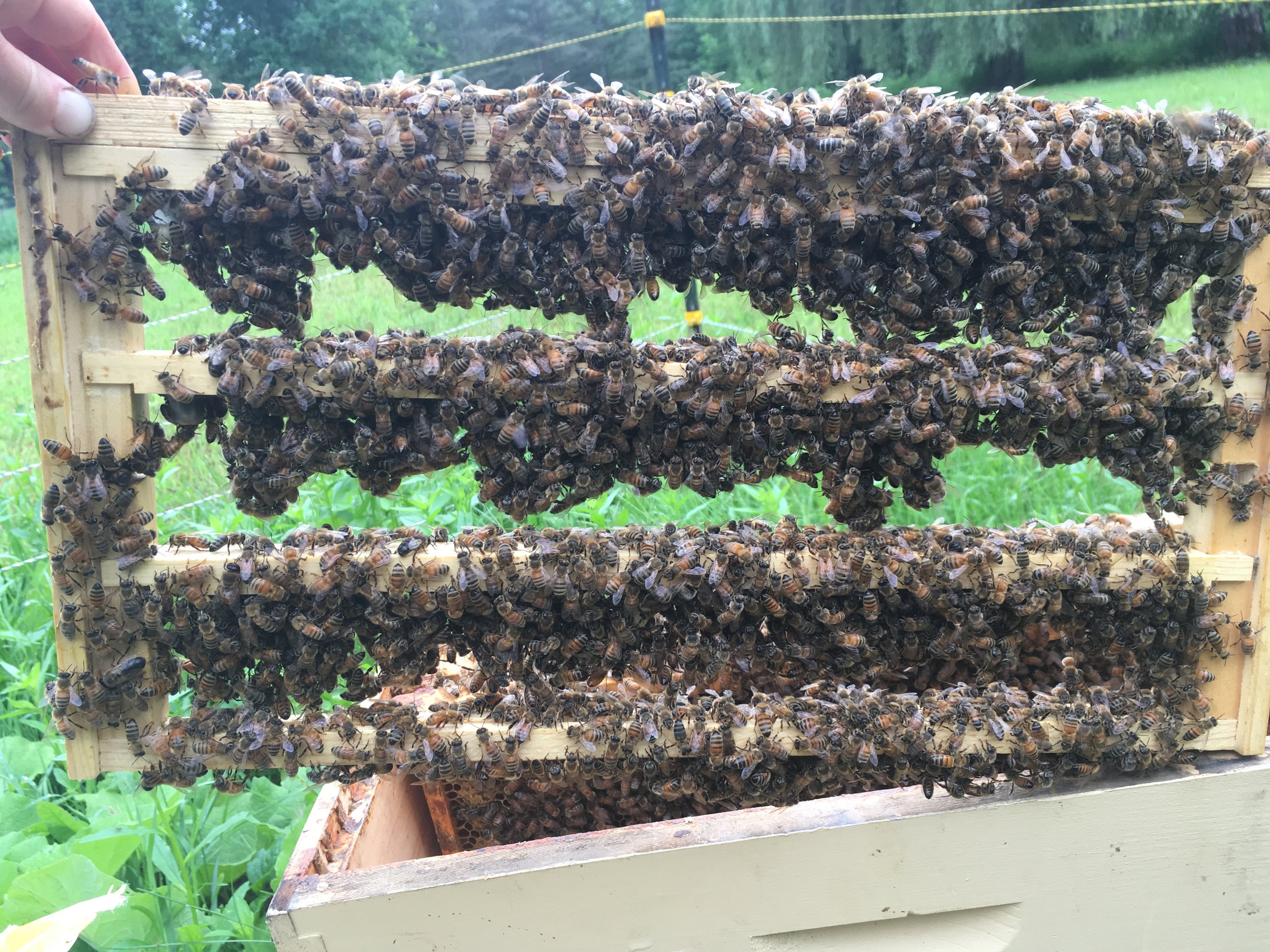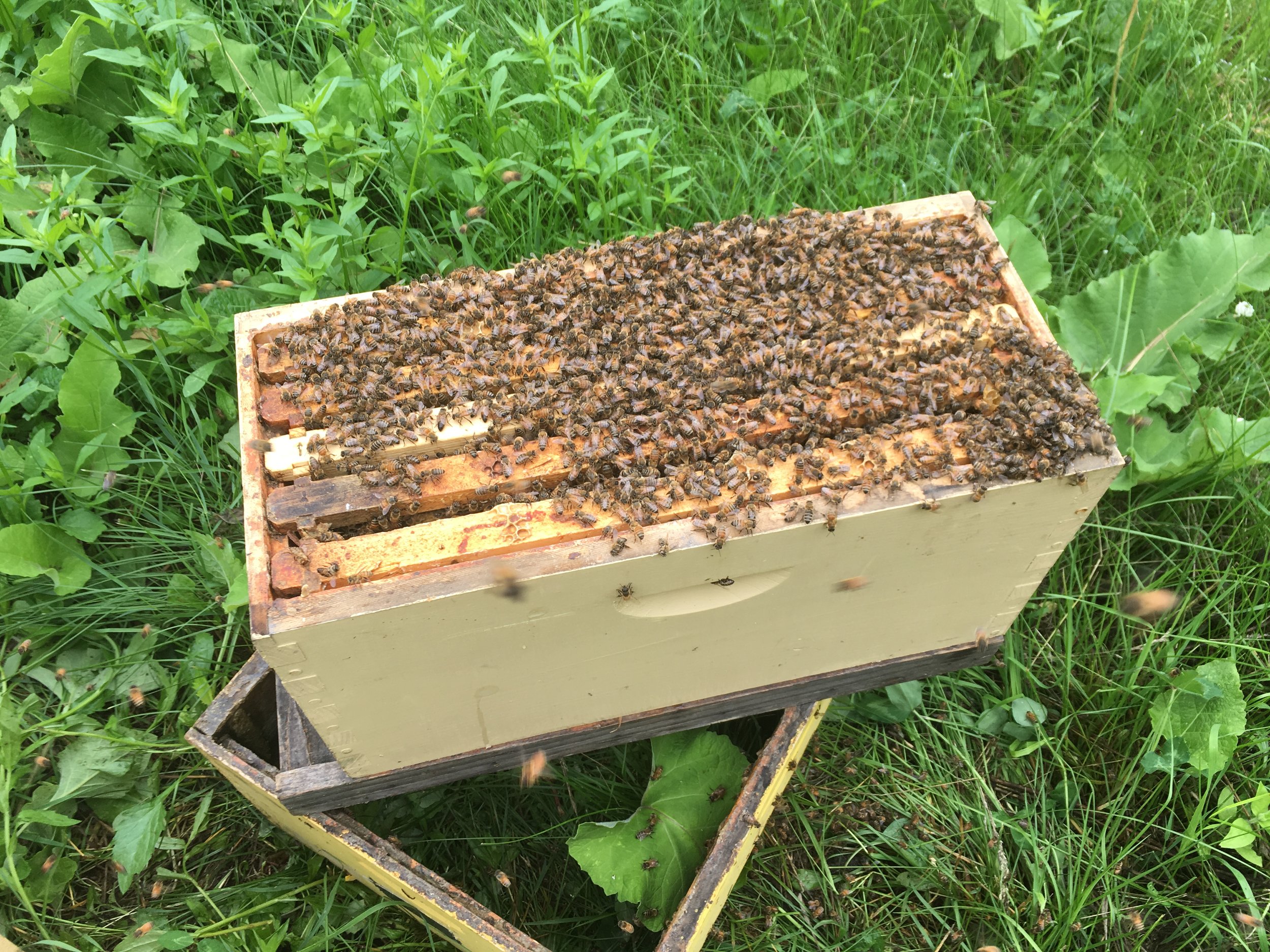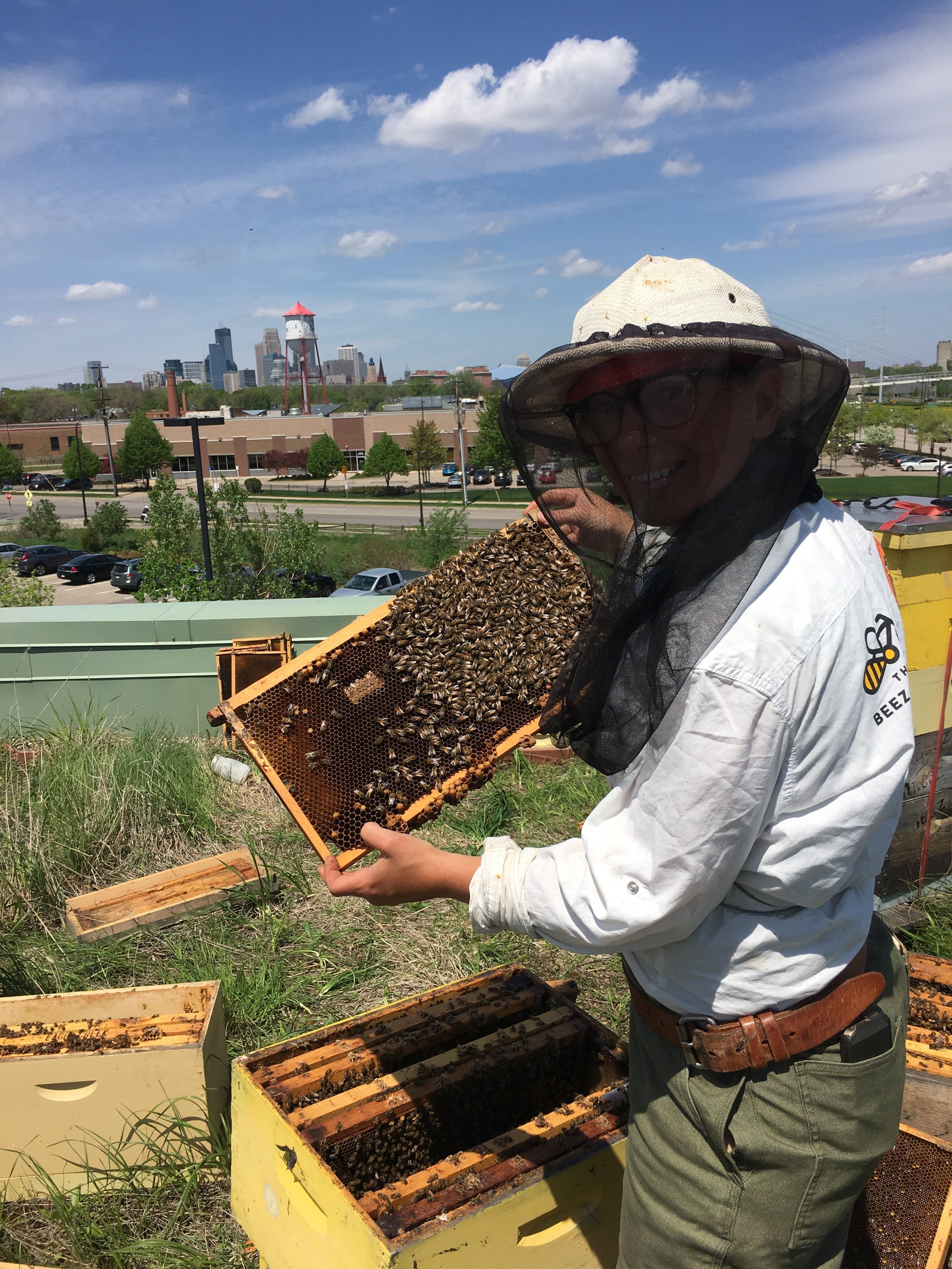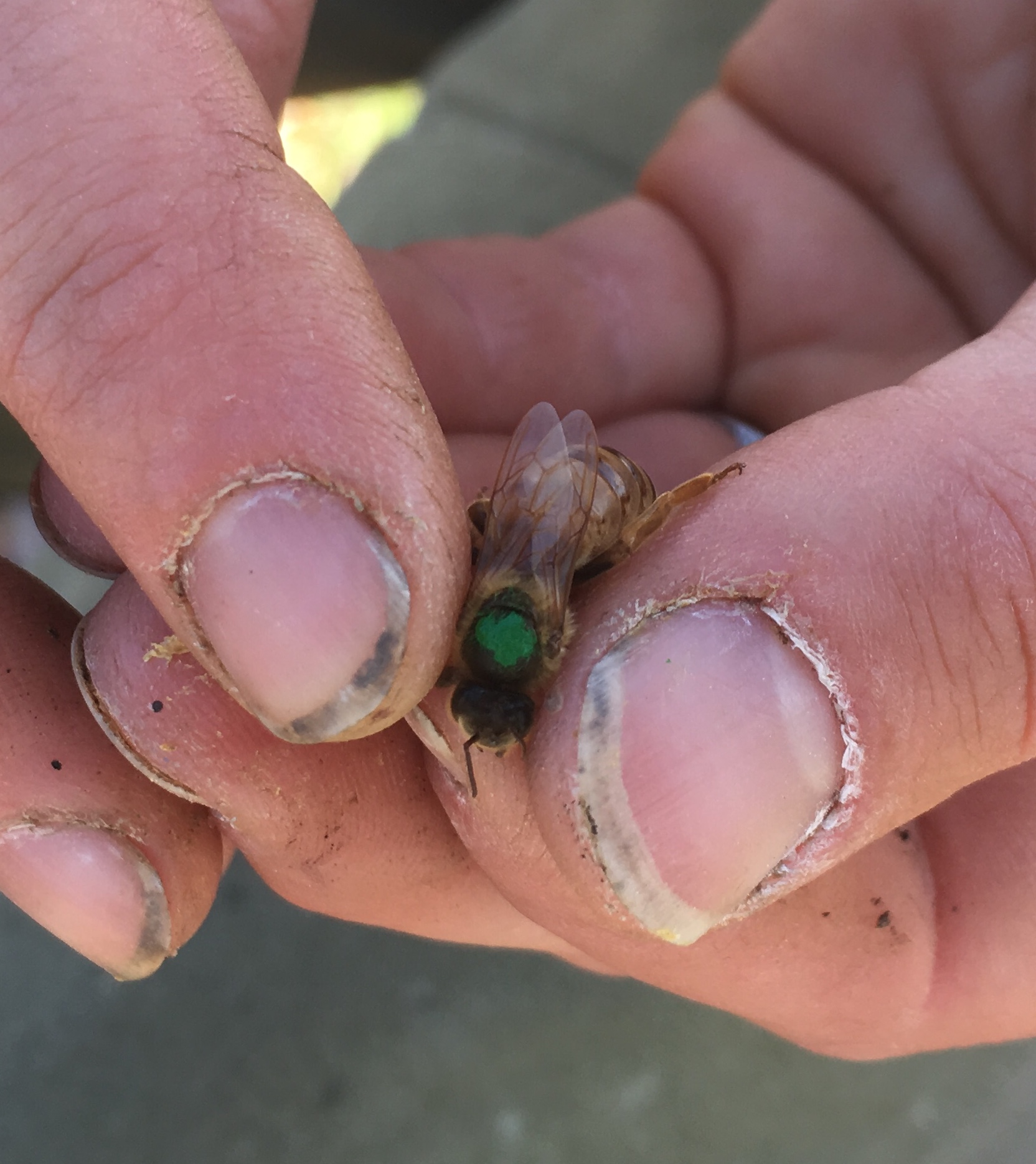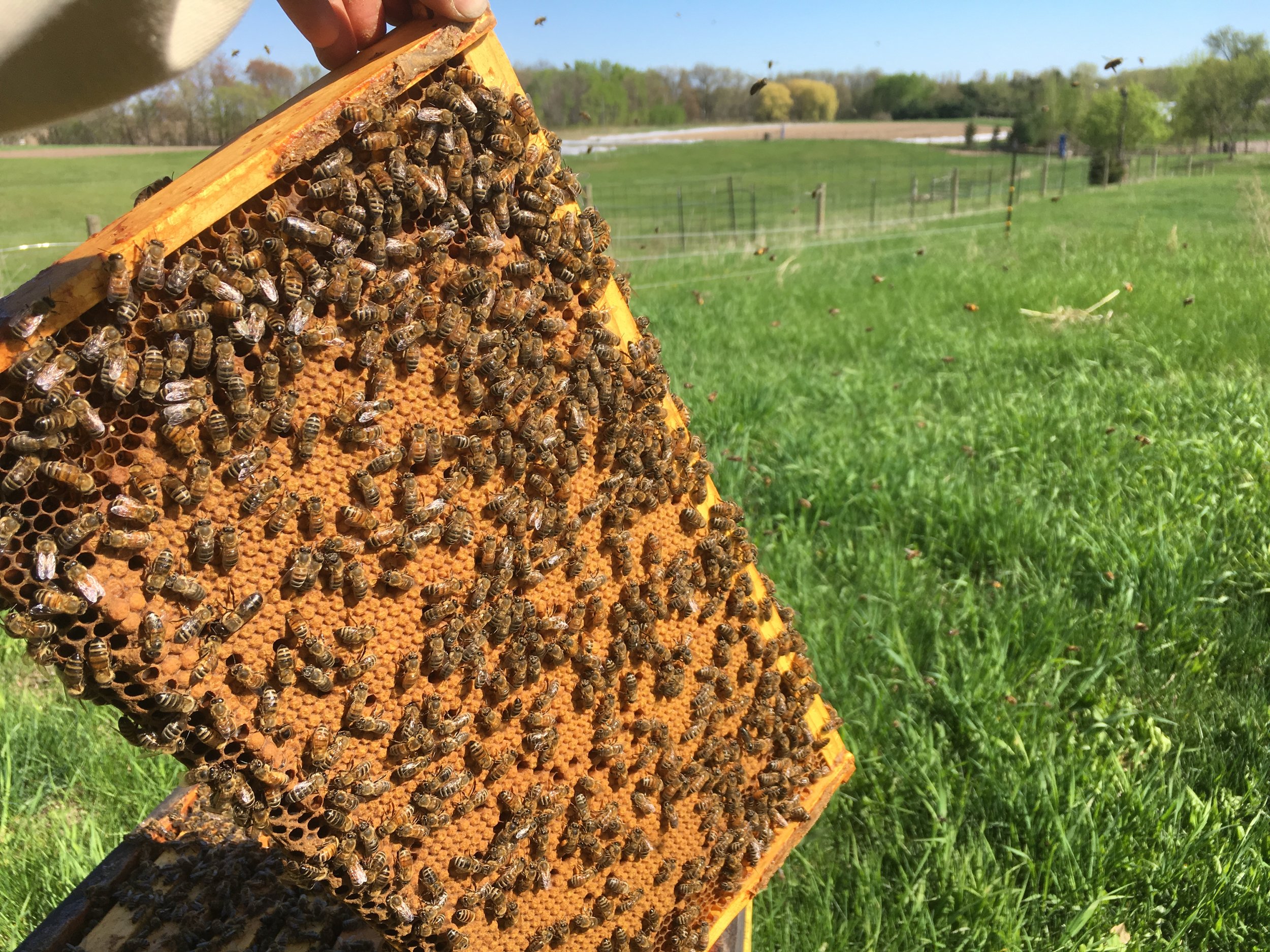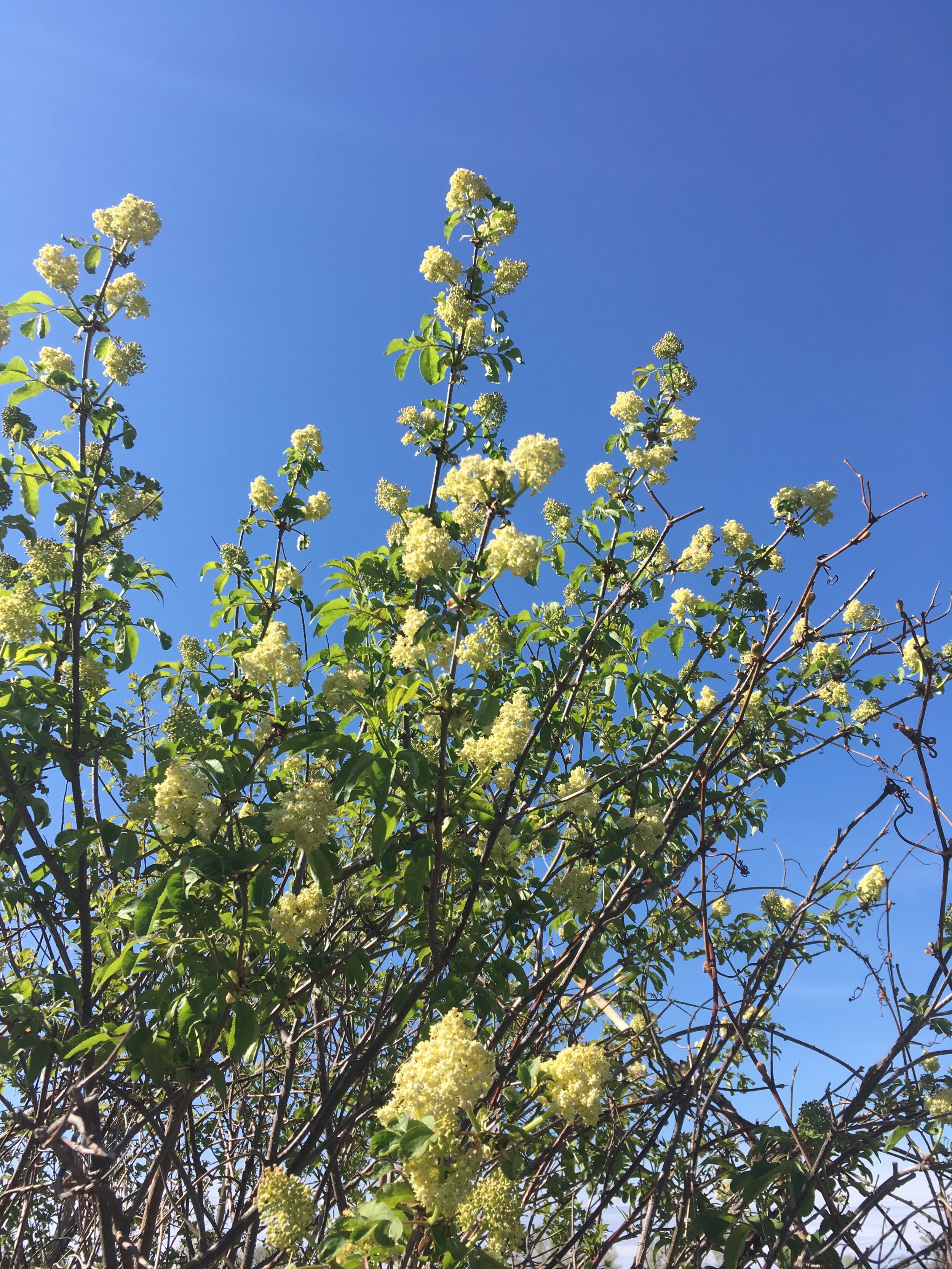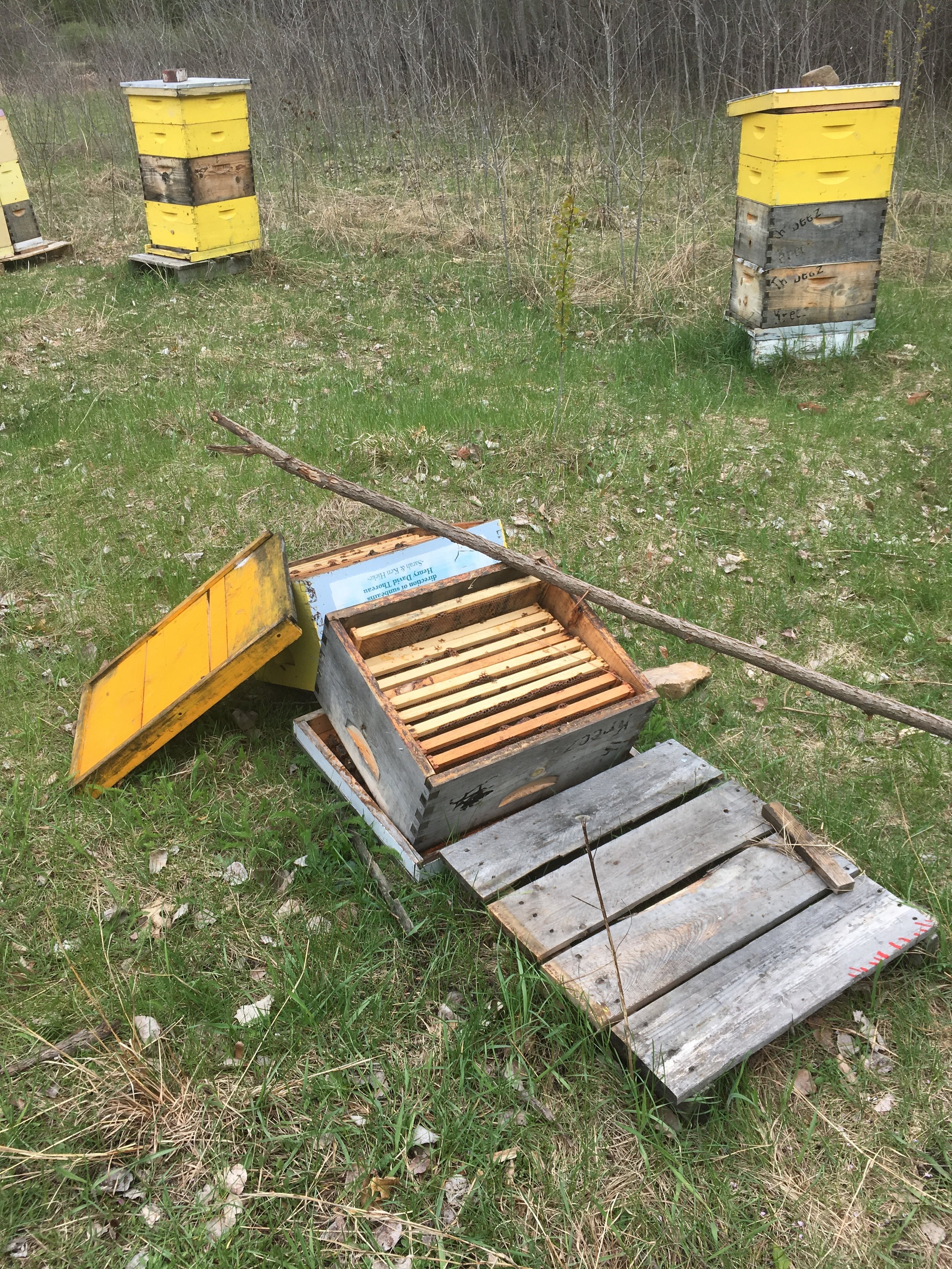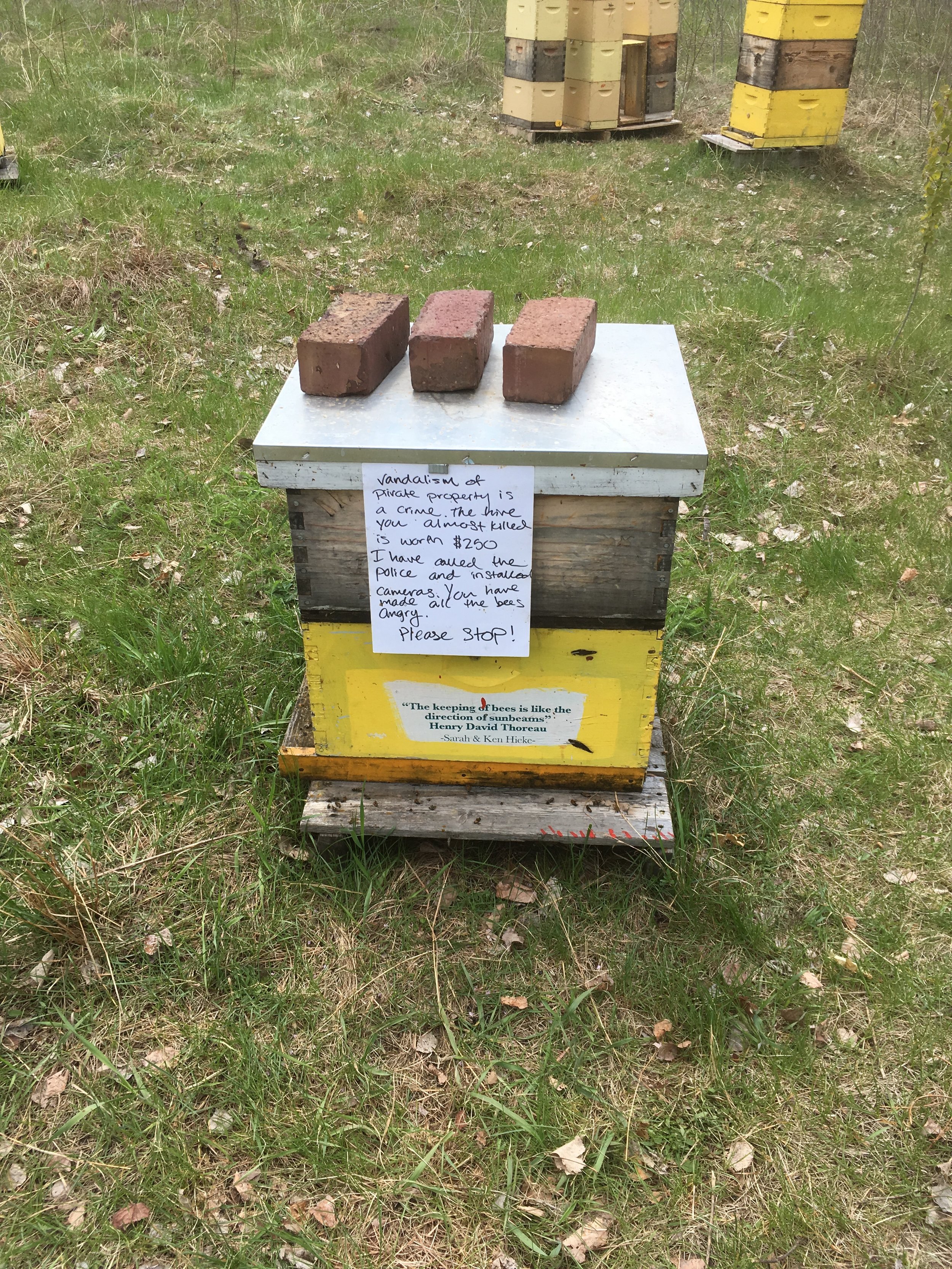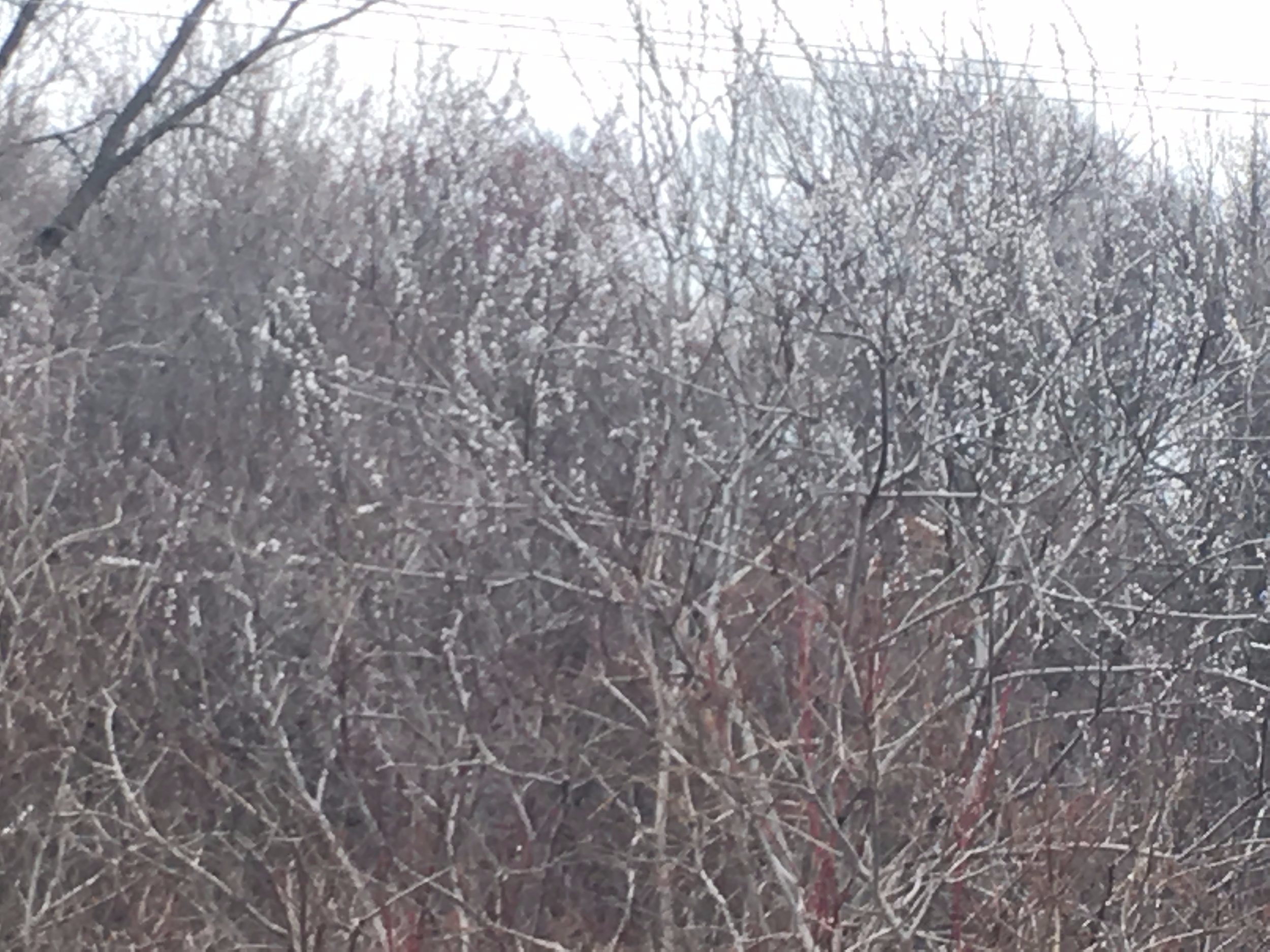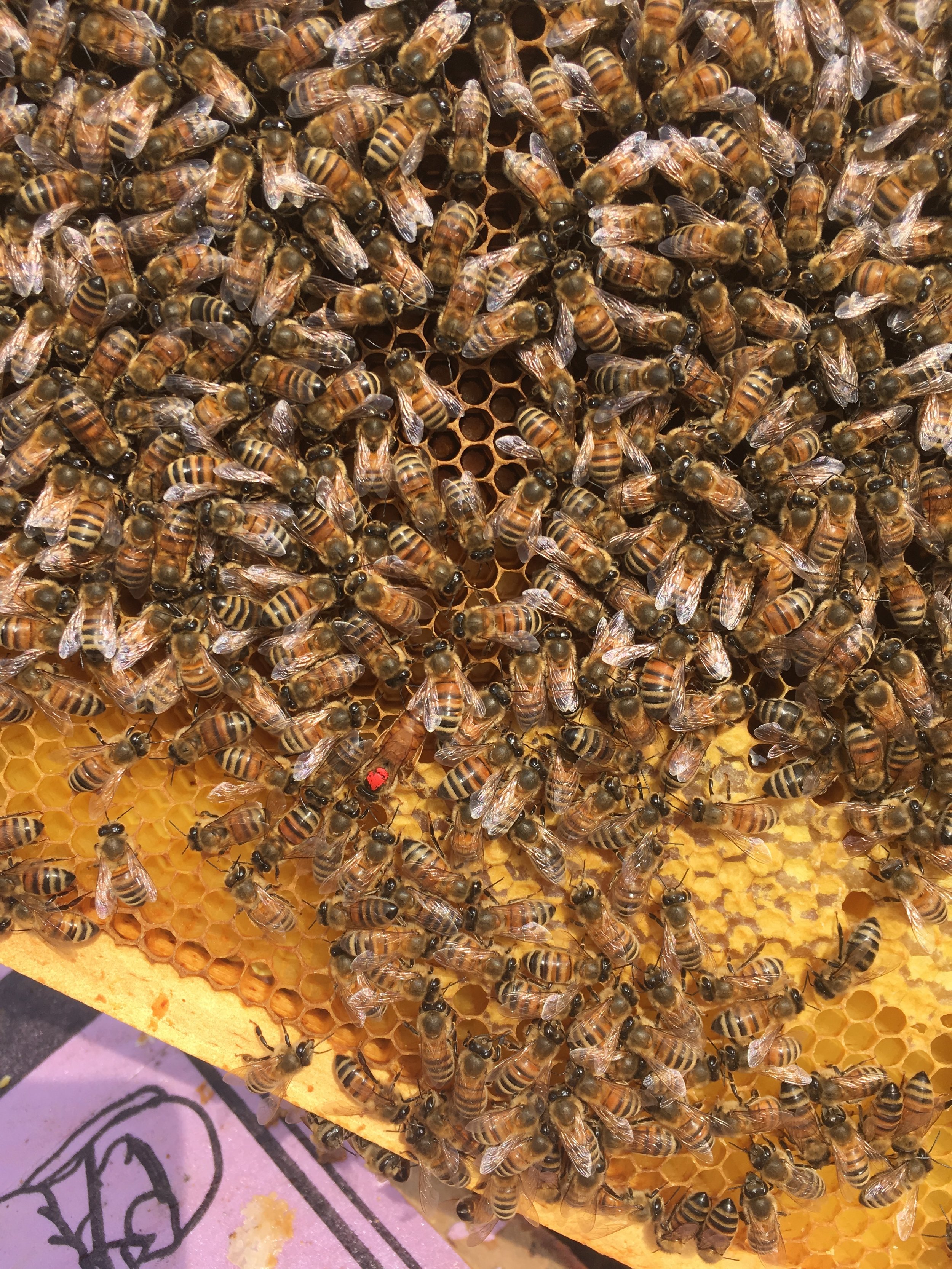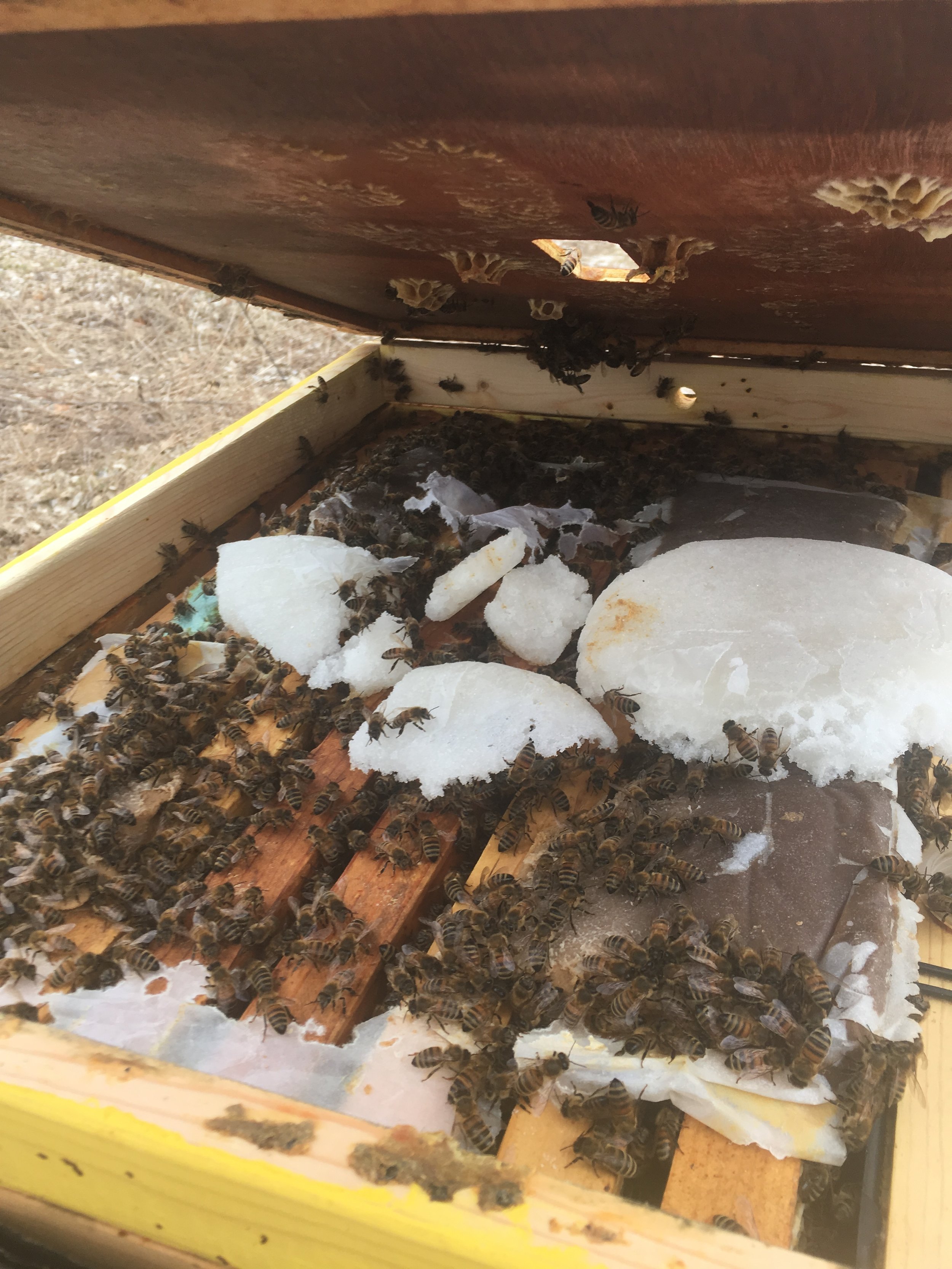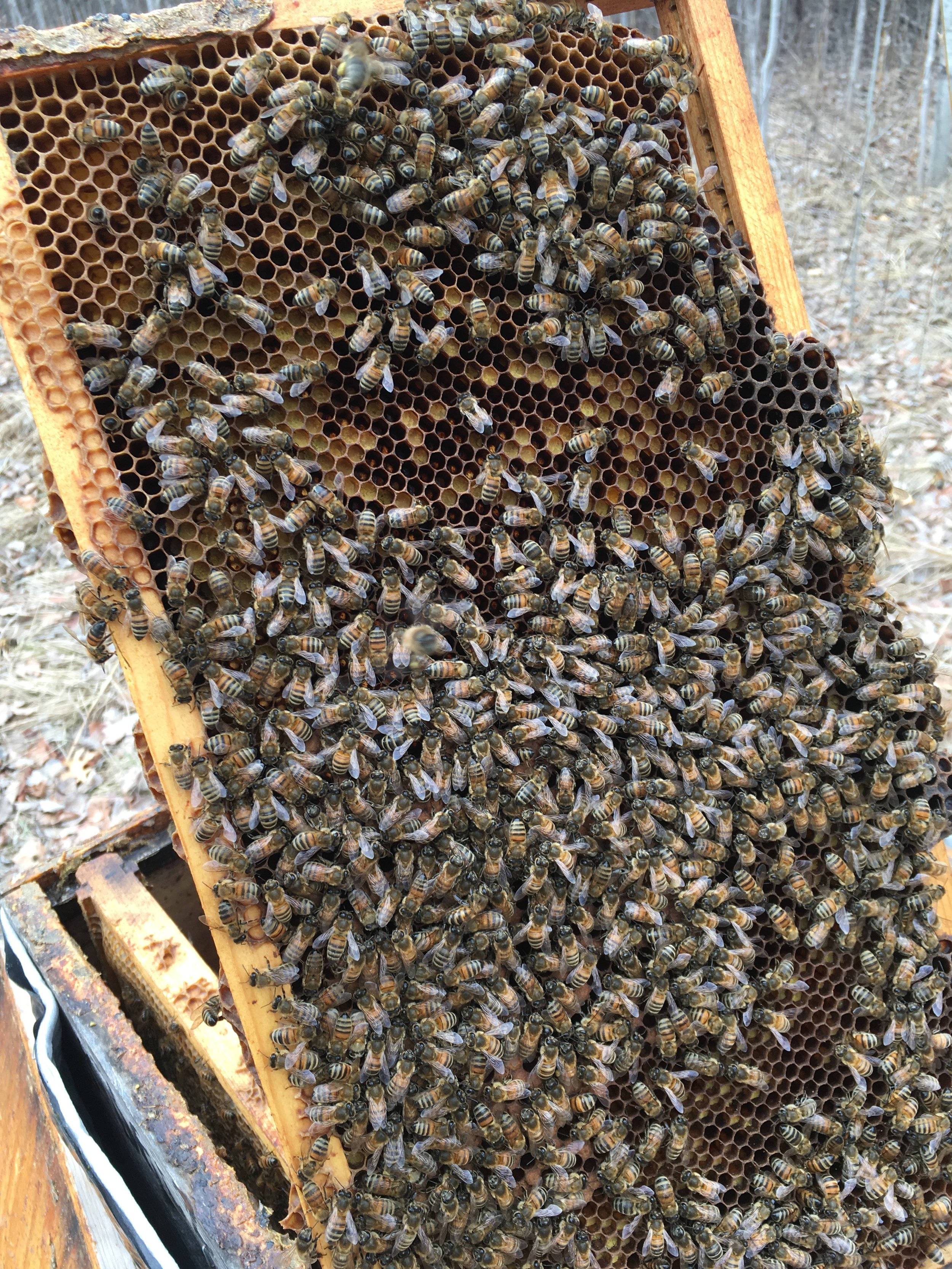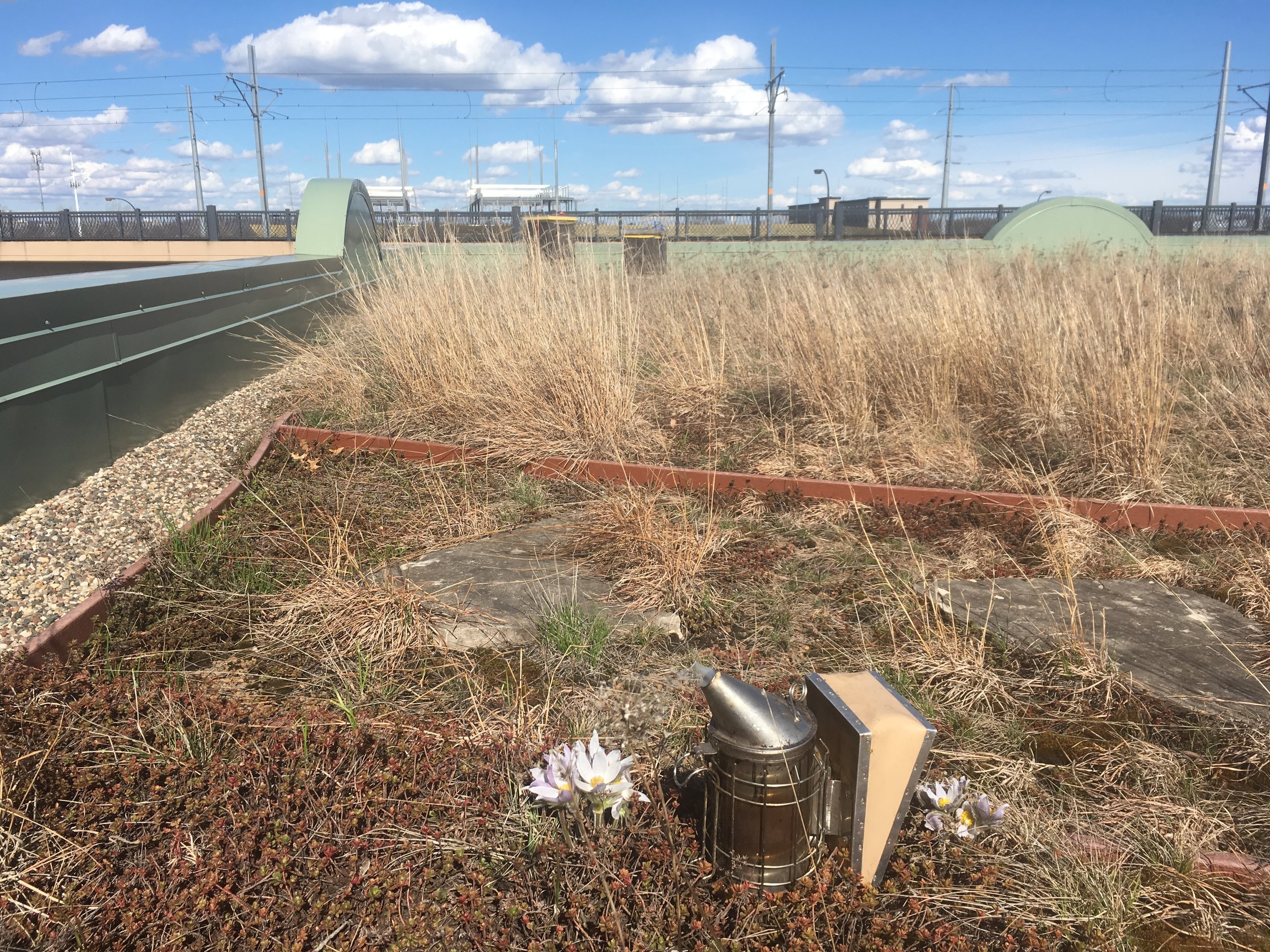COVID-19, Spring Equinox, Hungry Bees, Propolis Box year 1, , Oh My!
Well Beeps, here we are. It is March 17th, 2020 and we are facing a global pandemic. Amazing what can happen in just a month. There is no way I can start writing about the bees without getting this out of the way because it is on all of our minds and changing our daily lives in dramatic ways. As the bees face their own public health crisis concerning viruses, we are in the midst of nothing any of us have experienced on such a scale. In this time of anxiety and uncertainty, I will tell you one thing. The bees are keeping me calm, grounded and continue to teach me how to live as a community. We must take care of ourselves and each other as best we can for the sake of the whole. As a small business owner, I am really concerned about making it out the other end. I am committed to do everything in my power to soldier on and keep The Beez Kneez alive while keeping everyone safe. This is why I have decided to keep the INSIDE OF MY shop closed to customers. Orders can be made online or by phone for pick up. A few of you have reached out already and committed to buying equipment. I feel fortunate to have you as part of my community. Thank you. It will really help us come out the other end of this. Anything you need, you can order online and pick up at the store by appointment. If you want to talk bees, call me during my office hours. Wed-Sat 11-6pm. 612.806.2582 or 612.990.9770. If you want honey, you can pay by phone and pick up in the entryway. We will get through this stronger and better. I am convinced.
WHAT ARE THE BEES DOING IN MARCH?
After a warmer than average winter, this spring is shaping up to be pretty nice. This weekend is the spring equinox and by the end of this month, we should start seeing natural pollen coming into the hives. We have maple syrup flowing up here in the hinterland. This week is supposed to see some rain and maybe a little bit of snow but next week temps rebound into the mid-40’s. The bees are moving through stores much faster now. The temps are above freezing almost everyday allowing them to break cluster and access whatever they can find in the hive. They are regenerating their populations to have the younger generation take over the workforce. As soon as the pollen starts coming in, they will kick it into another gear.
WHAT IS THE BEEKEEPER DOING IN MARCH?
If you have bees that have survived the winter, get out there and lift that hive like I taught you. By the front and also from the back to see how heavy they are. Almost every hive that I have lost this winter has been from starvation. I have learned my lesson this year. I will be feeding a bit more in the fall. I don’t totally blame myself because our falls have been pretty weird and cut off quick as of the last couple years. Make your own sugar cakes using the recipe provided in the March 2019 post or order some winter patties from us. I would wait a few more weeks before feeding syrup. We are not out of the woods concerning cold weather as of yet.
For those of you without bees at the moment, use this time of social distancing wisely. Get your equipment cleaned out and ready to go. The recommendation is to cycle your brood frames out every 3-5 years so many of you are probably ok reusing those. You can feed honey frames from dead outs to new colonies. I would not recommend trying to extract and consume it at this point. Store everything in a dry, cool, mouse proof environment until your new bees come. Remember, drawn comb is a valuable tool when getting new bees. They will grow much faster! Also, take this down time to make a management plan that includes how and when you will manage your mites throughout the season. I recommend once a month checking May-July, twice a month in August and September.
SPRING IS IN THE AIR, DIAGNOSING THE DEAD, WARMER WINTER MEANS EATING FASTER, OH MY!
WHAT ARE THE BEES DOING IN FEBRUARY?
Today my thermometer hit 34 degrees and the sun was shining bright in NW Wisconsin till about noon. The bees were taking cleansing flights and spreading out in the hives to access food stores. According to the forecast, we will be on a bit of a temperature rollercoaster this week. Temps will spike down into below zero at night with highs in the teens for the next 3 days. Then the weekend will be in the upper 30’s, 40 in some places. As we get closer to spring, (only a little under a month until the spring equinox) the bees are gearing up for first pollen and nectar. as you can see from the photos above, They have started to rear brood. Click on the 1st two photos for a closer look. Can anyone spot the queen? I will give you a hint, she has a red dot. Red is the color for 2018. This particular queen had overwintered 2 years and was on her way to year 3 in a 5 frame over 5 frame nuc. Any guesses why this colony died? I found no evidence of mite damage and the population was a good size. Picture #3 will tell you. The only food I found was that tiny patch of honey on one frame down below and there were many bees that died with their heads in the comb. That’s right, they starved. This time of year is when the bees are eating more of their stores faster and it is a bit of a balancing act. In retrospect, I should have fed this colony more in the fall but also, because of a more mild than average winter, they have eaten more then they normally would by this time.
WHAT IS THE BEEKEEPER DOING IN FEBRUARY?
I found the dead colony on Sunday. it was alive the last time I checked only a week ago. Since these bees are at my house, i check them more than others. Based on what I saw in this hive, i decided to check the rest of the colonies in my home yard for honey stores. especially the nucs! to check for stores, i simply lifted them up in front to see if they were still heavy. The ones that were super light, would need some help asap. None of 10 frame hives needed to be fed so keep that in mind because I think this is what most of you have. Luckily, i had some left over frames of honey in my pole barn. i would have waited till this weekend when temps were close to 40 to open hives and add honey but I will be out of town. so yesterday, I brought all the frames i was planning to add to hives inside to warm up over night. Then, i waited till the warmest part of the day, loaded up my sled(see picture #4), lit my smoker, brought my bee brush and veil. In addition to lifting the hives to check for stores, i smoked the bees down and looked at the top of the frames for capped honey. If I saw none, I removed the very outer frame and replaced with a frame of honey. when shaking the bees off of the outer frame I just removed, i placed an empty nuc on top of the hive to act as a funnel and shook the bees off of the frame and inner cover. I used my bee brush to get any bees that did not slide down my “funnel” back in the hive. Once they hit the ground, it is unlikely in these temps that they will make it back in the comfort of the warm hive. You may be thinking, what if I don’t have extra frames of honey lying around? Winter patties and/or sugar cakes on top of the frames will also work. My advice would be to wait till this weekend when it is warm and sunny, add a fedder rim and your emergency feed to the hive. Refer back to my post from March of 2019 for photos and a recipe for sugar cakes. Also, the honey house is stocked with feeder rims and winter patties. Come see us this week! FYI, we updated the website so you can now order online and pick up at the store. You can even enter your 5% Club discount at the check out page.
Besides checking your hives for food stores this month, I highly recommend checking out the following Youtube series. It is about working towards managing varroa mites without chemical treatments and using locally Adapted queens to improve the survivability of your hives. Very encouraging and reinforcing for what Yuuki and Adrian and I have been focused on for the last few years. one of the main take aways for me was finding a way to encourage a brood break in your hive, trapping mites with drone comb and how you can do this and still make honey. Which were my 3 goals last year. There are 4 videos. The one I have included relates to managing your bees based on the knowledge he talks about in other parts. All are worth a watch!
Cleansing flights, frosty moisture, survival in January oh my!
WHAT ARE THE BEES DOING IN JANUARY?
It is the middle of January and a huge snow storm is on the way. Climate change is playing out as predicted with heavy, wet storms and warmer than average temps. For the sake of the bees, I am glad that we have not seen too many days sub zero days in a row. On those warmer days, I have seen bees at all my yards out taking cleaning flights. This is good! Hives that have a lot of brown in the snow in front are a bit concerning but it does not necessarily mean death so don’t freak out. Same goes for the amount of altruistic soldiers that fly out and don’t come back. It is a good survival mechanism for them to not infect their sisters. So some dead bees peppering the snowscape is oddly a sign of life. If you see a big pile, more bees than snow, that could indicate the whole hive was on a kamikaze mission to exit the hive because of virus overload. I know I sound a bit like a broken record, but what concerns me the most this time of year are the vast temperature swings. Since we are past the winter solstice, the queen has started her first round of offspring. They will emerge in roughly 3 weeks, depending on when she started laying. This is a crucial time for the bees as the old bees die off and new ones are born. And the bees must be able to have enough bees and food to maintain temperature and the regeneration of spring bees.
WHAT IS THE BEEKEEPER DOING IN JANUARY?
Since I last wrote, I have been to most of my yards to check for signs of life. On colder days, if you see a frosty ring of moisture In the upper entrance, it is a sign of life. The moisture produced from heating the cluster hits cold air on the way out. Hooray! I have several hives that I did not add a top entrance at all, which goes against all the things I taught you but as you probably know by now, ideas and theories about how we should manage bees change frequently. Dr. Tom Seeley has been talking a lot lately about how bees that live in trees need some moisture in the hive and that the bees never have an entrance at the top. My hives without top entrances are still buzzing…I will keep you posted on how they turn out. I should note that the hives I tried this on where smaller units like nucs, singles or a single and a super. I have also been checking food stores simply by gently tilting them forward.
In my recent checks, I have discovered 5 of 120 hives dead. I feel pretty good about this number but don’t want to get over confident. 3 of the 5 were not surprises. They were hives that could have used a little more TLC in the fall. One was definitely a result of virus. I have been hearing about a lot of losses by beekeepers in my network already and fully realize I am not out of the woods yet. Although making it past New Years is a good sign, many of my hives that died last year did so in the 1st week of Feb after we had a crazy subzero cold spell. Remember that all beekeepers lose hives. It is a hard thing to go through but we must learn and move forward. At least that is what we tell each other, especially during the harsh, dark winter. We are only 64 days away from spring when we get to try all over again.
For now, I am organizing, assembling and prepping equipment. Remember, DO NOT WAIT TILL THE LAST MIUNTE to have your equipment ready. Let me know if you need anything special. We are stocking the store with goodies in the coming weeks. I am also making new presentations, reading and planning beekeeping classes.
2020 Classes from Beez Kneez
Beekeeping Equipment workshop for Beginners:
Saturday, January 25th at 2pm-4pm
Location: The Beez Kneez Honey House
In case you missed this workshop last year...
Nuc Workshops: Managing a Sustainable Apiary by Utilizing Nucleus Colonies
Saturday, May 23rd 2pm-4pm and/or Saturday July 11th 2pm-4pm
Location: Lily Springs Farm Osceola, WI
Snowshoes, New Bee Year Resolutions and Winter Party this Friday at The Beez Kneez Oh My!
Well beeps, here we are. As I write, the snow is falling and a few days of record cold temps for December will present the first major challenge our precious, little bees. Let’s cross our fingers for a quick winter and early, long spring. It is already cruising by. We are just 13 days from a turning point in the season in the hive. Does anyone know what it is? Read below to find out!
WHAT ARE THE BEES DOING IN DECEMBER?
As I just mentioned above, we are 13 days from a change in the hive. December 21st is the winter solstice. The bees get the cue from the sun changing in the sky. The minutes of daylight increase and they are already thinking of spring. The queen will start laying her first round of brood as the older bees slowly die off. The cluster will remain really tight on these super cold days and expand out a little to get much needed energy from stored honey in the frames on the warmer days. I just learned that bees interlace the hairs on their bodies to help heat the cluster! Check out this article from Bee Culture that explains it and how bees conduct heat, deal with moisture and the need to increase the R value when insulating the hive.
WHAT IS THE BEEKEEPER DOING IN DECEMBER?
As you can see from the photos above, I have been making the rounds to my Wisconsin hives in my new yellow and black snowshoes! I did not manage to get out to all my hives but I did make it to the ones that are the furtherest north to give me an idea of survival thus far. Every hive I checked on, was still alive and buzzing. I did find one or two that gave me a little bit of concern in the number of dead bees in front of the hives. My plan is to return every month this winter to see who dies when. This does not mean I open the hives! I just listen. Then I can look back at my notes and make observations based on my management and mite levels.
There is a common theory that if your hives are alive after the New Year, they have a good chance of making it to spring. That they did not succumb to virus from mites. The challenge after the New Year is one of food stores. As the bees continue to brood up, they eat more of their food. Keep in mind that a lot can happen between January and April. So in the month of December, the beekeeper should start reflecting on the 2019 year of beekeeping and making a plan for 2020. What is your 2020 New Bee Year resolution? Use the google group to share when you can! We can all learn from each other and try to improve next year.
Other than planning my 2020 bee year, I am thinking about other ways I can continue to advocate for bees. I am not sure how many of you are aware, but we are in the middle of a farmer crisis in rural America. In an effort to educate and advocate the beeps in my network, I planned a Winter Party: Holiday Market with a mission. In light, or shall I say the dark of giant corporations taking over food production in a truly offensive and destructive way for the environment. Join us this Friday to learn more about what is going on, how it relates to overall bee health and the health of our food system. You will be rewarded with delicious farmstead cheese and veggies from the farmers, a cash bar and a unique and intimate opportunity to stock up on goods from the incredible farmers I work with to place hives. Flyer below.
PROPOLIS HIVE BODIES, THAT’S A WRAP AND NOVEMBER IS THE NEW JANUARY
For 2 years in a row, November has brought winter to the midwest with a vengeance bringing the bee season to an abrupt end. The weather finally broke yesterday to a balmy 46 after two weeks of hovering in the 20’s. One of those mornings I woke to a below zero reading! The first half of November felt like January. It is too early beeps! The forecast looks mild for the coming weeks. Closer to our normal high which is in the mid-30’s-40’s.
WHAT ARE THE BEES DOING IN November?
Not a whole lot to say here that is different than last month. The biggest difference is that now there is absolutely no pollen anywhere. Because of the abnormally cold weather, bees are clustered tight and working hard to stay warm. Shivering their flight muscles and generating heat to keep their cluster warm. With the break in weather, I have seen bees flying at the warmest part of the day. Taking cleansing flights and cleaning out any dead sisters at the bottom of the hive.
WHAT IS THE BEEKEEPER DOING IN November?
So in a normal year, I would have waited till the end of Thanksgiving to wrap my hives but in anticipation of last years early arctic blast, I decided to insulate and wrap my babies up a little earlier. I provided some examples of wrapped and hives I cuddled together in the photos above. I have had a few of you ask about the moisture/insulation board and where it goes. Insulation/moisture board goes above the inner cover and underneath the telescoping cover. If you are using foam insulation, remember to put duct tape on the board where the inner cover hole is located so that the bees don’t chew it up. If you look closely a the 2nd two photos, you will see a few twigs on top of the pink board. This is to elevate the telescoping cover above the top entrance so air and bees can get out. Don’t forget to put a heavy rock on top so the telescoping cover does not blow away. This has happened to me and the bees were fine but if it had snowed and gotten wet inside, I would have killed my hive! See the photos below.
At one of the Camp Beez Kneez teaching sites, we worked together to move all the hives in front of the old silo because of the incredible wind break provided by the stone wall it sits on top of. I included a picture of us using a hive carrier to show you an easy and proper way to move a colony. We sell these at honey house and they are excellent for moving a heavy hive with 2 people. A few tips on safely moving hives. 1-use a ratchet strap and make sure it is cinched down tight. 2-close the entrances with grass or duct tape to avoid any overachievers from coming out and trying to show you who’s boss. Never never never close your hive up completely if you must move it in the summer time. This is why screened bottom boards are nice. If you don’t have one, you can cut out old pieces of window screen and staple them over the entrances so bees can breath but not get out during the move.
Moving the hives closer together and in front of a winter wind break also gave me the opportunity to feel how heavy each hive was going into winter. If your hives are light and you think they may starve, reference my blog article from March 2019 for winter feeding instructions and recipes. We sell feeder rims and winter patties at the shop. If you have not done this yet, it is not too late. Use this week of milder temps to quickly give them some insurance food. But remember that you will be breaking the propolis seal between the inner cover and the hive body. After adding your feeder rim and winter patty/sugar cake, reseal by wrapping syranwrap to help keep the warm air from escaping. The bees will not be able to do this on their own with propolis before spring.
Besides wrapping, I am finishing giving any hives an oxalic vapor treatment that I did not get to before the temps dropped. I only got to half of my hives before the cold snap so I plan to go out again this week and hit any I missed. When using oxalic vapor, the daytime temp needs to be 37 degrees at application time plus two hours after. Check out this video one of our students took of oxalic vapor treatment.
Other than that, I am resting up and already planning for next year. I provided a few pics of the inside of the propolis hives bodies before and after (photo credit to The Beez Kneez and Abundant Harvest Farm). We put the bees in the special hive bodies this May. By September, they have already built a lot of propolis. Can’t wait to see what they do in year two. I plan to change all my hives over to propolis hive bodies. I am also in the process of cycling out old frames. Pesticide residue and disease can build up and make an unsafe environment for raising future generations. That means I will be building and wiring hundreds of new frames. Bees face so many obstacles in our current environment so I want to give them the best chance to succeed. Cycling frames and allowing them to fill their hive with natural defenses is something I can control.
I am also planning to teach a few classes over the winter. Stay tuned for dates coming soon!
Fall back, my sweet bees.
May you spring forward after the long, dark, flowerless night.
Well beeople, the weather is about to take a turn towards coldville. Today is forecasted to be the last day above 50, let alone 45 for awhile. Does that mean it won’t warm up again? Not necessarily. I remember keeping bees in a t-shirt on Thanksgiving one year at 60. Anything seems to be possible with the weather these days. And as beekeepers, we need to be very aware of this. I was talking to a farmer friend of mine yesterday and we agreed that the last 2 winters have been suggesting a loss of our shoulder seasons; spring and fall. We need these times of transition to adjust and so do animals. How does anything acclimate into our harsh winters or hot, wet summers without a gradual change? The unfortunate thing about the these vast temperature swings is if the weather is too cold this time of year and the bees are light on stores, it is harder for them to take it down and process it in time for winter. If it is too warm in the fall, they will eat through more of their stores because they are active and there is little forage.
WHAT ARE THE BEES DOING IN OCTOBER?
In the month of October, the bees are acutely aware of scarcity and winter prep. Most bees anyway. This is why we stopped keeping Italian honey bees that don’t get this cue. They can eat their winter stores too fast and run out of food before spring time. i have even seen them do it in the fall. Anyway, what your bees should be doing is slowing down and completely stopping brood production. There really is no food out in the landscape, unless they are robbing from other hives. There can be a little pollen. I have seen pollen coming in the hive as late as mid-October but it is not nearly the amount that would make them keep rearing brood. They are curing the last of the nectar or feed that is already in the hive and clustering at night when temps dip below 40degrees.
WHAT IS THE BEEKEEPER DOING IN OCTOBER?
This is a bitter sweet time for beekeepers. Time to say goodbye to your bees till spring. There is no reason to be pulling frames out and inspecting the inside of your hive in October, even if temps are above 50. They have worked really hard to seal everything up with propolis. If you do too much pulling apart, they will not have adequate time or heat to make that propolis seal work around all the drafty spots in the hive. If you did your best to keep them healthy in the summer and early fall, left them enough food/fed them to weight if they ate too much or got robbed out, and made sure they had a nice, productive queen, there is not much else to do except wrap them up. Yuuki likes to say “It is about what is inside the hive.” There are several materials and ways to wrap and insulate but what is most important is whether or not that hive is healthy and has a nice population relative to the size of the box you put them in.
But, I will share with you some things I have been doing to my hives starting yesterday to prepare for winter.
At this point, all feeder pails should be off the tops of the hives
Your hives should have 1 top hole and 1 bottom hole for ventilation. I use the small or medium space(either will be fine) on the entrance reducer for the bottom hole and then drill a small (1/2 inch hole in the top box above the handle for the top hole if you don’t have an inner cover with a hole).
Above the inner cover, but below the telescoping cover, I place 1 sheet of R5 insulation with a piece of duct tape to cover the spot where there is a hole in the inner cover so the bees don’t chew it. I wrap the whole hive in tar paper or a winter wrap (we sell these at the honey house insulation =$10 and wrap for $14).
Place a mouse guard over the bottom entrance. I use 1/2 inch hardware cloth because I have many hives. We sell really nice mouse guards at the honey house if you have no need for excess hardware cloth.
This year, I am moving all hives together for extra protection from the wind and to provide a little extra heat using the buddy system.
Hives will benefit from a northern wind break. I moved all the hives in front of this barn. You can use straw bales or something else just to keep the wind out.
I am also treating my hives with oxalic vapor. The late mite explosion and robbing this year makes me want to do a clean up of any mites that are on the bees bodies. Remember, even though those mites cannot multiply without brood, they can still injure the bees by sucking on the fat bodies, weakening those really crucial winter bees. Plus, I like knowing the hive will come through the winter with very few if any mites. Here is a great, detailed info sheet about Oxalic Vapor. It is not too late to do this. In fact, low temp for treatment is 37 and has no cap on the high temp.
Next month, I will include some information on emergency winter feeding if your hives are too light. Also, stay tuned for some winter classes at the honey house to keep your beekeeping mind fresh. Remember, this is a life long learning process with many rewards and many set backs but if you stick with it and keep trying, you will do nothing but improve your skills as a beekeeper and keep learning from these incredible animals.
MITES, MITES, GOLDENROD, GOLDENROD, OH MY!
I have seen the leaves changing on some maples and the goldenrod is lighting up the fields. We are in the home stretch of hive management but we are not done yet! Between now and my last post, the goldenrod started flowing making the bees and this beekeeper very happy. Have you visited your bees in the last week and thought to yourself, what is the smell? Some say sweaty gym socks, I say the aroma is yeasty and delicious. Pro tip-you know when the goldenrod is producing nectar, the smell is very obvious. You don’t even need to open the hive to smell it. Hutty says after this period of rainy and cool days passes, the forecast looks mild and warm. We will hit 80 again! This should keep the goldenrod flowing a bit longer and help the bees cure their winter stores.
WHAT ARE THE BEES DOING IN SEPTEMBER?
The queens are laying their last generations of workers but I am still seeing a decent amount of brood in the hive. They are starting to evict the drone bees little by little to slim down the hive of any “free-loaders”. The foragers are working super hard to get every last drop and every last pollen grain they can, whether it bee from the fall flowers of goldenrod, asters and sunflowers or the remaining summer flowers. There is still a little clover out there. They are also fighting with the varroa mite! Again, the queens and bees are slowing down and the mites are not!
WHAT IS THE BEEKEEPER DOING IN SEPTEMBER?
Mite checks, mite checks, mite checks. I have seen a significant jump in numbers in some of the hives. From 4/300 to 16/300 in just a few weeks. The treatment threshold is 9/300. Some have had 25 or 30! I have been using one strip of Mite Away Quick strips. I will test again in 7 days to see if the treatment worked and then make a decision on what to do next based on the results. I will either follow up with another strip or wait till late October(when the hives are broodless) for oxalic vapor or dribble. The levels have varied depending on location and my largest numbers are at Inver Grove Heights. You must have your mite levels low before winter if you expect them to survive. I have also been checking on food stores and will remove any remaining supers next week. I left a few extras on just in case we had a strong goldenrod flow. Hives can still swarm this time of year! I am waiting to feed the bigger hives until the goldenrod is done but have been feeding any nucs that I started in July. They simply do not have the foragers to get all the nectar they need to store before winter so I have been supplementing with 2:1 sugar syrup. Remember, if you need to feed this time of year, use 2:1 sugar syrup so the bees don’t get over excited about what is coming in and rear more brood then they need. Double deeps should weigh at least 130lb’s, nucs should weigh 70lb;s before winter. If you need to feed, start by Sept.15th. this gives the bees time to store and cure it.
Club Camp Beez Kneez Harvest Party will be on Sunday, September 29th at 3pm at the Beez Kneez Honey House. Please bring a dish to share and a sample of honey if you harvested. We will also have your t-shirts! Please RSVP by emailing me.
HONEY HARVEST AND MITE CHECKS OH MY!
Happy harvest, Beeople! This summer has flown by so fast. I bet we say that every year. According to my weatherman Hutty, summer will be over in 2 weeks and then fall is officially here. Compared to last summer, we are in a much better spot weather wise. Although we had some crazy storms and the rain events have been soggy to say the least, our bees have benefited from a warm and flower rich season. Cross your fingers that the fall flowers provide and we can fatten up those hives before winter.
WHAT ARE THE BEES DOING IN AUGUST?
The bees are slowing down and gearing up for winter. The main nectar flow is over but there are still some drips left in flowers, keeping robbing at bay and bees busy. Pollen stores are increasing as the days get even shorter and the nights cooler. The queen is not laying as strong but still producing her winter daughters. Her last few generations are crucial and as of today, she only has 2-3 cycles of laying left! This is a crucial thing to remember as a beekeeper when preparing for winter! Every 21 days, her new babies come out and all that pollen supports a healthy population of winter warriors to carry the hive through the long, dark night. The golden rod is blooming and I even saw a few asters where I live. I have not seen a lot of nectar from these fall providers yet but it is still early. Last year, in a few locations, I had a lot of golden rod nectar. So much that I had a few hives swarm on me!
WHAT IS THE BEEKEEPER DOING IN AUGUST?
I started harvesting my supers last week. Most of the hives had at least 1-2 supers that were capped over and ready to take. Remember, if you take a box that has less than 75% of the frames capped, it is most likely too high in moisture to extract. We have a great forecast this week for bees ripening honey. Dry and warmish but bee careful and get those entrance reducers on. We had one beekeeper in this week that had his hive robbed and his harvest went from 18 frames to 5! Any supers that were not done, I left on the hive for a few reasons. 1. To give the bees a little more time to ripen and cap over honey. 2. If the fall flowers do not provide as much, I can choose to leave that extra honey on the hive instead of feeding. 3. After doing my August mite checks, I can have some extra space above them in case I need to apply Formic Pro or Mite Away Quick Strips to the hive. If you are using 2 deeps or 3 deeps, make sure that the deep below the supers has honey in the broodnest before you take all the honey away!
Mite checks, mite checks, mite checks! Like I mentioned above, the winter bees are being born and need to be healthy before the flowers and the weather shuts down. Although your counts may have been low till now, don’t get overconfident. This is the time of year when numbers start to spike. Neighboring hives could be crashing and mites are outcompeting bees in reproduction. The threshold is 9/300 bees. I have only had to treat a handful of hives and I have been using one strip at a time instead of two at a time. I feel better about not blasting the bees so hard and potentially this late in the season. I plan to do mite checks now and then again the 1st weekend in September. This will ensure I stay ahead of any spikes in mites and can take care of it before it is too late!
Also, I had a beekeeper come in yesterday and say their queen was being superseded. If this has happened to you in the last few weeks, the best thing to do is leave it alone. It would be really hard to find a new queen at this point and even if you had one, it would be hard to re-queen during this process. Always wait a month from when you first see a queen cell in the hive. Check back for eggs. If by the end of the season you have no queen, combine with another hive if you have it. This is why having nucs around is so valuable!
Check out this great article from Dr. Meghan Milbrath about working with our local bee communities towards sustainable beekeeping. It reinforces why we started Camp Beez Kneez and why we started this club. Also, her timeline for what you should be doing with your bees when(keep in mind she is in Michigan and our season is shorter)
If you want to extract honey at the Beez Kneez Honey House, remember you get $10 off your extraction. We are taking appointments now!
Club Camp Beez Kneez Harvest Party will be in mid-September. Date TBD. Probably on a Sunday. You can pick up your long awaited T-shirts then!
See you soon!
Honey Flow, Supering, Winter splits and Mite checks Oh My!
Ok beeople. My bad. It is July 2nd and I promised you a monthly newsletter. Good news is that June is all about spring build up and getting those bees ready for the main honey flow which is starting now! Even though we had a late spring, June was pretty great for spring/early summer build up and weather. The bees were already benefiting from a nice dandelion bloom and then came a nice black locust bloom. And now, the main nectar plants like the clovers, birds foot treefoil and linden/basswood trees are blooming or about to. At my WI home yard, I have been watching the basswood tree buds with great anticipation. As I write the sun is coming out after several inches of rain. This is good for nectar producing plants to turn on the faucet.
WHAT ARE THE BEES DOING IN June and July?
As I mentioned above, for the bees, June is all about building numbers and getting ready for the main honey flow. I know I need not remind you but our season is short so the bees that are adapted to this climate know this and get while the getting is good! There are 7,000 cells per frame and the queen is laying 1500-2000 eggs per day if she is a good queen. Those who are not ready for this kind of growth will experience swarming. In the last couple of weeks we have received many calls and talked to folks coming in who have caught their own swarms needing more equipment! The bees are building up their populations with full force until June 21st which is our first day of summer Happy Solstice! This is a turning point in the hive. Your queen will start to take cues from the sun and slow down bee production. This coincides with the anticipation of the main honey flow. This is also when I see a lot of hives start the process of supercedure if their queen is inadequate for whatever reason. It makes sense for them to wait till there is an abundance of recourses to do this work but I speak to many beekeepers who don’t see what is happening and they go into a hive with no eggs and a few queen cells and panic. They cut all the cells, the old queen is already gone or impossible to find and they add a new queen only to lose that new queen to the bees because they already started the process of making a new queen. If you think you are queenless, please read this article before you do anything. When in doubt when looking in a beehive, always wait. As the article will point out, it takes up to 5 weeks for them to replace their queen. On the bright side, this is a nice brood break for the colony and you will go into winter with a young queen unless something bad happens to prevent them from making their own queen.
WHAT IS THE BEEKEEPER DOING IN june and July?
Many of you may have newer equipment which can make a huge difference on how fast the bees grow as they are also building the wax for their nest. By now, if you are keeping bees in 2 deeps, you should have honey supers on. If the frames are brand new, sometimes the bees are hesitant to draw out new wax. Pro tip: spray the foundations with sugar water to get them to move up. Also, add supers without the queen excluder. Come back 7-10 days later and add the queen excluder. DOUBLE CHECK your queen is not in the supers. I always add 2 supers at a time to curb swarm tendency. Hopefully, you did a mite check in June and will do another one in July. I had a few overwintered colonies this year that had high mites in late May, early June…one as high as 25 per 300! Typically, June and July the mites should be low, really low. But this particular colony was huge last year and came through winter with 3 deeps of bees. I had 4 colonies that I was concerned with. The two that only had 9/300 bees, right at the threshold, I re-queened using a queen cell and applied Oxalic dribble 19 days after the queen cell was introduced. Here is a video showing this process. (pardon my cinematography-I was alone) The 2 colonies that were higher in mites, I used formic pro. Both treatments were effective in bringing the mites way down but I will continue to monitor monthly as should you with any colony all season.
July is a month where there is not much of a need to be digging around in the hive much unless you are doing swarm prevention or the following management activities. July is honey making month so if the goal is honey, let the broodnest bee and make sure they have plenty of room. Remember, you should be able to tell by looking at 3 frames, what is going on in the colony. However, July is the month I would recommend re-queening your hive with a queen cell of local stock before winter time or making a few splits to overwinter so you don’t have to buy bees next year. We still have some room in our overwintering nucs class if you want to learn hands-on how to do this. We are confirming dates with the people signed up. It will either be on the 13th or the 20th. If not taking the class and want to try on your own, you will want to wait to do this work till the 2nd or 3rd week in July. For those of you, who cannot find your queen easily, use a queen excluder, put it between the brood nest, come back 4-5 days later. Look for the queen in the box with eggs and take her out. You can put her to sleep in the fridge, find a friend who needs a queen or put her in a nuc or single deep to overwinter. Or take the box with eggs away and put it on a new bottom board, with a new inner cover and new telescoping cover. This ensures that if something goes wrong with the queen cell, you are not out of luck and still have some eggs from your old queen to work with. Then, wait 24 hours and install the queen cell in the original hive. The queen cell will hatch and be laying in 3 weeks, giving the original hive a brood break and a chance for you to do an oxalic dribble as I demonstrated in the video above.
Queen cells will be available on the 9th, 13th or 20th of this month. Those of you who have not claimed your free queen cell, it is available and let me know a date. Those who want to buy one from me or Yuuki, they are $10.
The following photos show the last half of raising queen cells. I grafted 4 day old larva into cups and put them into the “swarm box” featured in the first photo, with 2 frames of honey and 2 frames of pollen and a lot of nurse bees from a big production hive. I left them in my pole barn overnight closed up with a wet sponge in the bottom. The next morning….which was this morning, I put them in a nuc box “cell builder” so they could access the outside resources and finish making the 50 cells I grafted. The cells will be ready to give to you in one week!
Also, check out this video I did with the Honeybee Club of Stillwater showing a routine colony check and a mite check. Enjoy!
MAY SNOW SHOWERS BRING JUNE FLOWERS? BEARS, VANDALS AND SPLITS OH MY
As I write this post, it is pouring rain with a frost advisory in the morning :( They are even talking snow for my little piece of green heaven in NW Wisconsin. The wild plums started blooming a few days ago and the choke cherries and crab apples have swollen buds. The dandelions were going strong and the bees had just recovered from the “long dark night” of winter. Hopefully, this is the last time we have to endure these cold temps. My last frost risk date up here is May 20th so please, let’s keep it that way. It has been an interesting month for this beekeeper. I have had several close encounters with bears and human hive vandals. See photos above for evidence of hooligans hitting my hives and nearly killing one with long tree branches. I have since called the cops and strapped them down. What is wrong with people?!
WHAT ARE THE BEES DOING IN MAY?
This spring has been a bit challenging. It has been inconsistent and a bit of a creeper. Although, last year we barely had spring and shot right into summer so I appreciate a bit more time to acclimate and see the spring flowers extend on! The lesson to be learned about what the bees are doing and what the beekeepers should be doing is very real. With grand temperature swings, we must really pay attention to what the bees are telling us and how the weather will affect your management decisions. For the last month, healthy overwintered hives have been saying goodbye to the old guard and a much needed hello to the new workers. Populations have been building but swarm pressure has stayed relatively low. With some 70-80degree days, last week is when I really started to notice the flowers turn on and provide more nectar in the hives. Pollen is plentiful and the bees are about ready to make bee babies or swarms. May is a lovely time for both the bees and the beekeepers. Well, most of the time. Some of the hives coming out of winter did not make it very far. Any that were small in populations needed extra feed and more bees. A small hive like this cannot release a foraging force to really improve conditions in the hive. I have seen some turn around but beekeepers will often refer to small, weak colonies as dinks. Hard to get them to recover to be a viable hive in the summer. Not impossible but very rare.
WHAT IS THE BEEKEEPER DOING IN MAY?
My management for overwintered colonies this month has mostly been:
checking for queen health-eggs, larva, brood,
nectar in the hive-if when you are observing frames and it drips out, that indicates a nectar flow is on
number of brood frames-until last week, I only checked in the top box. With somewhat cooler temps, too much digging in the hive can cause problems.
adding room above the brood nest-adding a queen excluder and 2 supers to every big colony. I think it is too early for reversals. Especially this year. Reserve this technique for the main honey flow if your colonies are really going for it but reversals are stressful for a colony and I have seen viruses emerge…like chalk brood and european foulbrood because of early reversals. The bees will move down into boxes on their own. If you have a smaller colony coming out of winter, take away all boxes they are not using until they fill out the one they are in. Also, clean the bottom board
adding drone comb removal frames -an empty deep frame or super frame in position 2-3 next to the brood nest. They will fill with Drone Comb and then you must remove before the drones hatch in 24 days.
transferring nucs into 10 frame equipment for honey production-the nucs that made it through the winter will now be my honey hives. They will have 10-15 frames full and will need more room right way. Young queen and honey flow will set these colonies going faster.
making splits-There are different reasons and ways to make splits. My goals are to make more bees and more honey will at the same time preventing swarming. Last week, I made a few splits in the city with strong overwintered hives. I took the old queens out and put her and a few frames of brood in a 5 frame nuc. I notched a frame that had 4 day old larva(see pic above) and put it in the middle of the brood nest of the original colony. Bees choose that age larva in queen production. If you are not comfortable notching a frame, just make sure they have a frame of eggs in the colony. The idea is that the big overwintered hive will make their own queen, have a brood break as a result, and it will prevent them from swarming. I should have a new, very productive queen by the beginning of June! The bees will not have much to do until then so I added room for them to make lots of honey. This is one method.
Another method for newer beeks- You will need a 2nd bottom board, inner cover, telescoping cover, and extra boxes
Step 1: Add a queen excluder to your hive at least 4 days before you get a queen cell from me. When you come to make your split, the boxes without eggs is the half without your queen. In the example down below, I show the process with a 2 deep colony or a 3 deep colony. In the 2 deep colony example, Box 1 does not have eggs, Box 2 has the eggs therefore the old queen. In The 3 deep colony example, Box 1 an 2 do not have eggs, Box 3 does so therefore has the queen. If you have 2 queen excluders, you can isolate the queen to 1 box in a 3 deep colony.
Step 2: Leave the half without frames of eggs in the same place. Make sure they have a few frames of honey, pollen and sealed brood. Take away the box with frames of eggs which will have your original queen and some brood to a new spot in the apiary or another location if you have one. Make sure this box also has honey, pollen and some brood.
Step 3: Install your queen cell on the center of a brood frame in the center of the hive without eggs, a few inches from the top of the frame. That queen will hatch out and mate in about a week-10days-depends a little on weather. Check for eggs in 12-14 days from when you installed the queen cell. Your original colony will get a new queen and have a brood break. Your split will have the old queen which will continue to lay eggs. Add extra boxes to both splits. The one with the queen cell, will have all the foragers because you left it in the same spot. Use this to your advantage. They will have no brood to take care of so they will need other jobs. If you have new frames, get them to draw them out. If you want honey, put drawn frames. The old queen will need room to lay eggs.
Step 4: Make sure you add room to both colonies, whether it is honey supers or another deep.
****I will for sure have cells ready Saturday, June 1st or Sunday June 2nd. I might have some as early as May 26th or May 27th. I will let you know as soon as I can.
Here are a few good links that discuss making splits. Always ask yourself what your goals are. Do you want to make a split to prevent swarming? Splitting is essentially swarming for that hive before it does it on its own. Do you want extra bees? It is super fun to make your own bees and don’t worry about having too many. Always good to have back up queens and trust me, it is not hard to find homes for bees. Splitting is good for mite control, especially when done with a queen cell. And can make you more honey if you play your cards right. Check out these two helpful articles about splitting https://honeybeesuite.com/how-to-make-a-split/ and http://www.bushfarms.com/beessplits.htm
Aprils fools, spring is here! Bomb cyclone, pollen patties-to feed or not to feed?
As I write this, “the bomb cyclone” storm that hit the midwest Wednesday is starting to wrap up. UGH!!!! is my response. I am trying to bee positive folks but after such a punishing winter, the last thing we needed was a repeat of last years spring blizzard. Just this past Monday, it was closed to 70degrees, the bees were flying and pollen was coming in and then BLAMO, crazy winter storm with 8-15inches of snow, 60 mph winds and DUST from west Texas covered our apiaries. The positive? The temps were not nearly as bad as last year, by about 30 degrees. The weather will change in a few days and this white/tan crap on the ground will melt! However, April is not over and last year we got hit twice. Cross your fingers, our bees need the pollen to come back and the nectar to start flowing.
WHAT ARE THE BEES DOING IN APRIL?
The bees are responding to fresh pollen coming into hives from plants like willow, alder, maples and poplars. It is so interesting to keep bees as far south as Inver Grove Heights, MN and as far north as Grantsburg, WI. The photos from above were taken at our teaching site in Fridley and Inver Grove Heights. Most of the hives at these sites have been brooding up and building from natural pollen since the last week of March. I did not see pollen coming in my WI hives till about a week ago. These hives are way behind, are smaller and may need a bit more help with feed. The hives in Inver Grove Heights are full of bees and have several frames of brood and pollen. Theses strong hives are already gearing up to do what all animals want to do in the spring…have babies! In the case of honeybees, they are gearing up to swarm. This abrupt interruption to spring will slow the bees down but I don’t think it will negatively impact their health too much (fingers crossed) unless they run out of honey/food stores. They do have more brood to take care of and the pollen is not flowing into the hives like it was on Monday but they have the numbers and the temps are not too cold. The smaller hives that do not have as many bees could really struggle. With smaller populations, they have less workers to forage on pollen and therefore it will be harder for them to make more, healthy brood.
WHAT IS THE BEEKEEPER DOING IN APRIL?
Ok, I won’t lie. This beekeeper cried a little when she saw the storm forecast. My weatherman Hutty had no comforting words. He quoted T.S. Elliot “April is the cruelest month”. I got the memo and in anticipation of bad weather, on Monday when it was warm, I took a peak in my colonies to see how much pollen and brood the bees had. I also checked to see how many of them ate the sugar patties I made for them a month ago. Many had eaten through them already so I made sure to give them more food.
So what about feeding pollen patties? I struggle a little with this one. I think it depends on your colonies needs, breed, weather and forage. Many local beekeepers have been coming into the honey house and buying them. Some beekeepers will tell you to put them on a month ago and keep feeding them until they won’t eat anymore. As you have probably figured out by now, everyone will tell you something different when it comes to keeping bees. Use your critical thinking skills, experience and research to make your own decision.
My thoughts on pollen substitute are this: Ideally bees will be able to get enough pollen on their own and you would not have to feed them a substitute made of corn or soy, and brewers yeast. Commercial beekeepers have become dependent upon pollen patties for many reasons but does that mean the small scale beekeeper must follow suit. We have to remember that we are asking different things from our bees and keeping them in one spot year round. I like this perspective from Rusty of Honeybee suite . Also, in the interest of raising winter hardy bees, we don’t want to get our bees used to supplemental feed. Ideally, they would get the real thing and take cues from what is available in the natural world. On the other hand, the reality of the natural world is becoming less and less friendly to our bees. Less forage, toxic pollen and climate change are all realities that are affecting their health and access to the real deal. Like I mentioned before, I struggle with this decision. However, with my bees, I make a decision based on how healthy the bees look right now. How many frames of bees and frames of brood did I see when I checked, how much pollen do you observe the bees bringing in, what the forecast says and where are they located. The hives in Fridley and Inver Grove Heights all look really good for the most part. The small ones that are going to struggle through this last winter blast will get a little pollen sub. I do think feeding it too early means gives them the wrong idea and from experience, the less meddling in the hive I do in early spring, the better they do. Also, if you go check on your bees the next 55 to 60 degree day and it is full of bees, you might want to think about putting supers on early. Like end of April/beginning of May. This gives the bees the perception that they have more room and it will reduce the chance they will swarm before queens are available to do a split. And you may even capture a little dandelion honey!
We are almost there, beeople. Just two more weeks till our first Open Apiary Class on April 27th. Unless, this winter never ends ;)

